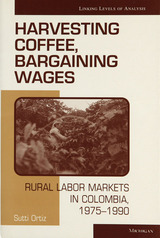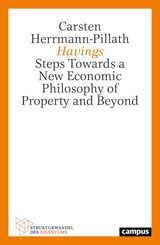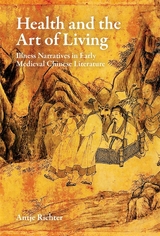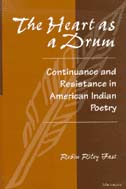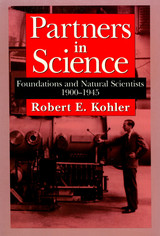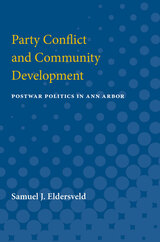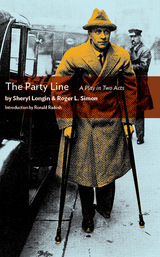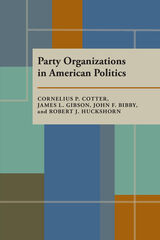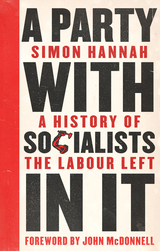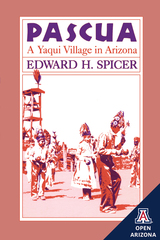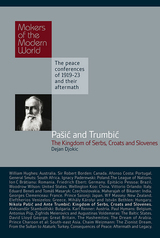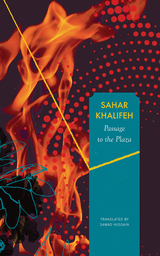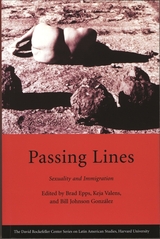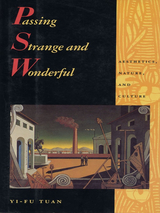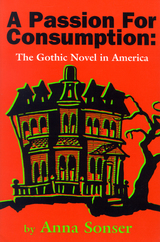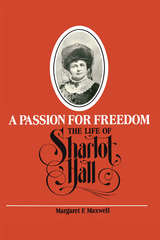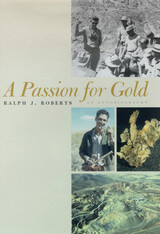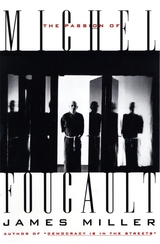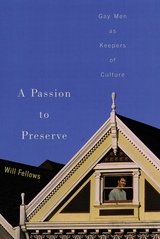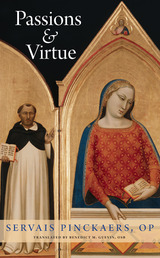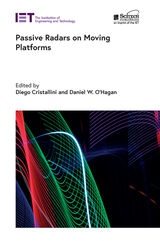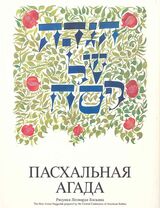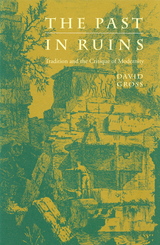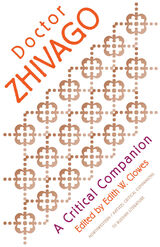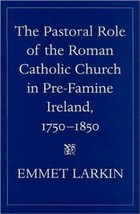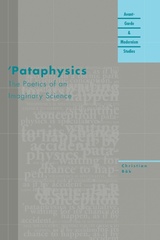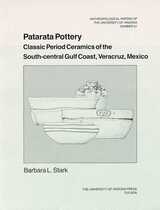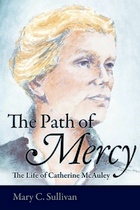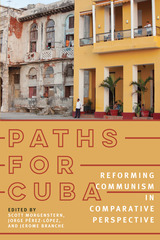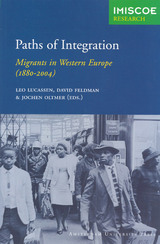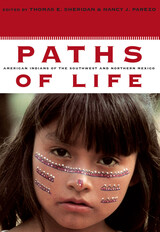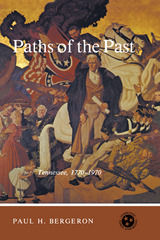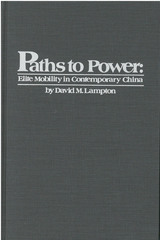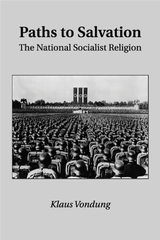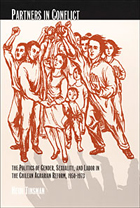 Partners in Conflict: The Politics of Gender, Sexuality, and Labor in the Chilean Agrarian Reform, 1950–1973
Heidi Tinsman
Duke University Press, 2002 Partners in Conflict examines the importance of sexuality and gender to rural labor and agrarian politics during the last days of Chile’s latifundia system of traditional landed estates and throughout the governments of Eduardo Frei and Salvador Allende. Heidi Tinsman analyzes differences between men’s and women’s participation in Chile’s Agrarian Reform movement and considers how conflicts over gender and sexuality shape the contours of working-class struggles and national politics.
Tinsman restores women to a scholarly narrative that has been almost exclusively about men, recounting the centrality of women’s labor to the pre-Agrarian Reform world of the hacienda during the 1950s and recovering women’s critical roles in union struggles and land occupations during the Agrarian Reform itself. Providing a theoretical framework for understanding why the Agrarian Reform ultimately empowered men more than women, Tinsman argues that women were marginalized not because the Agrarian Reform ignored women but because, under both the Frei and Allende governments, it promoted the male-headed household as the cornerstone of a new society. Although this emphasis on gender cooperation stressed that men should have more respect for their wives and funneled unprecedented amounts of resources into women’s hands, the reform defined men as its protagonists and affirmed their authority over women.
This is the first monographic social history of Chile’s Agrarian Reform in either English or Spanish, and the first historical work to make sexuality and gender central to the analysis of the reforms.
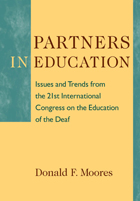 Partners in Education: Issues and Trends from the 21st International Congress on the Education of the Deaf
Donald F. Moores
Gallaudet University Press, 2011 The 21st International Congress on the Education of the Deaf (ICED) witnessed revolutionary exchanges on the vital themes in education. Presenters addressed topics encompassing seven major strands: Educational Environments, Language and Literacy, Early Intervention, Unique Challenges in Developing Countries, Educating Learners with Diverse Needs, Technology in Education, and Sign Language and Deaf Culture. These presentations and ensuing dialogues raised many complex questions. Partners in Education: Issues and Trends from the 21st International Congress on the Education of the Deaf features all of the keynote addresses by renowned luminaries in deaf education: Breda Carty, Karen Ewing, Nassozi Kiyaga, John Luckner, Connie Mayer and Beverly Trezek, volume editor Donald F. Moores, Peter V. Paul, Antti Raike, Claudine Storbeck, James Tucker, and Alys Young. Most critically, the contributors to this collection explore the many multifaceted challenges facing the world’s deaf students. Deaf children are being diagnosed with overlays of disabilities; more deaf children are growing up in poverty; and many deaf children represent minority racial/ethnic groups or are immigrants to their country of residence. The situation for deaf individuals in the most impoverished countries of the world is desperate and of crisis proportions. This volume brings these themes to light through its exceptional synthesis of the outstanding discourse that took place at ICED 2010, including abstracts from 30 celebrated conference presentations.
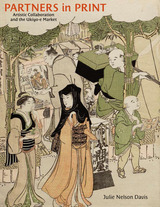 Partners in Print: Artistic Collaboration and the Ukiyo-e Market
Julie Nelson Davis
University of Hawaii Press, 2015 This compelling account of collaboration in the genre of ukiyo-e (pictures of the floating world) offers a new approach to understanding the production and reception of print culture in early modern Japan. It provides a corrective to the perception that the ukiyo-e tradition was the product of the creative talents of individual artists, revealing instead the many identities that made and disseminated printed work. Julie Nelson Davis demonstrates by way of examples from the later eighteenth century that this popular genre was the result of an exchange among publishers, designers, writers, carvers, printers, patrons, buyers, and readers. By recasting these works as examples of a network of commercial and artistic cooperation, she offers a nuanced view of the complexity of this tradition and expands our understanding of the dynamic processes of production, reception, and intention in floating world print culture.
Four case studies give evidence of what constituted modes of collaboration among artistic producers in the period. In each case Davis explores a different configuration of collaboration: that between a teacher and a student, two painters and their publishers, a designer and a publisher, and a writer and an illustrator. Each investigates a mode of partnership through a single work: a specially commissioned print, a lavishly illustrated album, a printed handscroll, and an inexpensive illustrated novel. These case studies explore the diversity of printed things in the period ranging from expensive works made for a select circle of connoisseurs to those meant to be sold at a modest price to a large audience. They take up familiar subjects from the floating world—connoisseurship, beauty, sex, and humor—and explore multiple dimensions of inquiry vital to that dynamic culture: the status of art, the evaluation of beauty, the representation of sexuality, and the tension between mind and body.
Where earlier studies of woodblock prints have tended to focus on the individual artist, Partners in Print takes the subject a major step forward to a richer picture of the creative process. Placing these works in their period context not only reveals an aesthetic network responsive to and shaped by the desires of consumers in a specific place and time, but also contributes to a larger discussion about the role of art and the place of the material text in the early modern world.
Partners in Science: Foundations and Natural Scientists, 1900-1945
Robert E. Kohler
University of Chicago Press, 1991 Robert Kohler shows exactly how entrepreneurial academic scientists became intimate "partners in science" with the officers of the large foundations created by John D. Rockefeller and Andrew Carnegie, and in so doing tells a fascinating story of how the modern system of grant-getting and grant-giving evolved, and how this funding process has changed the way laboratory scientists make their careers and do their work.
"This book is a rich historical tapestry of people, institutions and scientific ideas. It will stand for a long time as a source of precise and detailed information about an important aspect of the scientific enterprise. . .It also contains many valuable lessons for the coming years."—John Ziman, Times Higher Education Supplement
 Partners in Science: Letters of James Watt and Joseph Black
James Watt and Joseph Black
Harvard University Press ,The scientific correspondence of Watt, Black, Robison and others, together with James Watt's notebook of experiments on heat, edited by Eric Robinson and Douglas McKie.,
, The close friendship that grew up between Dr. Joseph Black, the,discoverer of specific and latent heats, and James Watt, the scientific instrument maker who was destined to become perhaps the greatest engineer of all time, is in,itself a dramatic relationship, not before fully appreciated, Here for the first time is the full text of all their surviving correspondence, known only fragmentarily before in J. P. Muirhead's Life and Mechanical Inventions of James Watt, and there rather freely amended by the editor.,
The amazing range of Watt's interests--in the firing of delft and stoneware, the manufacture of alkali from salt, the invention of scientific instruments as well as the copying press, and many other matters beside the steam-engine--is revealed here. Watt's own position as a scientist and the quality of his association with Black in further experiments on latent heat are fully documented. But the,correspondence is also valuable for the light it sheds on many aspects of life in Britain in the later half of the eighteenth century.
In addition, Watt's notebook on his experiments on heat, known before only through quotation, is presented complete. This is a primary source of first-rate importance to the historian of science.
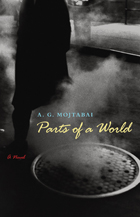 Parts of a World: A Novel
A. G. Mojtabai
Northwestern University Press, 2011 Two decades into his career, Tom Limbeck, a New York City social worker, is leading an orderly, utterly prosaic life. He is, by self-description, “a poor man’s psychiatrist,” dedicated to helping his clients see things rationally, the better to confront the real world. He works in an office beset by budgetary difficulties and driven to solutions suited only to the bureaucracy.
Tom’s life changes when he takes on the case of Michael, who is known as “Saint Francis of the Dumpster” for his peaceful disposition and practice of eating from garbage cans. Tom is at first haunted by, then obsessed with, this uncommunicative young man who holds a precious secret which causes him to risk his survival by living on the street. Tom is determined to discover and expose Michael’s secret (“his faith/his delusion”) as a necessary first step before any treatment can begin. Tom cannot reason his way out of his own obsession when he finds himself bending the rules, abandoning therapeutic norms and, before long, stalking his client. Parts of a World is a book about doubt—doubt, faith, and delusion.
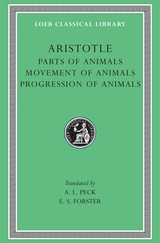 Parts of Animals. Movement of Animals. Progression of Animals
Aristotle
Harvard University Press Inductive zoology.
Aristotle, great Greek philosopher, researcher, reasoner, and writer, born at Stagirus in 384 BC, was the son of a physician. He studied under Plato at Athens and taught there (367–347); subsequently he spent three years at the court of a former pupil in Asia Minor. After some time at Mitylene, in 343–342 he was appointed by King Philip of Macedon to be tutor of his teen-aged son Alexander. After Philip’s death in 336, Aristotle became head of his own school (of “Peripatetics”), the Lyceum at Athens. Because of anti-Macedonian feeling there after Alexander’s death in 323, he withdrew to Chalcis in Euboea, where he died in 322.
Nearly all the works Aristotle prepared for publication are lost; the priceless ones extant are lecture-materials, notes, and memoranda (some are spurious). They can be categorized as follows:
I Practical: Nicomachean Ethics; Great Ethics (Magna Moralia); Eudemian Ethics; Politics; Economics (on the good of the family); On Virtues and Vices.
II Logical: Categories; Analytics (Prior and Posterior); Interpretation; Refutations used by Sophists; Topica.
III Physical: Twenty-six works (some suspect) including astronomy, generation and destruction, the senses, memory, sleep, dreams, life, facts about animals, etc.
IV Metaphysics: on being as being.
V Art: Rhetoric and Poetics.
VI Other works including the Constitution of Athens; more works also of doubtful authorship.
VII Fragments of various works such as dialogues on philosophy and literature; and of treatises on rhetoric, politics, and metaphysics.
The Loeb Classical Library edition of Aristotle is in twenty-three volumes.
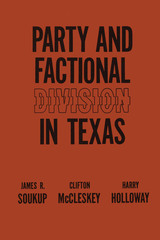 Party and Factional Division in Texas
By James R. Soukup, Clifton McCleskey, and Harry Holloway
University of Texas Press, 1964 Here is the first attempt by scholars to make a comprehensive analysis of voting patterns in Texas. Examining the results of fourteen elections from 1946 through 1962 and organizing a vast fund of statistics relative to Texas political parties and voters, the authors have laid a solid groundwork for further studies in this field. The previously ineffectual Texas Republican Party made great strides in the twentieth century and became a competitor in state as well as national races. Specifically, the authors maintain that Texas in the 1960s was a “one and two-thirds party state.” Within the Democratic Party, factions analogous to warring camps immensely complicated the political struggle. Although the conservative elements within the Democratic Party still had a slight edge, growing liberal strength forced them to moderate their policies and tactics. The authors also contend that there were significant changes in the nature of the issues and the modes of political operation. Though some of the old motivations and tactics lingered on in less significant rural areas, friendship-oriented campaigns appealing to regional and family-like sentiments were being quickly replaced by an organized politics in which political activists made strong ideological appeals to economic and social interests. The Republicans, the conservative Democrats, and the liberal Democrats are each analyzed in relation to regionalism, demography, ethnic elements, and the economic system in Texas; and the history, present status, and future prospects of these factions are discussed in detail. Of special interest are the last two chapters, which analyze the 1962 elections and their bearings on evolving patterns of competition. The developments within the Republican Party and its challenge to the traditional Democratic Party are seen in the perspectives of the growing importance of minority groups and the impact of urbanization. All those interested in Texas politics and the history of the rise of the Republican Party in the state will find this study indispensable for an intelligent appraisal of historical developments.
 Party Campaigning in the 1980s
Paul S. Herrnson
Harvard University Press, 1988 Are American political parties on the way out? Political action committees (PACs) currently compete with parties for influence over candidates and voters; persuading a more independent and volatile electorate requires new tactics; technological innovations afford more sophisticated means to appeal for support. Many political observers express doubts about the ability of political parties to adapt to these changes and to survive, but Paul Herrnson instead suggests their survival and resurgence in this balanced assessment of party activities in congressional elections.
Drawing on extensive interviews and survey data collected from nearly five hundred recent House and Senate candidates, campaign advisers, party officials, PAC executives, and journalists, Herrnson evaluates the roles of the national parties. He finds that from the perspective of party executives, they provide important campaign services and function as the key brokers between candidates, PACs, and other campaigners. For PAC officials, the national parties serve as important sources of strategic campaign information and cues for decision-making. For the candidates themselves, their parties function as appendages and accessories to their own campaign organizations.
Herrnson provides rich detail on party development and party campaign activity to predict the future of congressional elections and of the party-in-government and the party-in-the-electorate. Political practitioners as well as scholars will welcome this fresh, new contribution to a significant political controversy.
Party Colonisation of the Media in Central and Eastern Europe
Péter Bajomi-Lázár
Central European University Press, 2014 This book compares media and political systems in East-Central as well as in Western Europe in order to identify the reasons possibly responsible for the extensive and intensive party control over the media. This phenomenon is widely experienced in many of the former communist countries since the political transformation. The author argues that differences in media freedom and in the politicization of the news media are rooted in differences in party structures between old and new democracies, and, notably, the fact that young parties in the new members of the European Union are short of resources, which makes them more likely to take control of and to exploit media resources.
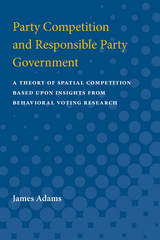 Party Competition and Responsible Party Government: A Theory of Spatial Competition Based Upon Insights from Behavioral Voting Research
James Adams
University of Michigan Press, 2001 In countries with multiparty political systems, we assume--if the system is going to work--that parties have relatively stable positions on policy, that these positions diverge, and that voters make choices based on policy preferences. Yet much of the research on voter behavior and party competition does not support these assumptions.
In Party Competition, James Adams applies the insights of behavioral research to an examination of the policy strategies that political parties (and candidates) employ in seeking election. He argues that vote-seeking parties are motivated to present policies that appeal to voters, whose bias toward these policies is based in part on reasons that have nothing to do with policy. He demonstrates that this strategic logic has profound implications for party competition and responsible party government.
Adams's innovative fusion of research methodologies presents solutions to issues of policy stability and voter partisanship. His theory's supported by an in-depth analysis of empirical applications to party competition in Britain, France, and the United States in the postwar years.
Party Competition and Responsible Party Government will appeal to readers interested in the study of political parties, voting behavior and elections, as well as to scholars specializing in French, British, and American politics.
James Adams is Assistant Professor of Political Science, University of California, Santa Barbara.
Party Conflict & Community Development: Postwar Politics in Ann Arbor
Samuel J. Eldersveld
University of Michigan Press, 1995 Through an in-depth study of Ann Arbor politics, Party Conflict and Community Development addresses fundamental questions of the relationship between partisan politics and municipal government. Since a large majority of middle-sized American cities operate with nonpartisan government, Ann Arbor's fiercely competitive, two-party system provides an essential counterpoint to other urban studies. Moreover, political activity at this local level gives unique insight into the relative strength and performance of American political parties. Samuel J. Eldersveld examines in detail how this increasingly competitive system has led to innovative policy change. Finally, he offers comparisons to other American and European cities.
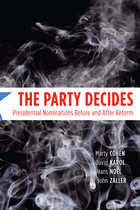 The Party Decides: Presidential Nominations Before and After Reform
Marty Cohen, David Karol, Hans Noel, and John Zaller
University of Chicago Press, 2008 Throughout the contest for the 2008 Democratic presidential nomination, politicians and voters alike worried that the outcome might depend on the preferences of unelected superdelegates. This concern threw into relief the prevailing notion that—such unusually competitive cases notwithstanding—people, rather than parties, should and do control presidential nominations. But for the past several decades, The Party Decides shows, unelected insiders in both major parties have effectively selected candidates long before citizens reached the ballot box.
Tracing the evolution of presidential nominations since the 1790s, this volume demonstrates how party insiders have sought since America’s founding to control nominations as a means of getting what they want from government. Contrary to the common view that the party reforms of the 1970s gave voters more power, the authors contend that the most consequential contests remain the candidates’ fights for prominent endorsements and the support of various interest groups and state party leaders. These invisible primaries produce frontrunners long before most voters start paying attention, profoundly influencing final election outcomes and investing parties with far more nominating power than is generally recognized.
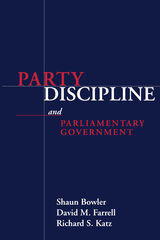 PARTY DISCIPLINE AND PARLIAMENTARY GOVERNMENT
SHAUN BOWLER
Ohio State University Press, 1999 Parliamentary government is generally taken to mean party government. Party cohesion and discipline are usually seen as central to the maintenance of parliamentary democracy. This overlap, between disciplined parties on the one hand and parliamentary government on the other, is often seen as so complete and so automatic that the question of party discipline is pushed to the sidelines and rarely studied. Yet, if individual legislators remain an undisciplined mob, parliaments could easily become unruly and anarchical. How and why party discipline arises and is maintained are thus central questions of importance in legislative, and especially parliamentary, studies. Our knowledge of these topics, however, suffers from substantial gaps, especially with regard to the practice of party cohesion outside the relatively familiar Anglo-American setting. This book marks a step toward filling some of those gaps. The collection of essays presented here provides theoretical background and comparative studies of legislatures in a wide range of settings. Well-developed democracies such as Britain, Finland, Ireland, Italy, The Netherlands, Norway, and Switzerland are covered, as are the more recent democracies of Spain and Hungary, and the unique case of the transnational European Parliament.
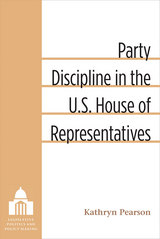 Party Discipline in the U.S. House of Representatives
Kathryn Pearson
University of Michigan Press, 2015 Political party leaders in the U.S. House of Representatives command greater loyalty than ever from fellow party members in roll call votes, campaign contributions, and partisan speeches. In return, leaders reward compliant members with opportunities to promote constituent interests and to advance their own political careers. Denial of such privileges as retribution against those who don’t fully support the party agenda may significantly damage a member’s prospects. Kathryn Pearson examines the disciplinary measures that party leaders in the U.S. House of Representatives employ to exact such loyalty, as well as the consequences for a democratic legislature. Drawing upon data from 1987–2010, Pearson identifies the conditions under which party leaders opt to prioritize policy control and those which induce them to prioritize majority control. She then assesses the ways in which these choices affect, on one hand, the party’s ability to achieve its goals, and on the other hand, rank-and-file members’ ability to represent their constituents. Astute party leaders recognize the need for balance, as voters could oust representatives who repeatedly support the party’s agenda over their constituents’ concerns, thereby jeopardizing the number of seats their party holds. In her conclusion, Pearson discusses the consequences of party discipline such as legislative gridlock, stalled bills, and proposals banned from the agenda. Although party discipline is likely to remain strong as citizens become more cognizant of enforced party loyalty, their increasing dissatisfaction with Congress may spur change.
Party Girls
Diane Goodman
Autumn House Press, 2011 Goodman explores class, community, and culture through the lens of a party.
The Party Line: A Full-Length Play
Roger L Simon
St. Augustine's Press, 2013 THE PARTY LINE is a historical drama. Using real and fictional characters, it intermingles the story of Walter Duranty – the New York Times’ Pulitzer Prize-winning Moscow correspondent in the 1930s – with the more contemporary story of Dutch politician Pim Fortuyn who was assassinated in 2002, on the eve of becoming prime minister. Sheryl Longin and Roger L. Simon have accomplished a breathtaking feat in their imaginative and topical play, The Party Line. The title, as students of Communism know, refers to one’s adherence to the current position on an issue as outlined by the Communist Party in its heyday. . . .
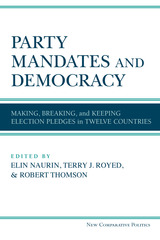 Party Mandates and Democracy: Making, Breaking, and Keeping Election Pledges in Twelve Countries
Elin Naurin, Terry J. Royed, and Robert Thomson, Editors
University of Michigan Press, 2019 When people discuss politics, they often mention the promises politicians make during election campaigns. Promises raise hopes that positive policy changes are possible, but people are generally skeptical of these promises. Party Mandates and Democracy reveals the extent to and conditions under which governments fulfill party promises during election campaigns. Contrary to conventional wisdom a majority of pledges—sometimes a large majority—are acted upon in most countries, most of the time.
The fulfillment of parties’ election pledges is an essential part of the democratic process. This book is the first major, genuinely comparative study of promises across a broad range of countries and elections, including the United States, Canada, nine Western European countries, and Bulgaria. The book thus adds to the body of literature on the variety of outcomes stemming from alternative democratic institutions.
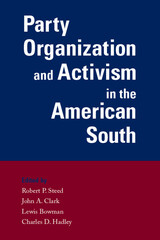 Party Organization and Activism in the American South
Robert P. Steed
University of Alabama Press, 1998 Maps the ways political parties remain vital components in the American political system, especially in the eleven states in the South
As Tocqueville noted more than 100 years ago, “No countries need associations more . . . than those with a democratic social state.” Although some contemporary observers see a decline in associations, especially in the political sphere, the contributors in this volume argue not only that political parties remain an essential component of the American political system but also that grassroots political groups have revitalized the political process, especially in the South.
Using data gathered from local party officials in the eleven southern states, the authors examine such key issues as: Who becomes involved in local party organizations and why? How do parties recruit and retain workers? What are the ideological and issue orientations of these activists? How does intraparty factionalism affect local party organizations? What is the connection between the party organization and its external environment?
The large regional database provides these contributors with the opportunity to extend the study of local party organization and activists, thus addressing some of the significant gaps in previous research. The additional data enable them to clarify the nature of local party organizations and, in a larger sense, the role of the parties in the contemporary American political system.
Party Organizations in American Politics
Cornelius P. Cotter
University of Pittsburgh Press, 1989
Contradicting the conventional political wisdom of the 1970s, which said state political parties were dormant and verging upon extinction, this book reveals that state party organizations actually grew stronger in the 1960s and 1970s.
Reprinted with a new preface that covers changes in the 1980s in electoral politics, Party Organizations in American Politics encourages a reappraisal of scholarly treatment of party organization in political science.
A Party with Socialists in It: A History of the Labour Left
Simon Hannah
Pluto Press, 2018 For more than a hundred years, the British Labour Party has been the home of working-class organization and struggle. But has it ever truly been on the side of workers? Where do its interests really lie, and can it be relied on to provide a check on right-wing forces?
A Party with Socialists in It addresses those questions and more, telling the story of the Labour Party from its origins to today, showing how at every turn it has struggled with the tension between the rights and demands of workers and a more centrist position. As Jeremy Corbyn’s leadership attempts to revitalize the party after the initial success of the Blair years turned into disappointment and disenchantment, this clear-eyed history could not be more timely.
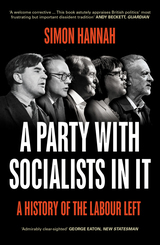 A Party with Socialists in It: A History of the Labour Left
Simon
Pluto Press, 2022 A smart and succinct history of the Labour left
*A Guardian Book of the Day*
The defeat of socialist firebrand Jeremy Corbyn as Labour Leader in 2019 confirmed Tony Benn's famous retort 'the Labour party has never been a socialist party, although there have always been socialists in it.'
For over a hundred years, the British Labour Party has been a bastion for working-class organization and struggle. However, has it ever truly been on the side of the workers? Where do its interests really lie? And can we rely on it to provide a barrier against right-wing forces?
Simon Hannah's smart and succinct history of the Labour left guides us through the twists and turns of the party, from the Bevanite movement and the celebrated government of Clement Attlee, through the emergence of a New Left in the 1970s and the Blairism of the 1990s, to Corbyn's defeat and his replacement by Keir Starmer.
This new edition is updated throughout, with a new final chapter and conclusion bringing the story up to date.
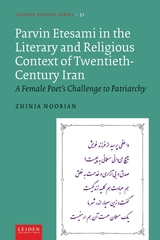 Parvin Etesami in the Literary and Religious Context of Twentieth-Century Iran: A Female Poet’s Challenge to Patriarchy
Zhinia Noorian
Leiden University Press, 2023 Parvin E’tesami (1907-1941) is among the few Persian female poets, who has gained nationwide popularity, while her authorship was disbelieved. She is celebrated in a plethora of publications every year in Iran and beyond. E’tesami is the only female poet who has remained part of the daily lives of people in her society for about a century. Her poetry appears in school curricula both before and after the Revolution of 1979. People use her poetry on social media, particularly in critical times. It is also used in public speeches by Ali Khamenei (r. 1989-present) the supreme leader of the Islamic Republic. This book engages with E’tesami in the transformational context of the early twentieth century in Iran to investigate the controversies around her identity as a popular female poet. It demonstrates that the reason for E’tesami’s paradoxical popularity was not merely her gender, but the transgression of patriarchal Iranian-Muslim gender norms.
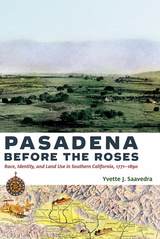 Pasadena Before the Roses: Race, Identity, and Land Use in Southern California, 1771–1890
Yvette J. Saavedra
University of Arizona Press, 2018 Incorporated in 1886 by midwestern settlers known as the Indiana Colony, the City of Pasadena has grown into a world-famous tourist destination recognized for the beauty of its Tournament of Roses Parade, the excitement of the annual Rose Bowl, and the charm of the Old Town District.
But what existed before the roses? Before it was Pasadena, this land was Hahamog’na, the ancestral lands of the Tongva people. Later, it comprised the heart of the San Gabriel Mission lands, and in the Mexican period, it became Rancho San Pascual. The 1771 Spanish conquest of this land set in motion several colonial processes that would continue into the twentieth century and beyond.
In Pasadena Before the Roses, historian Yvette J. Saavedra examines a period of 120 years to illustrate the interconnectedness of power, ideas of land use, and the negotiation of identity within multiple colonial moments. By centering the San Gabriel Mission lands as the region’s economic, social, and cultural foundation, she shows how Indigenous, Spanish, Mexican, and American groups each have redefined the meanings of land use to build their homes and their lives. These visions have resulted in competing colonialisms that framed the racial, ethnic, gender, and class hierarchies of their respective societies.
 Pascal: Adversary and Advocate
Robert J. Nelson
Harvard University Press, 1981 The life of the paradoxical seventeenth-century philosopher and mathematician is examined here along three axes—psychological, theological, and linguistic—to present the first rounded portrayal of the querulous, intense, ever-committed Pascal. In drawing this portrait, the author restores Pascal to the general reader after twenty years of scholarship that has embroiled this historic thinker in academic quarrels.
Robert Nelson confronts the contradictions in Pascal’s life and personality: intensely religious according to the demands of his time, yet simultaneously committed to rigorous scientific inquiry, no matter where it led; fascinated by rebellion, yet deeply dependent on the authority of father, spiritual adviser, church, and science. Mr. Nelson sees the resolution of these personal dilemmas in Pascal’s growing interest in language—the essential relation between word and object, signifier and signified, which form a style of “Pascalian linguistics” different from those of Descartes or Port Royal.
Through the scrutiny of Pascal’s biography and analysis of the entire body of his writing, Nelson reveals Pascal the man, the scientist, the theologian, and the literary genius.
 Pascal Programming for Music Research
Alexander R. Brinkman
University of Chicago Press, 1990 Pascal Programming for Music Research addresses those who wish to develop the programming skills necessary for doing computer-assisted music research, particularly in the fields of music theory and musicology. Many of the programming techniques are also applicable to computer assisted instruction (CAI), composition, and music synthesis. The programs and techniques can be implemented on personal computers or larger computer systems using standard Pascal compilers and will be valuable to anyone in the humanities creating data bases.
Among its useful features are:
-complete programs, from simple illustrations to substantial applications;
-beginning programming through such advanced topics as linked data structures, recursive algorithms, DARMS translation, score processing;
-bibliographic references at the end of each chapter to pertinent sources in music theory, computer science, and computer applications in music;
-exercises which explore and extend topics discussed in the text;
-appendices which include a DARMS translator and a library of procedures for building and manipulating a linked representation of scores;
-most algorithms and techniques that are given in Pascal programming translate easily to other computer languages.
Beginning, as well as advanced, programmers and anyone interested in programming music applications will find this book to be an invaluable resource.
Pascua: A Yaqui Village in Arizona
Edward H. Spicer
University of Arizona Press The Yaqui of Mexico were early converts to Christianity in New Spain. Yet they came to be regarded with hostility by the newly emerging Mexican government. Many Yaquis fled Mexico in the early twentieth century and established a settlement in Arizona where they resumed a peaceful existence centered around their ceremonial calendar.
Edward Spicer devoted most of his professional career to the study of the Yaquis and came to be regarded as a leading authority on that tribe. At the inception of his forty years of research stands Pascua, a firsthand description of daily village life.
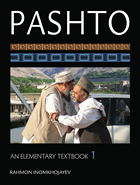 Pashto: An Elementary Textbook, Volume 1
Rahmon Inomkhojayev
Georgetown University Press, 2011 eTextbooks are now available to purchase or rent through VitalSource.com! Please visit VitalSource for more information on pricing and availability. Pashto, designated a critical language by the US Department of Defense, is one of two official languages of Afghanistan and is also spoken in parts of Pakistan. Volume 1 of Pashto: An Elementary Textbook is designed to cover one semester of beginning-level language instruction; together, Volumes 1 and 2 of Pashto cover one year of instruction. The textbook provides learners and instructors with a wide selection of task-oriented, communicative language materials to facilitate the development of language learning. It features a functional approach to grammar, an emphasis on integrated skills development, and the use of authentic materials. The activities provided in the textbook will help learners to develop strong skills in speaking, listening, reading, and writing. In addition to the cultural background embedded in the video materials, the textbook contains cultural notes that improve competency. Volumes 1 and 2 of Pashto: An Elementary Textbook each include:
• Authentic audio and video materials to accompany the text, available on the Press website
• Extensive Pashto–English and English–Pashto glossaries
• Material for teaching the Arabic-based Pashto alphabet
• Color illustrations and photographs throughout Topics covered
Volume 1 (first semester): The Pashto alphabet, writing, reading, pronunciation, greetings and introductions, university life, daily activities, in the city, and family Volume 2 (second semester): Seasons, weather, holidays, health, food, sport, and shopping For Instructors: Exam copies of the textbook are available free of charge to instructors and can be ordered on this page. To request a print sample, please use the "print" exam copy button. Instructors may request a digital sample by logging into VitalSource.com, selecting "Faculty Sampling" in the upper right-hand corner, and selecting the desired product.
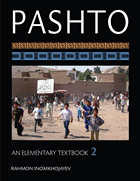 Pashto: An Elementary Textbook, Volume 2
Rahmon Inomkhojayev
Georgetown University Press, 2011 eTextbooks are now available to purchase or rent through VitalSource.com! Please visit VitalSource for more information on pricing and availability. Pashto, designated a critical language by the US Department of Defense, is one of two official languages of Afghanistan and is also spoken in parts of Pakistan. Volume 2 of Pashto: An Elementary Textbook is designed to cover the second semester of beginning-level language instruction; together, Volumes 1 and 2 of Pashto cover one year of instruction. The textbook provides learners and instructors with a wide selection of task-oriented, communicative language materials to facilitate the development of language learning. It features a functional approach to grammar, an emphasis on integrated skills development, and the use of authentic materials. The activities provided in the textbook will help learners to develop strong skills in speaking, listening, reading, and writing. In addition to the cultural background embedded in the video materials, the textbook contains cultural notes that improve competency. Volumes 1 and 2 of Pashto: An Elementary Textbook each include:
• a CD-ROM featuring authentic audio and video materials to accompany the text
• extensive Pashto–English and English–Pashto glossaries
• material for teaching the Arabic-based Pashto alphabet
• color illustrations and photographs throughout Topics covered
Volume 1 (first semester): The Pashto alphabet, writing, reading, pronunciation, greetings and introductions, university life, daily activities, in the city, and family Volume 2 (second semester): Seasons, weather, holidays, health, food, sport, and shopping For Instructors: Exam copies of the textbook are available free of charge to instructors and can be ordered on this page. To request a print sample, please use the "print" exam copy button. To request a digital sample, instructors should log onto VitalSource.com, select "Faculty Sampling" in the upper right-hand corner, and select the desired product.
 Pashto: An Intermediate Textbook
Rahmon Inomkhojayev
Georgetown University Press, 2016 Designated a critical language by the US Department of Defense, Pashto is one of the two official languages of Afghanistan and is commonly spoken in parts of Pakistan. This intermediate-level textbook, which follows Pashto: An Elementary Textbook, Volumes 1 and 2, is designed to bring students from high-introductory to intermediate proficiency. It offers students with basic knowledge of Pashto a thematically organized approach that develops strong speaking, listening, reading, and writing skills in the language used in everyday life and in official communications, the mass media, and the educational system of Afghanistan. Utilizing current innovations in foreign language teaching, Pashto: An Intermediate Textbook is an invaluable resource for professionals and students wishing to improve their proficiency in this critical language. Features of Pashto: An Intermediate Textbook:
• More than a hundred audio files, available to stream on the Press website. Vocabulary lists allow readers to hover over a written word or phrase and hear it in both eastern and western dialects.
• Carefully selected themes, including practical situations in survival and rich descriptions of the Pashtun code of honor and wedding customs, in order to help students learn the language within its cultural context.
• Grammar points that help students quickly master the essential function of the structural elements used in the texts.
• Pashto-English and English-Pashto glossaries that provide information regarding the gender and number of nouns, adjectives, and various forms of verbs.
• Attractive four-color, user-friendly design with integrated audio and written exercises and cultural notes to provide students with necessary background.
Pasic & Trumbic: The Kingdom of Serbs, Croats and Slovenes
Dejan Djokic
Haus Publishing, 2010 Nicola Pasic and Ante Trumbic: The book will provide the first parallel biographies of two key Yugoslav politicians of the early 20th century: Nikola Pasic, a Serb, and Ante Trumbic, a Croat. It will also offer a brief history of the creation of Yugoslavia (initially known as the Kingdom of Serbs, Croats, and Slovenes), internationally accepted at the Paris Peace Conference of 1919-20 (at the Treaty of Versailles). Such an approach will fill two major gaps in the literature - scholarly biographies of Pasic and Trumbic are lacking, while Yugoslavia's formation is due a reassessment - and to introduce the reader to the central question of South Slav politics: Serb-Croat relations. Pasic and Trumbic's political careers and their often troubled relationship in many ways perfectly epitomize the wider Serb-Croat question.
 Pasolini Requiem: Second Edition
Barth David Schwartz
University of Chicago Press, 2017 Pier Paolo Pasolini (1922–75) was one of the most important Italian intellectuals of the post–World War II era. An astonishing polymath—poet, novelist, literary critic, political polemicist, screenwriter, and film director—he exerted profound influence on Italian culture up to his untimely death at the age of fifty-three. This revised edition of what the New York Times Book Review has called “the standard Pasolini biography” introduces the artist to a new generation of readers.
Based on extensive interviews with those who knew Pasolini, both friends and enemies, admirers and detractors, Pasolini Requiem chronicles his growth from poet in the provinces to Italy’s leading “civil poet”; his flight to Rome in 1950; the scandalous success of his two novels and political writing; and his transition to film, where he started as a contributor to the golden age of Italian cinema and ended with the shocking Salò, or the 120 Days of Sodom. Pasolini’s tragic and still unsolved murder has remained a subject of contentious debate for four decades. The enduring fascination with who committed the crime—and why—reflects his vital stature in Italy’s political and social history.
Updated throughout and with a new afterword covering the efforts to reopen the investigation—and the legal maelstrom surrounding Pasolini’s demise—this edition of Pasolini Requiem is a riveting account of one of the twentieth century’s most controversial, ever-present iconoclasts.
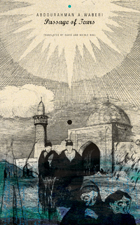 Passage of Tears
Abdourahman A. Waberi
Seagull Books, 2011 Djibouti, a hot, impoverished little country on the Horn of Africa, is a place of great strategic importance, for off its coast lies a crucial passage for the world’s oil. In this novel by Abdourahman A. Waberi, Djibril, a young Djiboutian voluntarily exiled in Montreal, returns to his native land to prepare a report for an American economic intelligence firm. Meanwhile, a shadowy, threatening figure imprisoned in an island cell seems to know Djibril’s every move. He takes dictation from his preaching cellmate known as his “Venerable Master,” but as the words are put on the page, a completely different text appears—the life of Walter Benjamin, Djibril’s favorite author. Passage of Tears cleverly mixes many genres and forms of writing—spy novel, political thriller, diary (replete with childhood memories), travel notebook, legends, parables, incantations, and prayers. Djibril’s reminiscences provide a sense of Djibouti’s past and its people, while a satire of Muslim fundamentalism is unwittingly delivered through the other Djiboutian voice. Waberi’s inventive parody is a lesson in tolerance, while his poetic observations reveal his love and concern for his homeland. Praise for the French Edition “Disguised as a political thriller, Passage of Tears is above all a great novel of childhood, murderous identities, and exile.”—Le Monde des Livres “A gripping book, burning with urgency and tension.”—Télérama.
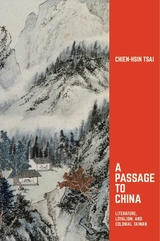 A Passage to China: Literature, Loyalism, and Colonial Taiwan
Chien-hsin Tsai
Harvard University Press, 2017 This book, the first of its kind in English, examines the reinvention of loyalism in colonial Taiwan through the lens of literature. It analyzes the ways in which writers from colonial Taiwan—including Qiu Fengjia, Lian Heng, Wu Zhuoliu, and others—creatively and selectively employed loyalist ideals to cope with Japanese colonialism and its many institutional changes. In the process, these writers redefined their relationship with China and Chinese culture.
Drawing attention to select authors’ lesser-known works, author Chien-hsin Tsai provides a new assessment of well-studied historical and literary materials and a nuanced overview of literary and cultural productions in colonial Taiwan. During and after Japanese colonialism, the islanders’ perception of loyalism, sense of belonging, and self-identity dramatically changed. Tsai argues that the changing tradition of loyalism unexpectedly complicates Taiwan’s tie to China, rather than unquestionably reinforces it, and presents a new line of inquiry for future studies of modern Chinese and Sinophone literature.
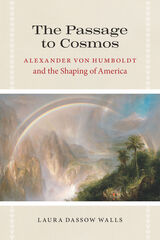 The Passage to Cosmos: Alexander von Humboldt and the Shaping of America
Laura Dassow Walls
University of Chicago Press, 2009 Explorer, scientist, writer, and humanist, Alexander von Humboldt was the most famous intellectual of the age that began with Napoleon and ended with Darwin. With Cosmos, the book that crowned his career, Humboldt offered to the world his vision of humans and nature as integrated halves of a single whole. In it, Humboldt espoused the idea that, while the universe of nature exists apart from human purpose, its beauty and order, the very idea of the whole it composes, are human achievements: cosmos comes into being in the dance of world and mind, subject and object, science and poetry. Humboldt’s science laid the foundations for ecology and inspired the theories of his most important scientific disciple, Charles Darwin. In the United States, his ideas shaped the work of Emerson, Thoreau, Poe, and Whitman. They helped spark the American environmental movement through followers like John Muir and George Perkins Marsh. And they even bolstered efforts to free the slaves and honor the rights of Indians. Laura Dassow Walls here traces Humboldt’s ideas for Cosmos to his 1799 journey to the Americas, where he first experienced the diversity of nature and of the world’s peoples—and envisioned a new cosmopolitanism that would link ideas, disciplines, and nations into a global web of knowledge and cultures. In reclaiming Humboldt’s transcultural and transdisciplinary project, Walls situates America in a lively and contested field of ideas, actions, and interests, and reaches beyond to a new worldview that integrates the natural and social sciences, the arts, and the humanities. To the end of his life, Humboldt called himself “half an American,” but ironically his legacy has largely faded in the United States. The Passage to Cosmos will reintroduce this seminal thinker to a new audience and return America to its rightful place in the story of his life, work, and enduring legacy.
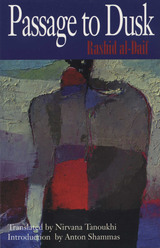 Passage to Dusk
By Rashid al-Daif
University of Texas Press, 2001 Passage to Dusk deals with the Lebanese civil war of the 1970s in a postmodern, poetic style. The narrative focuses on the deranged, destabilized, confused, and hyper-perceptive state of mind created by living on the scene through a lengthy war. The story is filled with details that transcend the willed narcissism of the main character, while giving clues to the culture of the time. It is excellent fiction, written in a surrealistic mode, but faithful to the characters of the people of Lebanon, their behavior during the war, and their contradictions. Issues of gender and identity are acutely portrayed against Lebanon's shifting national landscape. The English-language reader has not been much exposed to Lebanese literature in translation, and Rashid al-Daif is one of Lebanon's leading writers. He has been translated into eight languages, including French, German, Italian, Polish, and Spanish. Translator Nirvana Tanoukhi manages to preserve Daif's unusual, moving, and at times humorous style in her English rendition.
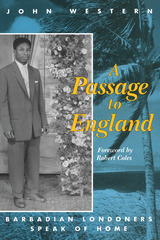 Passage To England: Barbadian Londoners Speak of Home
John Western
University of Minnesota Press, 1992 Since World War II London has become a significantly multiracial city. Some of the earliest agents of its transformation were young men and women recruited in the late 1950s from Barbados, then a British colony, to work in the metropolis’s nationalized public transportation system and in its hospitals. These Barbadians met, married, settled in London, and raised Londoner children. In 1987-88 John Western conducted a series of interviews with twelve such families--both parents and children. Their vivid words fill A Passage to England with insight, human, and, often, poignancy. Here is a rich perspective on thirty years or more of London social history. Western structured the interviews to allow the Barbadians a lot of freedom to discuss whatever came to mind concerning either their own life histories and achievements, or wider themes of culture, politics, and society. Topics covered range from matters of “race” to Margaret Thatcher and the change her decade in power has wrought in Britain. One development, for example, is the strikingly entrepreneurial spirit now embraced by some of the young British blacks, veritably “Mrs. Thatcher’s Children.” Ultimately, many of the interviewees focused on the changes they see in their ancestral island in the Caribbean, to which all of them have returned for visits. For this migrant generation especially, as the prospect of retirement begins to grow increasingly important, inevitable questions regard the definitions of “home” and “belonging” must be confronted: Does one stay in London--with one’s children and grandchildren--or does one return to Barbados, which for many seems no longer the same island as the one they left a working lifetime ago? Within the context of an ever-increasing complement of geographically mobile people worldwide, Western’s study provides unique insights into the particular ambiguities a particular set of person have wrestled with at a particular moment in history...but the import of the Barbadian Londoners’ story is universal.
 Passage to Power: K’ang-hsi and His Heir Apparent, 1661–1722
Silas H. L. Wu
Harvard University Press, 1979 With admirable lucidity and scrupulous attention to detail, Silas Wu recreates the conflict and intrigue that marked the struggle for succession to the throne of China during the reign of Emperor K’ang-hsi. This crisis, as Wu portrays it, stemmed from irreconcilable familial commitments and imperial responsibilities. K’ang-hsi, frequently compared to his contemporaries Louis XIV and Peter the Great, is depicted here as a psychologically complex individual with bewildering inconsistencies in his behavior. His fears and doubts persistently confounded his ministers, impeding the effectiveness of his rule. Yin-jeng, his talented and promising son, had been hand-picked to succeed from infancy, but steadily degenerated into cruelty, immorality, and madness, becoming totally unfit to be the heir to the throne of the Chinese empire.
The story is told against the complex background of the K’ang-hsi era with specific delineations of the chief personalities concerned. This multifaceted approach enables Wu to link political events of the time to the conflicting desires and passions of father and son. His careful investigation of the cultural concept of filial piety and its profound influence on K’ang-hsi enables him to unravel the latter’s paradoxical behavior, both private and public. Even the subtle effects of contemporary social changes on the court at Peking come to light through Wu’s comprehensive analysis.
Wu has utilized nearly every document available on the subject including letters, diaries, intelligence reports, and K’ang-hsi’s secret correspondence with court officials. The result is an unusual book that unites history and psychology.
Passage to the Plaza
Sahar Khalifeh
Seagull Books, 2020 In Bab Al-Saha, a quarter of Nablus, Palestine, sits a house of ill repute. In it lives Nuzha, a young woman ostracized from and shamed by her community. When the Intifada breaks out, Nuzha’s abode unexpectedly becomes a sanctuary for those in the quarter: Hussam, an injured resistance fighter; Samar, a university researcher exploring the impact of the Intifada on women’s lives; and Sitt Zakia, the pious midwife.
In the furnace of conflict at the heart of the 1987 Intifada, notions of freedom, love, respectability, nationhood, the rights of women, and Palestinian identity—both among the reluctant residents of the house and the inhabitants of the quarter at large—will be melted and re-forged. Vividly recounted through the eyes of its female protagonists, Passage to the Plaza is a groundbreaking story that shatters the myth of a uniform gendered experience of conflict.
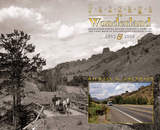 Passage to Wonderland: Rephotographing Joseph Stimson's Views of the Cody Road to Yellowstone National Park, 1903 and 2008
Michael A. Amundson
University Press of Colorado, 2012 In 1903 the Cody Road opened, leading travelers from Cody, Wyoming, to Yellowstone National Park. Cheyenne photographer J. E. Stimson traveled the route during its first week in existence, documenting the road for the state of Wyoming's contribution to the 1904 World's Fair. His images of now-famous landmarks like Cedar Mountain, the Shoshone River, the Holy City, Chimney Rock, Sylvan Pass, and Sylvan Lake are some of the earliest existing photographs of the route. In 2008, 105 years later, Michael Amundson traveled the same road, carefully duplicating Stimson's iconic original photographs. In Passage to Wonderland, these images are paired side by side and accompanied by a detailed explanation of the land and history depicted.
Amundson examines the physical changes along "the most scenic fifty miles in America" and explores the cultural and natural history behind them. This careful analysis of the paired images make Passage to Wonderland more than a "then and now" photography book--it is a unique exploration of the interconnectedness between the Old West and the New West. It will be a wonderful companion for those touring the Cody Road as well as those armchair tourists who can follow the road on Google Earth using the provided GPS coordinates.
The University Press of Colorado gratefully acknowledges the generous support of the Charles Redd Center for Western Studies at Brigham Young University toward the publication of this book.
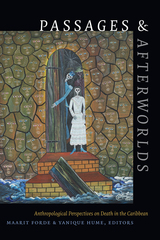 Passages and Afterworlds: Anthropological Perspectives on Death in the Caribbean
Maarit Forde and Yanique Hume, editors
Duke University Press, 2018 The contributors to Passages and Afterworlds explore death and its rituals across the Caribbean, drawing on ethnographic theories shaped by a deep understanding of the region's long history of violent encounters, exploitation, and cultural diversity. Examining the relationship between living bodies and the spirits of the dead, the contributors investigate the changes in cosmologies and rituals in the cultural sphere of death in relation to political developments, state violence, legislation, policing, and identity politics. Contributors address topics that range from the ever-evolving role of divinized spirits in Haiti and the contemporary mortuary practice of Indo-Trinidadians to funerary ceremonies in rural Jamaica and ancestor cults in Maroon culture in Suriname. Questions of alterity, difference, and hierarchy underlie these discussions of how racial, cultural, and class differences have been deployed in ritual practice and how such rituals have been governed in the colonial and postcolonial Caribbean.
Contributors. Donald Cosentino, Maarit Forde, Yanique Hume, Paul Christopher Johnson, Aisha Khan, Keith E. McNeal, George Mentore, Richard Price, Karen Richman, Ineke (Wilhelmina) van Wetering, Bonno (H.U.E.) Thoden van Velzen
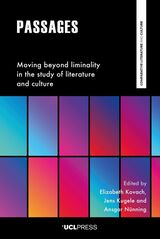 Passages: Moving beyond Liminality in the Study of Literature and Culture
Edited by Elizabeth Kovach, Jens Kugele, and Ansgar Nünning
University College London, 2022 An interdisciplinary exploration of the concept of passages.
The study of literature and culture is marked by various distinct understandings of passages—as both phenomena and critical concepts. These include the anthropological notion of rites of passage, the shopping arcades (Passagen) theorized by Walter Benjamin, the Middle Passage of the Atlantic slave trade, present-day forms of migration and resettlement, and understandings of translation and adaptation. This book explores passages as contexts and processes within which liminal experiences and encounters are situated. Based on the premise that concepts travel through times, contexts, and discursive settings, the volume enables a meaningful exchange regarding passages across disciplinary, national, and linguistic boundaries. Contributions from senior scholars and early-career researchers whose work focuses on areas such as cultural memory, performativity, space, media, (cultural) translation, ecocriticism, gender, and race utilize specific understandings of passages and liminality, reflecting on their value and limits for their research.
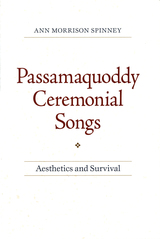 Passamaquoddy Ceremonial Songs: Aesthetics and Survival
Ann Morrison Spinney
University of Massachusetts Press, 2010 Based on extensive research across several disciplines, this book examines the songs and dances involved in public ceremonies of the Wabanaki Confederacy, a coalition of five Algonquian First Nations that figured importantly in the political history of New England and the Maritimes from the seventeenth century on. Ethnomusicologist Ann Morrison Spinney analyzes these ceremonial performances as they have been maintained in one of those nations, the Passamaquoddy community of Maine. She compares historical accounts with forms that have persisted to the present, showing how versions of the same songs, dances, and ritual speeches have continued to play a vital role in Passamaquoddy culture over time. A particular focus of the study is the annual Sipayik Indian Day, a public presentation of the dances associated with the protocols of the Wabanaki Confederacy. Spinney interprets these practices using melodic analysis and cultural contextual frameworks, drawing on a variety of sources, including written documents, sound and video recordings, interviews with singers, dancers, and other cultural practitioners, and her own fieldwork observations. Her research shows that Passamaquoddy techniques of song composition and performance parallel both the structure of the Passamaquoddy language and the political organizations that these ceremonies support.
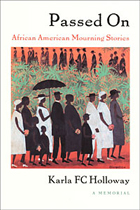 Passed On: African American Mourning Stories, A Memorial
Karla FC Holloway
Duke University Press, 2002 Passed On is a portrait of death and dying in twentieth-century African America. Through poignant reflection and thorough investigation of the myths, rituals, economics, and politics of African American mourning and burial practices, Karla FC Holloway finds that ways of dying are just as much a part of black identity as ways of living. Gracefully interweaving interviews, archival research, and analyses of literature, film, and music, Holloway shows how the vulnerability of African Americans to untimely death is inextricably linked to how black culture represents itself and is represented.
With a focus on the “death-care” industry—black funeral homes and morticians, the history of the profession and its practices—Holloway examines all facets of the burial business, from physicians, hospital chaplains, and hospice administrators, to embalming- chemical salesmen, casket makers, and funeral directors, to grieving relatives. She uses narrative, photographs, and images to summon a painful history of lynchings, white rage and riot, medical malpractice and neglect, executions, and neighborhood violence. Specialized caskets sold to African Americans, formal burial photos of infants, and deathbed stories, unveil a glimpse of the graveyards and burial sites of African America, along with burial rituals and funeral ceremonies.
Revealing both unexpected humor and anticipated tragedy, Holloway tells a story of the experiences of black folk in the funeral profession and its clientele. She also reluctantly shares the story of her son and the way his death moved her research from page to person.
In the conclusion, which follows a sermon delivered by Maurice O. Wallace at the funeral for the author’s son, Bem, Holloway strives to commemorate—through observation, ceremony, and the calling of others to remembrance and celebration.
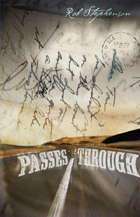 Passes Through
Rob Stephenson
University of Alabama Press, 2010 A fictional meditation on time and experience—part journal, part meditation, part dreamscape In language that is frank and uncompromising, Rob Stephenson’s debut novel, Passes Through, moves forward in a rare and daring manner. Part journal, part meditation on aesthetics, part dreamscape, Passes Through investigates experience, identity, beauty, and sexuality, while provocatively complicating such distinctions as writing versus revision and imagination versus observation. It is a narrative of and about language, a narrative of and about narrative. Can we truly experience the present, the novel asks? No, we cannot, Passes Through suggests again and again. Stephenson throws to the wayside all of the traditional elements of fiction and in doing so composes a sort of musical composition of obsessive consciousness and selfhood’s slippage. This haunting novel never takes the easy route and baffles and confounds on its way toward a stunning yet inevitable finale.
 Passing and Pedagogy: THE DYNAMICS OF RESPONSIBILITY
Pamela L. Caughie
University of Illinois Press, 1999 The current academic milieu displays a deep ambivalence about the teaching of Western culture and traditional subject matter. This ambivalence, the product of a unique historical convergence of theory and diversity, opens up new opportunities for what Pamela Caughie calls "passing":recognizing and accounting for the subject positions involved in representing both the material being taught and oneself as a teacher.
Caughie's discussion of passing illuminates a recent phenomenon in academic writing and popular culture that revolves around identities and the ways in which they are deployed, both in the arts and in lived experience. Through a wide variety of texts—novels, memoirs, film, drama, theory, museum exhibits, legal cases—she demonstrates the dynamics of passing, presenting it not as the assumption of a fraudulent identity but as the recognition that the assumption of any identity, including for the purposes of teaching, is a form of passing.
Astutely addressing the relevance of passing for pedagogy, Caughie presents the possibility of a dynamic ethics responsive to the often polarizing difficulties inherent in today's culture. Challenging and thought-provoking, Passing and Pedagogy offers insight and inspiration for teachers and scholars as they seek to be responsible and effective in a complex, rapidly changing intellectual and cultural environment.
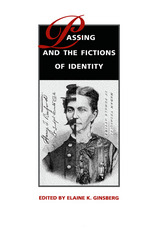 Passing and the Fictions of Identity
Elaine K. Ginsberg
Duke University Press, 1996 Passing refers to the process whereby a person of one race, gender, nationality, or sexual orientation adopts the guise of another. Historically, this has often involved black slaves passing as white in order to gain their freedom. More generally, it has served as a way for women and people of color to access male or white privilege. In their examination of this practice of crossing boundaries, the contributors to this volume offer a unique perspective for studying the construction and meaning of personal and cultural identities. These essays consider a wide range of texts and moments from colonial times to the present that raise significant questions about the political motivations inherent in the origins and maintenance of identity categories and boundaries. Through discussions of such literary works as Running a Thousand Miles for Freedom, The Autobiography of an Ex–Coloured Man, Uncle Tom’s Cabin, The Hidden Hand, Black Like Me, and Giovanni’s Room, the authors examine issues of power and privilege and ways in which passing might challenge the often rigid structures of identity politics. Their interrogation of the semiotics of behavior, dress, language, and the body itself contributes significantly to an understanding of national, racial, gender, and sexual identity in American literature and culture. Contextualizing and building on the theoretical work of such scholars as Judith Butler, Diana Fuss, Marjorie Garber, and Henry Louis Gates Jr., Passing and the Fictions of Identity will be of value to students and scholars working in the areas of race, gender, and identity theory, as well as U.S. history and literature. Contributors. Martha Cutter, Katharine Nicholson Ings, Samira Kawash, Adrian Piper, Valerie Rohy, Marion Rust, Julia Stern, Gayle Wald, Ellen M. Weinauer, Elizabeth Young
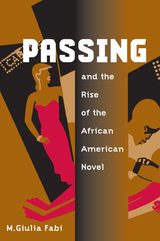 Passing and the Rise of the African American Novel
M. Giulia Fabi
University of Illinois Press, 2001 Passing and the Rise of the African American Novel restores to its rightful place a body of American literature that has long been overlooked, dismissed, or misjudged. This insightful reconsideration of nineteenth-century African American fiction uncovers the literary artistry and ideological complexity of a body of work that laid the foundation for the Harlem Renaissance and changed the course of American letters.
Focusing on the trope of passing--black characters lightskinned enough to pass for white--M. Giulia Fabi shows how early African American authors such as William Wells Brown, Frank J. Webb, Charles W. Chesnutt, Sutton E. Griggs, Frances E. W. Harper, Edward A. Johnson, and James Weldon Johnson transformed traditional representations of blackness and moved beyond the tragic mulatto motif. Challenging the myths of racial purity and the color line, these authors used passing to celebrate a distinctive, African American history, culture, and worldview.
Fabi examines how early black writers adapted existing literary forms, including the sentimental romance, the domestic novel, and the utopian novel, to express their convictions and concerns about slavery, segregation, and racism. Chesnutt used passing as both a structural and a thematic element, while James Weldon Johnson innovated by parodying the earlier novels of passing and presenting the decision to pass as the result, rather than the cause, of cultural alienation. Fabi also gives a historical overview of the canon-making enterprises of African American critics from the 1850s to the 1990s and considers how their concerns about promoting the canonization of African American literature affected their perceptions of nineteenth-century black fiction.
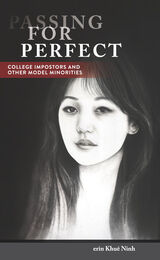 Passing for Perfect: College Impostors and Other Model Minorities
erin Khuê Ninh
Temple University Press, 2021 In her engaging study, Passing for Perfect,erin Khuê Ninh considers the factors that drove college imposters such as Azia Kim—who pretended to be a Stanford freshman—and Jennifer Pan—who hired a hitman to kill her parents before they found out she had never received her high school diploma—to extreme lengths to appear successful. Why would someone make such an illogical choice? And how do they stage these lies so convincingly, and for so long? These outlier examples prompt Ninh to address the larger issue of the pressures and difficulties of striving to be model minority, where failure is too ruinous to admit. Passing for Perfect insists that being a “model minority” is not a “myth,” but coded into one’s programming as an identity—a set of convictions and aspirations, regardless of present socioeconomic status or future attainability—and that the true cost of turning children into high-achieving professionals may be higher than anyone can bear. Ninh’s book codifies for readers the difference between imposters who are con artists or shysters and those who don’t know how to stop passing for perfect.
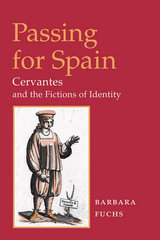 Passing for Spain: CERVANTES AND THE FICTIONS OF IDENTITY
Barbara Fuchs
University of Illinois Press, 2003 Passing for Spain charts the intersections of identity, nation, and literary representation in early modern Spain. Barbara Fuchs analyzes the trope of passing in Don Quijote and other works by Cervantes, linking the use of disguise to the broader historical and social context of Counter-Reformation Spain and the religious and political dynamics of the Mediterranean Basin.
In five lucid and engaging chapters, Fuchs examines what passes in Cervantes’s fiction: gender and race in Don Quijote and “Las dos doncellas”; religion in “El amante liberal” and La gran sultana; national identity in the Persiles and “La española inglesa.” She argues that Cervantes represents cross-cultural impersonation -- or characters who pass for another gender, nationality, or religion -- as challenges to the state’s attempts to assign identities and categories to proper Spanish subjects.
Fuchs demonstrates the larger implications of this challenge by bringing a wide range of literary and political texts to bear on Cervantes’s representations. Impeccably researched, Passing for Spain examines how the fluidity of individual identity in early modern Spain undermined a national identity based on exclusion and difference.
 Passing for White: Race, Religion, and the Healy Family, 1820-1920
James M. O'Toole
University of Massachusetts Press, 2002 Through the prism of one family's experience, this book explores questions of racial identity, religious tolerance, and black-white "passing" in America. Spanning the century from 1820 to 1920, it tells the story of Michael Morris Healy, a white Irish immigrant planter in Georgia; his African American slave Eliza Clark Healy, who was also his wife; and their nine children. Legally slaves, these brothers and sisters were smuggled north before the Civil War to be educated. In spite of the hardships imposed by American society on persons of mixed racial heritage, the Healy children achieved considerable success. Rejecting the convention that defined as black anyone with "one drop of Negro blood," they were able to transform themselves into white Americans. Their unlikely ally in this transition was the Catholic church, as several of them became priests or nuns. One brother served as a bishop in Maine, another as rector of the Cathedral in Boston, and a third as president of Georgetown University. Of the two sisters who became nuns, one was appointed the superior of convents in the United States and Canada. Another brother served for twenty years as a captain in the U.S. Coast Guard, enforcing law and order in the waters off Alaska. The Healy children's transition from black to white should not have been possible according to the prevailing understandings of race, but they accomplished it with apparent ease. Relying on their abilities, and in most cases choosing celibacy, which precluded mixed-race offspring, they forged a place for themselves. They also benefited from the support of people in the church and elsewhere. Even those white Americans who knew the family's background chose to overlook their African ancestry and thereby help them to "get away" with passing. By exploring the lifelong struggles of the members of the Healy family to redefine themselves in a racially polarized society, this book makes a distinctive contribution to our understanding of the enduring dilemma of race in America.
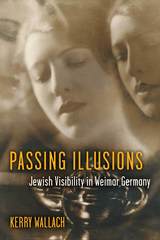 Passing Illusions: Jewish Visibility in Weimar Germany
Kerry Wallach
University of Michigan Press, 2017 Weimar Germany (1919–33) was an era of equal rights for women and minorities, but also of growing antisemitism and hostility toward the Jewish population. This led some Jews to want to pass or be perceived as non-Jews; yet there were still occasions when it was beneficial to be openly Jewish. Being visible as a Jew often involved appearing simultaneously non-Jewish and Jewish. Passing Illusions examines the constructs of German-Jewish visibility during the Weimar Republic and explores the controversial aspects of this identity—and the complex reasons many decided to conceal or reveal themselves as Jewish. Focusing on racial stereotypes, Kerry Wallach outlines the key elements of visibility, invisibility, and the ways Jewishness was detected and presented through a broad selection of historical sources including periodicals, personal memoirs, and archival documents, as well as cultural texts including works of fiction, anecdotes, images, advertisements, performances, and films. Twenty black-and-white illustrations (photographs, works of art, cartoons, advertisements, film stills) complement the book’s analysis of visual culture.
Passing Lines: Sexuality and Immigration
Brad Epps
Harvard University Press, 2005 Passing Lines seeks to stimulate dialogue on the role of sexuality and sexual orientation in immigration to the U.S. from Latin America and the Caribbean. The book looks at the complexities, inconsistencies, and paradoxes of immigration from the point of view of both academics and practitioners in the field.
Passing Lines takes a close look at the debates that surround eyewitness testimony, expertise, and advocacy regarding immigration and sexuality, bringing together work by scholars, activists, and others from both sides of the border.
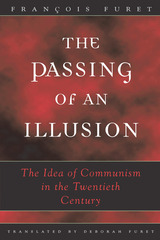 The Passing of an Illusion: The Idea of Communism in the Twentieth Century
François Furet
University of Chicago Press, 1999 François Furet was acknowledged as the twentieth century's preeminent historian of the French Revolution. But years before his death, he turned his attention to the consequences and aftermath of another critical revolution—the Communist revolution. The result, Le passé d'une illusion, is a penetrating history of the ideological passions that have fueled and characterized the modern era.
"This may well be the most illuminating study ever devoted to the question of appeal exerted not only by Communism but also by the Nazi and other fascist varieties of totalitarianism in this century."—Hilton Kramer, New Criterion
"A subtle, nuanced but gripping study of the most pervasive and destructive illusion in the 20th century." —Kirkus Reviews, starred review
"The Passing of an Illusion . . . is both a profound work of intellectual history that takes its place alongside other great studies of the leftist heresy . . . and a relentless diagnosis of the self-subversive risks that are inherent in democratic regimes. "—Roger Kaplan, Washington Times
" A remarkable book. . . . Stimulating and challenging. . . . A man widely read in several languages, Furet clearly knew his way around 20th-century Europe, even unto the dark alleys that figure on no existing map. "—Mark Falcoff, Commentary
"A history of ideas, this work is not for the faint of heart, yet those who challenge it will discover a signal contribution to the literature of Communism."—Booklist
"Imperious and stunningly confident, grand in conception and expansive in manner, packed with fascinating detail and often incisive judgements."—John Dunn, Times Higher Education Supplement
"The Passing of an Illusion is brilliant, and one would be hard pressed to find better writing of history than the first chapter, which traces the roots of modern political thinking back to the nineteenth century."—J. Arch Getty, Atlantic Monthly
"A brilliant and important book. . . . The publication of the American edition makes accessible to the general reader the most thought-provoking historical assessment of communism in Europe to appear since its collapse."—Jeffrey Herf, Wall Street Journal
François Furet (1927-1997), educator and author, was a Chevalier of the Legion of Honor and was elected, in 1997, to become one of the "Forty Immortals" of the Académie Française, the highest intellectual honor in France. His many books include Interpreting the French Revolution, Marx and the French Revolution, and Revolutionary France. Deborah Furet, his widow, collaborated with him on many projects.
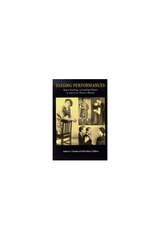 Passing Performances: Queer Readings of Leading Players in American Theater History
Robert A. Schanke and Kim Marra, Editors
University of Michigan Press, 1998 Passing Performances gathers a range of critical and biographical essays on notable personalities whose major contributions to the stage occurred before 1969, the year of the Stonewall riots that kicked off the gay rights movement in the United States. How these theater practitioners variously "passed"-- i.e., managed unconventional sexual inclinations both on- and offstage--significantly determined the course of their personal and professional lives and thus the course of U.S. theater history.
The actors, directors, producers, and agents examined here include Edwin Forrest, Charlotte Cushman, and Adah Isaacs Menken, whose personal lives and careers traded on the same-sex erotics of "true love" in the antebellum period; Elisabeth Marbury, Elsie de Wolfe, Elsie Janis, Nance O'Neil, and Alla Nazimova, whose intimate female liaisons were variously interpreted around the turn of the century; the "lavender marriages" of Alfred Lunt to Lynne Fontanne and Guthrie McClintic to Katharine Cornell; the lesbian collaborations of Margaret Webster and Cheryl Crawford; the comic antics of Monty Woolley, which negotiated codified constructions of homosexual perversion in the post-Freudian interwar years; and the on- and offstage performances of Mary Martin and Joe Cino, which resisted the paranoid enforcements of heterosexual normality in the McCarthy era. Central to these investigations are the complex connections of performances of sexuality and gender and their different implications for men and women practitioners working under pervasive sexism and homophobia.
The volume also includes striking archival photographs of the performers and their performances, and an index to facilitate the cross-referencing of subjects' intersecting careers. Passing Performances will engage both general and academic readers interested in theater, gay and lesbian history, American studies, and biography.
Robert A. Schanke is Professor of Theatre and Chair of the Division of Fine Arts, Central College, Iowa. Kim Marra is Associate Professor of Theatre Arts, University of Iowa.
 Passing Performances: Queer Readings of Leading Players in American Theater History
Robert A. Schanke and Kim Marra, Editors
University of Michigan Press
Passing Performances gathers a range of critical and biographical essays on notable personalities whose major contributions to the stage occurred before 1969, the year of the Stonewall riots that kicked off the gay rights movement in the United States. How these theater practitioners variously "passed"-- i.e., managed unconventional sexual inclinations both on- and offstage--significantly determined the course of their personal and professional lives and thus the course of U.S. theater history.
The actors, directors, producers, and agents examined here include Edwin Forrest, Charlotte Cushman, and Adah Isaacs Menken, whose personal lives and careers traded on the same-sex erotics of "true love" in the antebellum period; Elisabeth Marbury, Elsie de Wolfe, Elsie Janis, Nance O'Neil, and Alla Nazimova, whose intimate female liaisons were variously interpreted around the turn of the century; the "lavender marriages" of Alfred Lunt to Lynne Fontanne and Guthrie McClintic to Katharine Cornell; the lesbian collaborations of Margaret Webster and Cheryl Crawford; the comic antics of Monty Woolley, which negotiated codified constructions of homosexual perversion in the post-Freudian interwar years; and the on- and offstage performances of Mary Martin and Joe Cino, which resisted the paranoid enforcements of heterosexual normality in the McCarthy era. Central to these investigations are the complex connections of performances of sexuality and gender and their different implications for men and women practitioners working under pervasive sexism and homophobia.
The volume also includes striking archival photographs of the performers and their performances, and an index to facilitate the cross-referencing of subjects' intersecting careers. Passing Performances will engage both general and academic readers interested in theater, gay and lesbian history, American studies, and biography.
Robert A. Schanke is Professor of Theatre and Chair of the Division of Fine Arts, Central College, Iowa. Kim Marra is Associate Professor of Theatre Arts, University of Iowa.
Passing Strange and Wonderful: Aesthetics Nature And Culture
Yi-Fu Tuan
Island Press, 1993 In this rich and rewarding work, Yi-Fu Tuan vividly demonstrates that feeling and beauty are essential components of life and society. The aesthetic is not merely one aspect of culture but its central core—both its driving force and its ultimate goal. Beginning with the individual and his physical world, Tuan's exploration progresses from the simple to the complex. His initial evaluation of the building blocks of aesthetic experience (sight, hearing, smell, taste, touch) develops gradually into a wide-ranging examination of the most elaborate of human constructs, including art, architecture, literature, philosophy, music, and more.
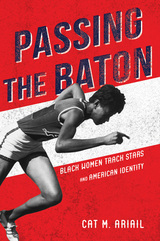 Passing the Baton: Black Women Track Stars and American Identity
Cat M. Ariail
University of Illinois Press, 2020 After World War II, the United States used international sport to promote democratic values and its image of an ideal citizen. But African American women excelling in track and field upset such notions. Cat M. Ariail examines how athletes such as Alice Coachman, Mae Faggs, and Wilma Rudolph forced American sport cultures—both white and Black—to reckon with the athleticism of African American women. Marginalized still further in a low-profile sport, young Black women nonetheless bypassed barriers to represent their country. Their athletic success soon threatened postwar America's dominant ideas about race, gender, sexuality, and national identity. As Ariail shows, the wider culture defused these radical challenges by locking the athletes within roles that stressed conservative forms of femininity, blackness, and citizenship. A rare exploration of African American women athletes and national identity, Passing the Baton reveals young Black women as active agents in the remaking of what it means to be American.
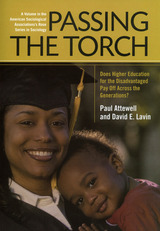 Passing the Torch: Does Higher Education for the Disadvantaged Pay Off Across the Generations?
Paul Attewell
Russell Sage Foundation, 2007 The steady expansion of college enrollment rates over the last generation has been heralded as a major step toward reducing chronic economic disparities. But many of the policies that broadened access to higher education—including affirmative action, open admissions, and need-based financial aid—have come under attack in recent years by critics alleging that schools are admitting unqualified students who are unlikely to benefit from a college education. In Passing the Torch, Paul Attewell, David Lavin, Thurston Domina, and Tania Levey follow students admitted under the City University of New York’s “open admissions” policy, tracking its effects on them and their children, to find out whether widening college access can accelerate social mobility across generations. Unlike previous research into the benefits of higher education, Passing the Torch follows the educational achievements of three generations over thirty years. The book focuses on a cohort of women who entered CUNY between 1970 and 1972, when the university began accepting all graduates of New York City high schools and increasing its representation of poor and minority students. The authors survey these women in order to identify how the opportunity to pursue higher education affected not only their long-term educational attainments and family well-being, but also how it affected their children’s educational achievements. Comparing the record of the CUNY alumnae to peers nationwide, the authors find that when women from underprivileged backgrounds go to college, their children are more likely to succeed in school and earn college degrees themselves. Mothers with a college degree are more likely to expect their children to go to college, to have extensive discussions with their children, and to be involved in their children’s schools. All of these parenting behaviors appear to foster higher test scores and college enrollment rates among their children. In addition, college-educated women are more likely to raise their children in stable two-parent households and to earn higher incomes; both factors have been demonstrated to increase children’s educational success. The evidence marshaled in this important book reaffirms the American ideal of upward mobility through education. As the first study to indicate that increasing access to college among today’s disadvantaged students can reduce educational gaps in the next generation, Passing the Torch makes a powerful argument in favor of college for all.
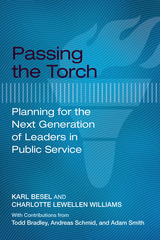 Passing the Torch: Planning for the Next Generation of Leaders in Public Service
Karl Besel
University of Arkansas Press, 2016 Public-service executives, both elected and appointed within the public and nonprofit sectors, are retiring at record levels, and the number of Americans reaching age sixty-five annually will continue to rise over the next decade and is expected to surpass four million in 2020. Finding qualified, motivated leaders to fill vital public-service positions will challenge the public and nonprofit sectors. Unfortunately, recent studies show that few proactive steps are being taken by public-service organizations to plan for the next generation. Passing the Torch: Planning for the Next Generation of Public-Service Leaders provides an outline for those who will be facing and managing these looming changes. In this valuable guide, the factors that influence selection of a career in public service are explored through the authors’ years of experience as leaders in public-service organizations and through interviews with other public-service professionals. Passing the Torch will be essential for leaders of nonprofit organizations, university faculty, researchers in the field of nonprofit management, and students in nonprofit management courses.
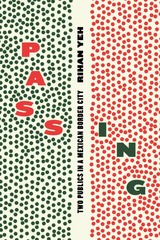 Passing: Two Publics in a Mexican Border City
Rihan Yeh
University of Chicago Press, 2017 Tijuana is the largest of Mexico’s northern border cities, and although it has struggled during the United States’ dramatic escalation of border enforcement, it nonetheless remains deeply connected with California by one of the largest, busiest international ports of entry in the world. In Passing, Rihan Yeh probes the border’s role in shaping Mexican senses of self and collectivity. Drawing on extensive fieldwork, Yeh examines a range of ethnographic evidence: public demonstrations, internet forums, popular music, dinner table discussions, police encounters, workplace banter, intensely personal interviews, and more. Through these everyday exchanges, she shows how the promise of passage and the threat of prohibition shape Tijuana’s communal sense of “we” and throw into relief long-standing divisions of class and citizenship in Mexico.
Out of the nitty-gritty of quotidian talk and interaction in Tijuana, Yeh captures the dynamics of desire and denial that permeate public spheres in our age of transnational crossings and fortified borders. Original and accessible, Passing is a timely work in light of current fierce debates over immigration, Latin American citizenship, and the US-Mexico border.
Passion and Craft: CONVERSATIONS WITH NOTABLE WRITERS
Edited by Bonnie Lyons and Bill Oliver
University of Illinois Press, 1998 The twelve contemporary fiction writers interviewed in Passion and
Craft go beyond the merely autobiographical, revealing that, despite
their differences, they share passionate devotion and discipline for their
craft.
Included are Richard Ford, winner in 1995 of both the Pulitzer Prize
and the PEN/Faulkner Award; Gina Berriault, 1997 winner of the National
Book Critics Circle Award; Bobbie Ann Mason; T. Coraghessan Boyle; Rick
Bass; Leonard Michaels; Christopher Tilghman; Thom Jones; Julia Alvarez;
Andre Dubus; Jayne Anne Phillips; and Tobias Wolff.
Their comments will interest readers devoted to their novels and stories,
other writers, and aspiring writers.
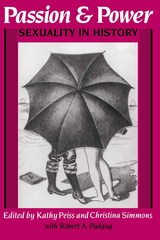 Passion And Power: Sexuality in History
Kathy Peiss
Temple University Press, 1989 "Brings together some of the most recent and innovative writing on the history of sexuality and explores the experiences, ideas and conflicts that have shaped the emergence of modern sexual identities."
--Dare
Passion and Power brings together some of the most recent and innovative writings on the history of sexuality and explores the experiences, ideas, and conflicts that have shaped the emergence of modern sexual identities. Arguing that sexuality is not an unchanging biological reality or a universal natural force, the essays in this volume discuss sexuality as an integral part of the history of human experience. Articles on sexual assault, homosexuality, birth control, venereal disease, sexual repression, pornography, and the AIDS epidemic examine the ways that sexuality has become a core element of modern social identity in the nineteenth- and twentieth-century United States.
It is only in recent years that historians have begun to examine the social construction of sexuality. This is the first anthology that addresses this issue from a radical historical perspective, examining sexuality as a field of contention in itself and as part of other struggles rooted in divisions of gender, class, and race.
Contents
Part I: Sexuality and Historical Meaning
1. Passion and Power: An Introdtion - Kathy Peiss and Christina Simmons
2. Sexual Matters: On Conceptualizing Sexuality in History - Robert A. Padgug
Part II: The Emergence of Modern Sexuality, 1790 to 1930
3. "The Life of a Citizen in the Hands of a Woman": Sexual Assault in New York City, 1790 to 1820 - Marybeth Hamilton Arnold
4. "Charity Girls" and City Pleasurer: Historical Notes on Working Class Sexuality, 1880-1920 - Kathy Peiss
5. Movements of Affirmation: Sexual Meanings and Homosexual Identities - Jeffrey Weeks
6. From Sexual Inversion to Homosexuality: The Changing Medical Conceptualization of Female "Deviance" - George Chauncey, Jr.
7. "We Were a Little Band of Willful Women": The Heterodoxy Club of Greenwich Village - Judith Schwartz, Kathy Peiss, and Christina Simmons
8. The Black Community and the Birth Control Movement - Jessie M. Rodrique
Part III: Sexual Conflicts and Cultural Authority, 1920 to 1960
9. Modern Sexuality and the Myrh of Victorian Repression - Christina Simmons
10. Venereal Disease: The Wages of Sin? - Elizabeth Fee
11. "Uncontrolled Desires": The Response to the Sexual Psychopath, 1920-1960 - Estelle B. Freedman
12. The Homosexual Menace: The Politics of Sexuality in Cold War America - John D'Emilio
13. The Reproduction of Butch-Fern Roles: A Social Constructionist Approach - Elizabeth Lapovsky Kennedy and Madeline Davis
Part IV: Private Passions and Public Debate, 1960 to the Present
14. Mass Market Romance: Pornography for Women Is Different - Ann Barr Snitow
15. (De)Constructing Pornography: Feminisms in Conflict - Duphne Read
16. Gay Villain, Gay Hero: Homosexuality and the Social Construction of AIDS - Robert A. Padgug
About the Author(s)
Kathy Peiss is Associate Professor of History and Women's Studies at the University of Massachusetts at Amherst and author of Cheap Amusements: Working Women and Leisure in Turn-of-the-century New York (Temple).
Christina Simmons is Assistant Professor of History at the University of Cincinnati-Raymond Walters College.
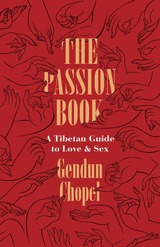 The Passion Book: A Tibetan Guide to Love and Sex
Gendun Chopel
University of Chicago Press, 2018 The PassionBook is the most famous work of erotica in the vast literature of Tibetan Buddhism, written by the legendary scholar and poet Gendun Chopel (1903-1951). Soon after arriving in India in 1934, he discovered the Kama Sutra. Realizing that this genre of the erotic was unknown in Tibet, he set out to correct the situation. His sources were two: classical Sanskrit works and his own experiences with his lovers. Completed in 1939, his “treatise on passion” circulated in manuscript form in Tibet, scandalizing and arousing its readers.
Gendun Chopel here condemns the hypocrisy of both society and church, portraying sexual pleasure as a force of nature and a human right for all. On page after page, we find the exuberance of someone discovering the joys of sex, made all the more intense because they had been forbidden to him for so long: he had taken the monastic vow of celibacy in his youth and had only recently renounced it. He describes in ecstatic and graphic detail the wonders he discovered. In these poems, written in beautiful Tibetan verse, we hear a voice with tints of irony, self-deprecating wit, and a love of women not merely as sources of male pleasure but as full partners in the play of passion.
A Passion for Consumption: The Gothic Novel in America
Anna Sonser
University of Wisconsin Press, 2001 Offering a fresh perspective on the gothic novel in America, this vigorous study engages the underlying currents that define American culture as one of consumption. It rereads texts that range from Hawthorne, Poe, James, and Faulkner to the contemporary gothic novels of Toni Morrison, Joyce Carol Oates, and Anne Rice. By exposing the literary motifs of subversion and seduction inherent in these works as disruptive to the flow, circulation, and expansion of value, this book positions American literary culture as an extension of commodity economics. Its cogent yet interdisciplinary approach, supported by the work of such theorists as Jacques Lacan and Jean Baudrillard, makes this text useful to anyone interested in American literature, popular culture, and American economic thought.
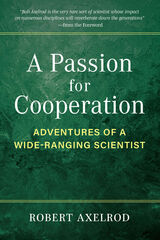 A Passion for Cooperation: Adventures of a Wide-Ranging Scientist
Robert Axelrod
University of Michigan Press, 2023 A Passion for Cooperation is the exciting autobiography of Robert Axelrod, one of the most acclaimed and wide-ranging scientists of the last fifty years. After being recognized by President Kennedy for being a promising young scientist while in high school, Axelrod built a career dedicated to collaborating with business school professors, international relations scholars, political scientists, computer scientists, and even evolutionary biologists and cancer researchers. Fifty years later, he was honored by President Obama with the National Medal of Science for scientific achievement and leadership and his work has been referred to as the gold standard of interdisciplinary research.
Yet Axelrod’s autobiography is not just an account of his wide-ranging passion for cooperation. It reveals his struggles to overcome failures and experience the joys of gaining new insights into how to achieve cooperation. A Passion for Cooperation recounts Robert Axelrod’s adventures talking with the leader of the organization Hamas, the Prime Minister of Israel, and the Foreign Minister of Syria. Axelrod also shares stories of being hosted in Kazakhstan by senior Soviet retired generals and visiting China with well-connected policy advisors on issues of military aspects of cyber conflict. Through stories of the difficulties and rewards of interdisciplinary collaborations, readers will discover how Axelrod’s academic and practical work have enriched each other and demonstrated that opportunities for cooperation are much greater than generally thought.
A Passion For Gold: An Autobiography
Ralph J. Roberts
University of Nevada Press, 2002 Ralph J. Roberts is not a household name in Nevada, but it should be—it was he who discovered the Carlin Belt gold deposits that created a major mining boom in the state in the last four decades of the twentieth century. But this discovery was only one episode of his remarkably eventful life. This colorful and personal account of the author's search for his passion—gold—is a story as adventurous as that of any fictional character.
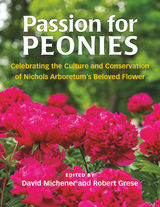 Passion for Peonies: Celebrating the Culture and Conservation of Nichols Arboretum's Beloved Flower
David Michener and Robert Grese, Editors
University of Michigan Press, 2020 There’s no more breathtaking signal of summer’s onset than the blooming of peonies. Stunningly beautiful and relatively easy to grow, peonies are a favorite flower everywhere they can be cultivated and for good reason: the heady fragrances and enchanting colors of a peony-rich display create an immersive experience that has enamored generations of garden lovers across the world. This passion is on full display each June at the historic Peony Garden of the University of Michigan’s Nichols Arboretum.
Originally planted in 1922, the Nichols Arboretum Peony Garden now boasts North America’s largest public collection of heirloom herbaceous peonies. The Peony Garden has become a sacred space for the Ann Arbor community, a not-to-be-missed sensation when it erupts each season, as the Ann Arbor Observer once wrote, in “a riot of color, of crimson, rose and shell pink intermingled with fluffy pompoms of creamy white.” The rather short period of peak bloom—about two fleeting weeks each year—only seems to intensify the garden’s appeal, drawing thousands of visitors annually to this spectacular “living museum” on campus that showcases upwards of 10,000 blossoms.
Richly illustrated with hundreds of striking color photos, Passion for Peonies collects twenty short essays that celebrate the story of the Nichols Arboretum Peony Garden as well as the rich social history of peony gardening that it is an integral part of. Together these pieces comprise a love letter both to a magical public space at the University of Michigan and to the broader history and culture of peony gardening. The book will appeal to readers interested in the University of Michigan, the history of public gardens, and of course peonies!
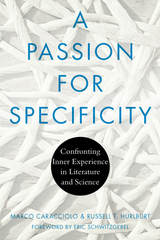 A Passion for Specificity: Confronting Inner Experience in Literature and Science
Marco Caracciolo and Russell Hurlburt
Ohio State University Press, 2016 In an analytical yet increasingly intimate conversation, A Passion for Specificity:Confronting Inner Experience in Literature and Science investigates the differences between experience as conveyed in literature and experience as apprehended through scientific method. Can experiences be shared? How much do language and metaphor shape experiential reports? Where is the dividing line between a humanistic and a scientific approach to experience? In a series of exchanges, Marco Caracciolo and Russell Hurlburt demonstrate that those are necessarily personal issues, and they don’t flinch—they relentlessly examine whether Caracciolo’s presuppositions distort his understanding of reading experiences and whether Hurlburt’s attachment to the method he invented causes him to take an overly narrow view of experience. Delving ever more personally, they aim Hurlburt’s experience sampling methods—beeping people to discover what was in their stream of inner experience at the moment immediately before the beep—at Caracciolo’s own experiences, an exercise that puts Caracciolo’s presuppositions to the test and leads him to discover things about experience (his own and literature’s) that he had thought impossible.
A Passion for Specificity, with its personal revelations, unexpected twists, and confrontational style, reads like an epistolary novel, but it is a serious exploration of ideas at the heart of literature and science. It is a thoughtful attempt at advancing the emerging “cognitive humanities,” clarifying a number of core issues in the cross-pollination of literature, psychology, philosophy, and consciousness science.
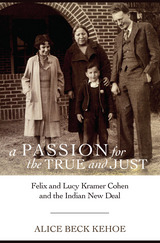 A Passion for the True and Just: Felix and Lucy Kramer Cohen and the Indian New Deal
Alice Beck Kehoe
University of Arizona Press, 2014 Felix Cohen, the lawyer and scholar who wrote TheHandbook of Federal Indian Law (1942), was enormously influential in American Indian policy making. Yet histories of the Indian New Deal, a 1934 program of Franklin D. Roosevelt’s New Deal, neglect Cohen and instead focus on John Collier, commissioner of Indian affairs within the Department of the Interior (DOI). Alice Beck Kehoe examines why Cohen, who, as DOI assistant solicitor, wrote the legislation for the Indian Reorganization Act (1934) and Indian Claims Commission Act (1946), has received less attention. Even more neglected was the contribution that Cohen’s wife, Lucy Kramer Cohen, an anthropologist trained by Franz Boas, made to the process.
Kehoe argues that, due to anti-Semitism in 1930s America, Cohen could not speak for his legislation before Congress, and that Collier, an upper-class WASP, became the spokesman as well as the administrator. According to the author, historians of the Indian New Deal have not given due weight to Cohen’s work, nor have they recognized its foundation in his liberal secular Jewish culture. Both Felix and Lucy Cohen shared a belief in the moral duty of mitzvah, creating a commitment to the “true and the just” that was rooted in their Jewish intellectual and moral heritage, and their Social Democrat principles.
A Passion for the True and Just takes a fresh look at the Indian New Deal and the radical reversal of US Indian policies it caused, moving from ethnocide to retention of Indian homelands. Shifting attention to the Jewish tradition of moral obligation that served as a foundation for Felix and Lucy Kramer Cohen (and her professor Franz Boas), the book discusses Cohen’s landmark contributions to the principle of sovereignty that so significantly influenced American legal philosophy.
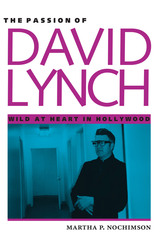 The Passion of David Lynch: Wild at Heart in Hollywood
By Martha P. Nochimson
University of Texas Press, 1997 Filmmaker David Lynch asserts that when he is directing, ninety percent of the time he doesn't know what he is doing. To understand Lynch's films, Martha Nochimson believes, requires a similar method of being open to the subconscious, of resisting the logical reductiveness of language. In this innovative book, she draws on these strategies to offer close readings of Lynch's films, informed by unprecedented, in-depth interviews with Lynch himself. Nochimson begins with a look at Lynch's visual influences—Jackson Pollock, Francis Bacon, and Edward Hopper—and his links to Alfred Hitchcock and Orson Welles, then moves into the heart of her study, in-depth analyses of Lynch's films and television productions. These include Twin Peaks: Fire Walk with Me, Wild at Heart, Twin Peaks, Blue Velvet, Dune, The Elephant Man, Eraserhead, The Grandmother, The Alphabet, and Lynch's most recent, Lost Highway. Nochimson's interpretations explode previous misconceptions of Lynch as a deviant filmmaker and misogynist. Instead, she shows how he subverts traditional Hollywood gender roles to offer an optimistic view that love and human connection are really possible.
 The Passion of Emily Dickinson
Judith Farr
Harvard University Press, 1992 "How tame and manageable are the emotions of our bards, how placid and literary their allusions!" complained essayist T. W. Higginson in the Atlantic Monthly in 1870. "The American poet of passion is yet to come." He was, of course, unaware of the great erotic love poems such as "Wild Nights--Wild Nights!" and "Struck was I, nor yet by Lightning" being privately written by his reclusive friend Emily Dickinson.
In a profound new analysis of Dickinson's life and work, Judith Farr explores the desire, suffering, exultation, spiritual rapture, and intense dedication to art that characterize Dickinson's poems, and deciphers their many complex and witty references to texts and paintings of the day. In The Passion of Emily Dickinson the poet emerges, not as a cryptic proto-modern or a victim of female repression, but as a cultivated mid-Victorian in whom the romanticism of Emerson and the American landscape painters found bold expression.
Dickinson wrote two distinct cycles of love poetry, argues Farr, one for her sister-in-law Sue and one for the mysterious "Master," here convincingly identified as Samuel Bowles, a friend of the family. For each of these intimates, Dickinson crafted personalized metaphoric codes drawn from her reading. Calling books her "Kinsmen of the Shelf," she refracted elements of Jane Eyre, Antony and Cleopatra, Tennyson's Maud, De Quincey's Confessions, and key biblical passages into her writing. And, to a previously unexplored degree, Dickinson also quoted the strategies and subject matter of popular Hudson River, Luminist, and Pre-Raphaelite paintings, notably Thomas Cole's Voyage of Life and Frederic Edwin Church's Heart of the Andes. Involved in the delicate process of both expressing and disguising her passion, Dickinson incorporated these sources in an original and sophisticated manner.
Farr's superb readings of the poems and letters call on neglected archival material and on magazines, books, and paintings owned by the Dickinsons. Viewed as part of a finely articulated tradition of Victorian iconography, Dickinson's interest in the fate of the soul after death, her seclusion, her fascination with landscape's mystical content, her quest for honor and immortality through art, and most of all her very human passions become less enigmatic. Farr tells the story of a poet and her time.
The Passion of Ingmar Bergman
Frank Gado
Duke University Press, 1986 Acknowledged as one of the greatest filmmakers of this or any other time, Bergman has with few exceptions written his own screenplays—an uncommon practice in the film industry—and for this practice critics refer to him as a "literary" filmmaker: In this work, Gado examines virtually the entire range of Bergman's literary output. While treating the matter of the visual presentation of Bergman's films, Gado concentrates on story and narrative and their relationship to Bergman's personal history. Gado concludes that whatever the outward appearance of Bergman's works, they contain an elementary psychic fantasy that links them all, revealing an artist who hoped to be a dramatist, "the new Strindberg," and who saw the camera as an extension of his pen.
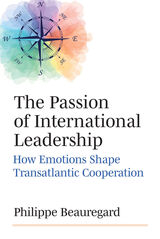 The Passion of International Leadership: How Emotions Shape Transatlantic Cooperation
Philippe Beauregard
University of Michigan Press, 2022 How do international leaders emerge and why are they successful in bringing followers to converge on their positions? The Passion of International Leadership draws on recent advances in political psychology and state-of-the-art research in International Relations to go beyond current knowledge and simplistic accounts of international leadership. It tells surprising and intense stories of policymakers at the head of great powers attempting to cooperate during crisis moments, and uses these stories to challenge commonly held beliefs and intuitions about international leadership.
Beauregard explores international leadership in four cases of transatlantic cooperation when Western policymakers were confronted with foreign conflicts, like civil or secessionist wars. He provides a fascinating study of the recognition of Slovenia, Croatia, and Bosnia during the wars in Yugoslavia; the peace mediation during the Russia-Georgia war in 2008; the adoption of economic sanctions against Russia over the conflict in Ukraine; and finally, cooperation on striking against the Islamic State in Iraq and Syria. The book argues that leaders are driven by their convictions, and that they must strike a balance between the intense emotions associated with their beliefs and their need to represent a broader community. At the same time as they seek to bring followers on board by persuading them, they need to pay attention to emotionally contagious and resonant events that can alter the course of international cooperation.
Passion of Israel: Jacques Maritain, Catholic Conscience, and the Holocaust
Richard Francis Crane
University of Scranton Press, 2010 In his lifetime, French philosopher Jacques Maritain (1882–1973) achieved a reputation as both a leading Catholic intellectual and as an outspoken critic of antisemitism. Here historian Richard Francis Crane traces the development of Maritain’s opposition toward antisemitism and analyzes the Catholic appreciation of Judaism that animated his stance. Crane probes the writings and teachings of Maritain—from before, during, and after the Holocaust—and illuminates how his ideas altered Christian perceptions of Jews and Judaism during his lifetime and continue to do so today.
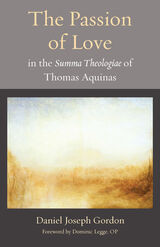 The Passion of Love in the Summa Theologiae of Thomas Aquinas
Daniel Joseph Gordon
Catholic University of America Press, 2023 This book is an introduction to three questions on love according to St. Thomas Aquinas (Summa Theologiae I–II, qq. 26–28). These three questions reflect on the nature of love (q. 26), the causes of love (q. 27), and the effects of love (q. 28). It is thus an introduction to the entire phenomenon of love, both as a bodily passion and an act of the will. The purpose is to present the Thomistic and broadly scholastic account of human and divine
love from a philosophical and theological perspective. It aims to be a theological and philosophical study of the topic, useful both for a graduate/professional audience, as part of an undergraduate or graduate course, and perhaps for the educated reader. The thesis of the book is that, contrary to contemporary conceptions, not all loves are created equal. Some loves perfect us and some loves corrupt us. The worth of a love depends on its object and end. St. Thomas thus presents an objective and teleological account of human and divine love that is of philosophical and theological interest. The method is broadly exegetical, presenting a careful reading of the text and supplying the philosophical and theological background which the text of Aquinas assumes. The scope of the work is limited to three questions (ST I–II, qq. 26–28). References to interpretative disputes of Aquinas and references to further resources in the secondary literature will be mostly limited to the footnotes, making the body of the text accessible to more readers.
The Passion of Michel Foucault
James Miller
Harvard University Press Based on extensive new research and a bold interpretation of the man and his texts, The Passion of Michel Foucault is a startling look at one of this century's most influential philosophers. It chronicles every stage of Foucault's personal and professional odyssey, from his early interest in dreams to his final preoccupation with sexuality and the nature of personal identity.
Passion of the Reel: Cinematic versus Modernist Political Fictions in Cameroon
Jean-Olivier Tchouaffe
Intellect Books, 2015 Highlighting the challenges faced by a nascent national cinema with limited resources, Passion of the Reel provides an in-depth analysis of the output of the Cameroonian film industry. Jean-Olivier Tchouaffe shows that, far from an empty receptacle for colonial legacies, Cameroon—and Africa—must move beyond their colonial legacies to focus on indigenous productions of meaning informed by traditional wisdom and ordinary Cameroonian life experience. Tchouaffe’s analysis sets the stage for a film-driven exploration of postcolonialism, social construction, and modernization.
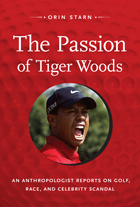 The Passion of Tiger Woods: An Anthropologist Reports on Golf, Race, and Celebrity Scandal
Orin Starn
Duke University Press, 2012 Perhaps the best golfer ever, Tiger Woods rocketed to the top of a once whites-only sport. Endorsements made him a global brand and the world’s richest athlete. The child of a multiracial marriage, Woods and his blond, blue-eyed wife, Elin Nordegren, seemed to represent a new postracial America. Then, in late 2009, Woods became embroiled in a sex scandal that made headlines worldwide. In this concise yet far-reaching analysis, Orin Starn brings an anthropologist’s perspective to bear on Tigergate. He explores our modern media obsession with celebrity scandals and their tawdry ritualized drama, yet he offers much more than the usual banal moralizing about the rich and famous. Starn explains how Tiger’s travails and the culture of golf reflect broader American anxieties—about race and sex, scapegoating and betrayal, and the role of the sports hero. The Passion of Tiger Woods is required reading for all those interested in the high-stakes world of professional golf, the politics of sports and celebrity, and the myths and realities surrounding the flawed yet riveting figure who remains among the most famous athletes of our time.
A Passion to Preserve: Gay Men as Keepers of Culture
Will Fellows
University of Wisconsin Press, 2005 From large cities to rural communities, gay men have long been impassioned pioneers as keepers of culture: rescuing and restoring decrepit buildings, revitalizing blighted neighborhoods, saving artifacts and documents of historical significance. A Passion to Preserve explores this authentic and complex dimension of gay men’s lives by profiling early and contemporary preservationists from throughout the United States, highlighting contributions to the larger culture that gays are exceptionally inclined to make.
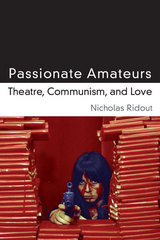 Passionate Amateurs: Theatre, Communism, and Love
Nicholas Ridout
University of Michigan Press, 2015 Passionate Amateurs tells a new story about modern theater: the story of a romantic attachment to theater’s potential to produce surprising experiences of human community. It begins with one of the first great plays of modern European theater—Chekhov’s Uncle Vanya in Moscow—and then crosses the 20th and 21st centuries to look at how its story plays out in Weimar Republic Berlin, in the Paris of the 1960s, and in a spectrum of contemporary performance in Europe and the United States. This is a work of historical materialist theater scholarship, which combines a materialism grounded in a socialist tradition of cultural studies with some of the insights developed in recent years by theorists of affect, and addresses some fundamental questions about the social function and political potential of theater within modern capitalism. Passionate Amateurs argues that theater in modern capitalism can help us think afresh about notions of work, time, and freedom. Its title concept is a theoretical and historical figure, someone whose work in theater is undertaken within capitalism, but motivated by a love that desires something different. In addition to its theoretical originality, it offers a significant new reading of a major Chekhov play, the most sustained scholarly engagement to date with Benjamin’s “Program for a Proletarian Children’s Theatre,” the first major consideration of Godard’s La chinoise as a “theatrical” work, and the first chapter-length discussion of the work of The Nature Theatre of Oklahoma, an American company rapidly gaining a profile in the European theater scene. Passionate Amateurs contributes to the development of theater and performance studies in a way that moves beyond debates over the differences between theater and performance in order to tell a powerful, historically grounded story about what theater and performance are for in the modern world.
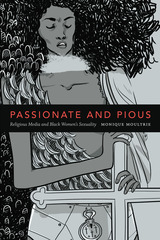 Passionate and Pious: Religious Media and Black Women's Sexuality
Monique Moultrie
Duke University Press, 2018 In Passionate and Pious Monique Moultrie explores the impact of faith-based sexual ministries on black women's sexual agency to trace how these women navigate sexuality, religious authority, and their spiritual walk with God. Providing churchwomen a space to candidly discuss these issues, these popular ministries exist largely beyond the traditional church, with dialogues about sex taking place in chat rooms and through text messages, social media, email, and other media. Moultrie foregrounds televangelist Juanita Bynum's construction of the black Christian sexual identity these ministries promote while emphasizing how churchwomen reconcile these prescriptive identities with their individual experiences. What does it mean for senior women to exercise sexual agency when their church standing could be questioned? What does celibacy mean for women who experience same-sex desire while believing that such desire goes against God's will? Advancing a womanist sexual ethics, Moultrie reframes biblical interpretations and conceptions of what constitutes a healthy relationship to provide a basis for sexual decision making that does not privilege monogamy or deny female pleasure, thereby calling on black churchwomen to experience responsible and life-enhancing sex.
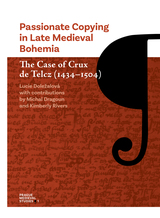 Passionate Copying in Late Medieval Bohemia: The Case of Crux de Telcz (1434–1504)
Lucie Doležalová
Karolinum Press, 2021 A case study of the unusual liberties taken by the fifteenth-century Bohemian scribe Crux of Telcz.
Passionate Copying in Late Medieval Bohemia addresses a unique case in the culture of manuscript transcription and textual transmission during the late fifteenth century, a transformative period in book history. This period is marked by the widespread intrusion of an unprecedented number of scribal paratexts—tables of contents, indices, explanatory notes, etc.—into transcribed manuscripts. To explore this development, the authors dig deep into a detailed case study of the Bohemian scribe Crux of Telč (1434–1504). Unlike most medieval copyists, who were stringent in their work even when inserting paratexts, Crux of Telč is notable for the extreme liberties he took with manuscript contents. Sometimes diligent, sometimes careless, his copies are notably rife with his own inventions and additions to the text. Crux’s life story is meticulously reconstructed in this book, relying on his colophons—the personal annotations left by medieval copyists to identify themselves and their circumstances—and other personal notes. The singularity of his approach to manuscripts is reinforced by the authors’ inclusion of a study of another late medieval scribe, Johannes Sintram of Würtzburg (d. 1450), whose scrivening is compared with that of Crux of Telč.
 Passionate Discontent: Creativity, Gender, and French Symbolist Art
Patricia Mathews
University of Chicago Press, 2000 Passionate Discontent is an erudite study of the relationship between gender and genius in late nineteenth-century French Symbolism. Born in an era of crisis, the Symbolist art movement was characterized by withdrawal to a mystical, antibourgeois world of the mind and spirit. While Symbolists idealized the "poète maudit," a creative, mad genius exhibiting an emotional state of heightened awareness and "passionate discontent," female artists displaying similar symptoms were dismissed as hysterical.
Art historian Patricia Mathews traverses the artistic, social, and scientific discourses of fin-de-siècle France in order to illuminate the Symbolist construction of a feminized aesthetic that nonetheless excluded female artists from its realm. Along the way, Mathews proffers important new readings of the art of such Symbolists as Gauguin, van Gogh and Moreau, as well as that of their female contemporaries Camille Claudel and Suzanne Valadon. Passionate Discontent is an important contribution to art historical and women's studies.
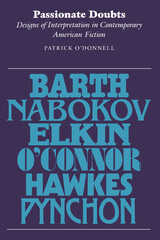 Passionate Doubts: Interpretation In Fiction
Patrick O'Donnell
University of Iowa Press, 1986 This absorbing new study discusses theories of interpretation and construction of the self in six important contemporary novels. In semiotic analyses of John Barth's LETTERS, Vladimir Nabokov's Pale Fire, John Hawkes' Travesty, Thomas Pynchon's Gravity's Rainbow, Stanley Elkin's The Franchiser, and Flannery O'Connor's Wise Blood, Patrick O'Donnell argues that contemporary fiction takes interpretation as its subject and as the very impetus for its making.
In an introductory dialogue and a closing chapter on the reader in contemporary fiction, O'Donnell shows that the formation of the reader's self, like character, plot, or any other element in fiction, is also part of the experience of the text, requiring a distinctive conception of interpretation. Calling upon a wide assemblage of modern theorists including Foucault, Derrida, Serres, Binswanger, Geertz, and Gadamer, O'Donnell elicits a broad range of interpretive possibilities—philosophical, psychological, archaeological, and linguistic—which speak to each novel's central concern with the act of reading as a form of signification.
While Passionate Doubts is broadly a hermeneutic study of contemporary fiction, the heart of this intriguing work resides in the close scrutiny of six modern novels which so richly evoke the very elements from which theories derive: language, form, and impulse. It is this specific application of theory that sets Passionate Doubts apart from other works in the field, yielding a series of important insights on the subject of language, sign, and the self in modern literature.
Passionate Fictions: Gender, Narrative, and Violence in Clarice Lispector
Marta Peixoto
University of Minnesota Press, 1994 Passionate Fictions was first published in 1994. Minnesota Archive Editions uses digital technology to make long-unavailable books once again accessible, and are published unaltered from the original University of Minnesota Press editions. "Clarice Lispector is the premiere Latin American woman prose writer of this century," Suzanne Ruta noted in the New York Times Book Review, "but because she is a woman and a Brazilian, she has remained virtually unknown in the United States." Passionate Fictions provides American readers with a critical introduction to this remarkable writer and offers those who already know Lispector's fiction a deeper understanding of its complex workings.
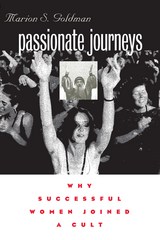 Passionate Journeys: Why Successful Women Joined a Cult
Marion S. Goldman
University of Michigan Press, 2001 Passionate Journeys explores the fascinating stories behind the Bhagwan Rajneesh phenomenon of the 1970s and 1980s, focusing on women who left families, careers, and identities to join the community of Rajneeshpuram. Rajneesh was a spiritual leader for thousands of young Americans, and in rural Oregon his devotees established a thriving community. Marion S. Goldman's extensive interviews with women who participated at Rajneeshpuram provide a fascinating picture of the cultural and social climate that motivated successful, established women to join such a movement. Passionate Journeys will appeal to specialists in feminist theory and women's studies, sociology, religious studies, American studies, and the history of the Northwest. Marion S. Goldman is Professor of Sociology, University of Oregon. She is also the author of Gold Diggers and Silver Miners: Prostitution and Social Life on the Comstock Lode.
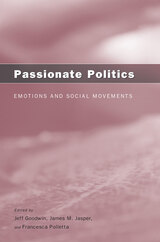 Passionate Politics: Emotions and Social Movements
Edited by Jeff Goodwin, James M. Jasper, and Francesca Polletta
University of Chicago Press, 2001 Emotions are back. Once at the center of the study of politics, emotions have receded into the shadows during the past three decades, with no place in the rationalistic, structural, and organizational models that dominate academic political analysis.
With this new collection of essays, Jeff Goodwin, James M. Jasper, and Francesca Polletta reverse this trend, reincorporating emotions such as anger, indignation, fear, disgust, joy, and love into research on politics and social protest. The tools of cultural analysis are especially useful for probing the role of emotions in politics, the editors and contributors to Passionate Politics argue. Moral outrage, the shame of spoiled collective identities, or the joy of imagining a new and better society, are not automatic responses to events. Rather, they are related to moral institutions, felt obligations and rights, and information about expected effects, all of which are culturally and historically variable.
With its look at the history of emotions in social thought, examination of the internal dynamics of protest groups, and exploration of the emotional dynamics that arise from interactions and conflicts among political factions and individuals, Passionate Politics will lead the way toward an overdue reconsideration of the role of emotions in social movements and politics generally.
Contributors:
Rebecca Anne Allahyari
Edwin Amenta
Collin Barker
Mabel Berezin
Craig Calhoun
Randall Collins
Frank Dobbin
Jeff Goodwin
Deborah B. Gould
Julian McAllister Groves
James M. Jasper
Anne Kane
Theodore D. Kemper
Sharon Erickson Nepstad
Steven Pfaff
Francesca Polletta
Christian Smith
Arlene Stein
Nancy Whittier
Elisabeth Jean Wood
Michael P. Young
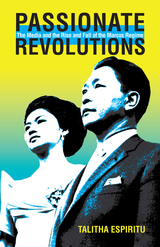 Passionate Revolutions: The Media and the Rise and Fall of the Marcos Regime
Talitha Espiritu
Ohio University Press, 2017 In the last three decades, the dictatorship of Ferdinand Marcos has commanded the close scrutiny of scholars. These studies have focused on the political repression, human rights abuses, debt-driven growth model, and crony capitalism that defined Marcos’ so-called Democratic Revolution in the Philippines. But the relationship between the media and the regime’s public culture remains underexplored. In Passionate Revolutions, Talitha Espiritu evaluates the role of political emotions in the rise and fall of the Marcos government. Focusing on the sentimental narratives and melodramatic cultural politics of the press and the cinema from 1965 to 1986, she examines how aesthetics and messaging based on heightened feeling helped secure the dictator’s control while also galvanizing the popular struggles that culminated in “people power” and government overthrow in 1986. In analyzing news articles, feature films, cultural policy documents, and propaganda films as national allegories imbued with revolutionary power, Espiritu expands the critical discussion of dictatorships in general and Marcos’s in particular by placing Filipino popular media and the regime’s public culture in dialogue. Espiritu’s interdisciplinary approach in this illuminating case study of how melodrama and sentimentality shape political action breaks new ground in media studies, affect studies, and Southeast Asian studies.
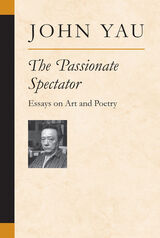 The Passionate Spectator: Essays on Art and Poetry
John Yau
University of Michigan Press, 2006 The Passionate Spectator collects essays, reviews, and art criticism by John Yau, an internationally lauded poet, critic, and curator. In this wide-ranging collection, Yau explores the intersection of art and poetry, dissolving boundaries between the artistic traditions and reimagining what it means to see and to write. Whether he is interpreting the poetic use of titles in Jessica Stockholder’s paintings, reviewing the collaborative book project between American poet Robert Creeley and German artist Georg Baselitz, or considering the significance of Frank O’Hara’s decision to have his portrait drawn wearing nothing but army boots, Yau is consistently daring, original, and contemporary.
Yau’s diverse critical sensibilities permeate The Passionate Spectator as he moves seamlessly between the visual and literary arts. Highlights of this collection include an essay on the poet as art critic, a study of the relationship between Kevin Young’s poetry and the paintings of Jean-Michel Basquiat, and an imaginative piece in which Yau speculates about what Jorge Luis Borges would have created had he been a visual artist. In the title essay, Yau lays out the duty of the spectator—a duty shared by viewer, reader, critic, and artist: “it is up to us to experience art, to engage and believe in its power.” .
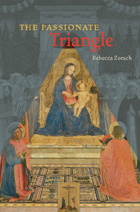 The Passionate Triangle
Rebecca Zorach
University of Chicago Press, 2011 Triangles abounded in the intellectual culture of early modern Europe—the Christian Trinity was often mapped as a triangle, for instance, and perspective, a characteristic artistic technique, is based on a triangular theory of vision. Renaissance artists, for their part, often used shapes and lines to arrange figures into a triangle on the surface of a painting—a practice modern scholars call triangular composition. But is there secret meaning in the triangular arrangements artists used, or just a pleasing symmetry? What do triangles really tell us about the European Renaissance and its most beguiling works of art? In this book, Rebecca Zorach takes us on a lively hunt for the triangle’s embedded significance. From the leisure pursuits of Egyptian priests to Jacopo Tintoretto’s love triangles, Zorach explores how the visual and mathematical properties of triangles allowed them to express new ideas and to inspire surprisingly intense passions. Examining prints and paintings as well as literary, scientific, and philosophical texts, The Passionate Triangle opens up an array of new ideas, presenting unexpected stories of the irrational, passionate, melancholic, and often erotic potential of mathematical thinking before the Scientific Revolution.
 A Passionate Usefulness: The Life and Literary Labors of Hannah Adams
Gary D. Schmidt
University of Virginia Press, 2004 In a literary environment dominated by men, the first American to earn a living as a writer and to establish a reputation on both sides of the Atlantic was, miraculously, a woman. Hannah Adams dared to enter--and in some ways was forced to enter--a sphere of literature that had, in eighteenth-century America, been solely a male province. Driven by poverty and necessity, and aided by an extraordinarily adept mind and keen sense of business, Adams authored works on New England history, sectarian history, and Jewish history, using and citing the most recent scholarly works being published in Great Britain and America. As a female writer, she would always remain something of an outsider, but her accomplishments did not by any means go unrecognized: embraced by the Boston intelligentsia and highly regarded throughout New England, Adams came to epitomize the possibility in a democratic society that anyone could rise to a circle of intellectual elites.
In A Passionate Usefulness, the first book-length biography of this remarkable figure, Gary Schmidt focuses primarily on the intimate connection between Adams's reading and her own literary work. Hers is the story of incipient scholarship in the new nation, the story of a dependence that evolved into intellectual independence. Schmidt sets Adams's works in the context of her early poverty and desperate family situation, her decade-long feud with one of New England's most powerful Calvinist ministers, her alliance with the budding Unitarian movement in Boston, and her work establishing the first evangelical mission to Palestine (a task she accomplished virtually single-handedly).
Today Adams still holds a place not only as a female writer who made her way economically in the book business before any other woman--or male writer--could do so, but also as a key figure in the transitional generation between the American Revolution and the Renaissance upon whose groundwork much of the country's later literature would build.
-----------------------------------------
Gary Schmidt is Professor of English at Calvin College and the coauthor, with Carol Winters, of Edging the Boundaries of Children's Literature.
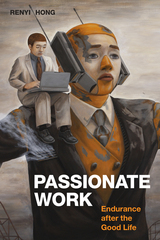 Passionate Work: Endurance after the Good Life
Renyi Hong
Duke University Press, 2022 In Passionate Work, Renyi Hong theorizes the notion of being “passionate about your work” as an affective project that encourages people to endure economically trying situations like unemployment, job change, repetitive and menial labor, and freelancing. Not simply a subject of aspiration, passion has been deployed as a means to build resilience and mend disappointments with our experiences of work. Tracking the rise of passion in nineteenth-century management to trends like gamification, coworking, and unemployment insurance, Hong demonstrates how passion can emerge in instances that would not typically be understood as passionate. Gamification numbs crippling boredom by keeping call center workers in an unthinking, suspensive state, pursuing even the most banal tasks in hope of career advancement. Coworking spaces marketed toward freelancers combat loneliness and disconnection at the precise moment when middle-class sureties are profoundly threatened. Ultimately, Hong argues, the ideal of passionate work sustains a condition of cruel optimism in which passion is offered as the solution for the injustices of contemporary capitalism.
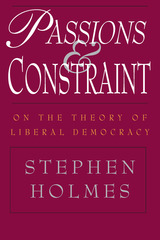 Passions and Constraint: On the Theory of Liberal Democracy
Stephen Holmes
University of Chicago Press, 1995 In this collection of essays on the core values of liberalism, Stephen Holmes—noted for his scathing reviews of books by liberalism's opponents—challenges commonly held assumptions about liberal theory. By placing it into its original historical context, Passions and Constraints presents an interconnected argument meant to fundamentally change the way we conceive of liberalism.
According to Holmes, three elements of classical liberal theory are commonly used to attack contemporary liberalism as antagonistic to genuine democracy and the welfare state: constitutional constraints on majority rule, the identification of individual freedom with an absence of government involvement, and a strong emphasis on the principle of self-interest. Through insightful essays on Hobbes's analysis of the English Civil War in Behemoth, Bodin's writings on the benefits of limited government, and Mill's views on science and politics, Holmes shows that these basic principles provide, to the contrary, a necessary foundation for the development of democratic, regulatory, and redistributionist politics in the modern era.
Holmes argues that the aspirations of liberal democracy—including individual liberty, the equal dignity of citizens, and a tolerance for diversity—are best understood in relation to two central themes of classical liberal theory: the psychological motivations of individuals and the necessary constraint on individual passions provided by institutions. Paradoxically, Holmes argues that such institutional restraints serve to enable, rather than limit, effective democracy.
In explorations of subjects ranging from self-interest to majoritarianism to "gag rules," Holmes shows that limited government can be more powerful than unlimited government—indeed, that liberalism is one of the most effective philosophies of state building ever contrived. By restricting the arbitrary powers of government officials, Holmes states, a liberal constitution can increase the state's capacity to focus on specific problems and mobilize collective resources for common purposes.
Passions and Constraint is an assessment of what that tradition has meant and what it can mean today.
Passions and Virtue
Servais Pinckaers
Catholic University of America Press, 2015 This book, the last that noted moral theologian Servais Pinckaers, OP, wrote before his death, was conceived as a follow-up to his previous work Plaidoyer pour la vertu (An Appeal for Virtue) (2007) Pinckaers' aim in Passions and Virtue was to show the positive and essential role that our emotions play in the life of virtue. His purpose is part of a larger project of renewing moral theology, a theology too often experienced as an ethics of obligation rather than as a practical guide to living virtuously. To this end, Pinckaers sketches a positive psychology of the passions as found in the biblical tradition, in the writings of the Fathers of the Church, in pagan authors and, especially, in the writings of Saint Thomas Aquinas.
 The Passions of Peter Sellars: Staging the Music
Susan McClary
University of Michigan Press, 2019 Recognized as one of the most innovative and influential directors of our time, Peter Sellars has produced acclaimed—and often controversial—versions of many beloved operas and oratorios. He has also collaborated with several composers, including John C. Adams and Kaija Saariaho, to create challenging new operas. The Passions of Peter Sellars follows the development of his style, beginning with his interpretations of the Mozart-Da Ponte operas, proceeding to works for which he assembled the libretti and even the music, and concluding with his celebrated stagings of Bach’s passions with the Berlin Philharmonic.
Many directors leave the musical aspects of opera entirely to the singers and conductor. Sellars, however, immerses himself in the score, and has created a distinctive visual vocabulary to embody musical gesture on stage, drawing on the energies of the music as he shapes characters, ensemble interaction, and large-scale dramatic trajectories. As a leading scholar of gender and music, and the history of opera, Susan McClary is ideally positioned to illuminate Sellars’s goal to address both the social tensions embodied in these operas as well as the spiritual dimensions of operatic performance. McClary considers Sellars’s productions of Mozart’s Le nozze di Figaro, Don Giovanni, and Così fan tutte; Handel’s Theodora; Messiaen’s Saint François d’Assise; John C. Adams’s Nixon in China, The Death of Klinghoffer, El Niño, and Doctor Atomic; Kaija Saariaho’s L’amour de loin, La Passion de Simone, and Only the Sound Remains; Purcell’s The Indian Queen; and Bach’s passions of Saint Matthew and Saint John. Approaching Sellars’s theatrical strategies from a musicological perspective, McClary blends insights from theater, film, and literary scholarship to explore the work of one of the most brilliant living interpreters of opera.
 Passions Pedagogies and 21st Century Technologies
edited by Gail E. Hawisher & Cynthia L. Selfe
Utah State University Press, 1999 Gail Hawisher and Cynthia Selfe created a volume that set the agenda in the field of computers and composition scholarship for a decade. The technology changes that scholars of composition studies faced as the new century opened couldn't have been more deserving of passionate study. While we have always used technologies (e.g., the pencil) to communicate with each other, the electronic technologies we now use have changed the world in ways that we have yet to identify or appreciate fully. Likewise, the study of language and literate exchange, even our understanding of terms like literacy, text, and visual, has changed beyond recognition, challenging even our capacity to articulate them.
As Hawisher, Selfe, and their contributors engage these challenges and explore their importance, they "find themselves engaged in the messy, contradictory, and fascinating work of understanding how to live in a new world and a new century." The result is a broad, deep, and rewarding anthology of work still among the standard works of computers and composition study.
Passive Radars on Moving Platforms
Diego Cristallini
The Institution of Engineering and Technology, 2023 This book collects, reviews and analyses recent research on passive radars on moving platforms. Due to the nature of the typical radar applications performed by moving platforms and the signals of opportunity typically exploited for passive radar purposes, which are not designed for reception while in motion, the special case of passive radar mounted on moving platforms is highly challenging.
Passive Sentences in English and Portuguese
Milton M. Azevedo
Georgetown University Press, 1980 This study analyzes passive sentences in English and Portuguese which result from a post-semantic transformation applied when a nound, which does not play the semantic role of actor, is chosen as syntactic subject. Choice between a passive and its non-passive or active counterpart reflects differences in the distribution of information in the sentence as regards the relative importance of the latter's constituents for communication. Such distribution is analyzed in terms of Praque school theory, especially that involving the notions of communicative dynamism and the distribution of theme and rheme. The book concludes with a contrastive analysis of English and Portuguese passive sentence patterns which serves as the basis for observations on the teaching of Portuguese passives to native speakers of English.
A Passover Haggadah
Rabbi Herbert Bronstein
Central Conference of American Rabbis This classic Haggadah has sold over 1 million copies since its introduction. Illustrated with twenty-three original full-color watercolors by Leonard Baskin and written in contemporary, gender-inclusive language, it contains a complete Passover home service, an extensive song section, and supplemental readings and meditations from which participants can choose during the course of the Seder. All optional selections are printed in color.
A Passover Haggadah - Russian-Hebrew Edition
Rabbi Herbert Bronstein
Central Conference of American Rabbis, 1982 This black and white edition follows the same design, format, and layout as its English counterpart: Russian passages exactly follow the placement of their English equivalents, including transliterations of all blessings.
 The Passport as Home: Comfort in Rootlessness
Andrei S. Markovits
Central European University Press, 2021 A Scholar's Quest for Home and Identity Experience the remarkable story of a Romanian-born, Hungarian-speaking Jewish professor. From Vienna to Columbia and Harvard, he navigates a life marked by rootlessness, seeking comfort and purpose. His journey unfolds against the backdrop of five decades, two continents, and significant political and cultural changes. As we follow his pursuit of a home, we gain insight into the critical developments of post-1945 Europe and America. Markovits's emigration experiences, first from Romania to Vienna and later from Vienna to New York, shed light on the challenges he faced. His journey offers a panoramic view of the forces shaping the latter half of the 20th century. Despite America's flaws, he finds it a beacon of academic excellence, intellectual openness, cultural diversity, and religious tolerance—qualities that Europe lacked.
Explore the complexities of identity, culture, and the universal search for belonging in this captivating narrative.
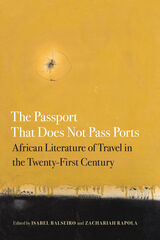 The Passport That Does Not Pass Ports: African Literature of Travel in the Twenty-First Century
Isabel Balseiro
Michigan State University Press, 2020 These seventeen pieces on travel in Africa by leading African authors take readers to places at once homelike and foreign. Against the tropes of travel writing, this book offers the acuity of vision of particular types of travelers. These are travelers whose mother tongue may find the hint of familiarity across otherwise unintelligible languages and for whom a foreign land isn’t necessarily strange; in it they perceive vestiges of the familiar. For them, the act of traveling extends a canvas on which to depict someone else’s reality—a reality never too distant from their own. What makes these writings coalesce is a reflection about the act of being in motion, about reconfiguring place; a consciousness of how geography redirects the focus of one’s gaze and, in turn, how that altered gaze filters inward. Having absorbed the landscape, inhaled the scents, paid heed to accents, and accepted the condition of being out of place, these travelers reconstitute individual consciousness and join a collective sense of existing beyond borders. Place inhabits this renewed sense of self; literature enables its expression. An inviting introduction to travel writing on Africa, The Passport That Does Not Pass Ports is absorbing reading for travelers and students of literature alike.
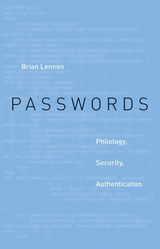 Passwords: Philology, Security, Authentication
Brian Lennon
Harvard University Press, 2018 Cryptology, the mathematical and technical science of ciphers and codes, and philology, the humanistic study of natural or human languages, are typically understood as separate domains of activity. But Brian Lennon contends that these two domains, both concerned with authentication of text, should be viewed as contiguous. He argues that computing’s humanistic applications are as historically important as its mathematical and technical ones. What is more, these humanistic uses, no less than cryptological ones, are marked and constrained by the priorities of security and military institutions devoted to fighting wars and decoding intelligence.
Lennon’s history encompasses the first documented techniques for the statistical analysis of text, early experiments in mechanized literary analysis, electromechanical and electronic code-breaking and machine translation, early literary data processing, the computational philology of late twentieth-century humanities computing, and early twenty-first-century digital humanities. Throughout, Passwords makes clear the continuity between cryptology and philology, showing how the same practices flourish in literary study and in conditions of war.
Lennon emphasizes the convergence of cryptology and philology in the modern digital password. Like philologists, hackers use computational methods to break open the secrets coded in text. One of their preferred tools is the dictionary, that preeminent product of the philologist’s scholarly labor, which supplies the raw material for computational processing of natural language. Thus does the historic overlap of cryptology and philology persist in an artifact of computing—passwords—that many of us use every day.
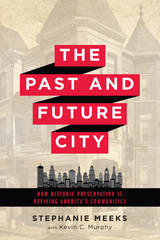 The Past and Future City: How Historic Preservation is Reviving America's Communities
Stephanie Meeks with Kevin C. Murphy
Island Press, 2016 At its most basic, historic preservation is about keeping old places alive, in active use, and relevant to the needs of communities today. As cities across America experience a remarkable renaissance, and more and more young, diverse families choose to live, work, and play in historic neighborhoods, the promise and potential of using our older and historic buildings to revitalize our cities is stronger than ever.
This urban resurgence is a national phenomenon, boosting cities from Cleveland to Buffalo and Portland to Pittsburgh. Experts offer a range of theories on what is driving the return to the city—from the impact of the recent housing crisis to a desire to be socially engaged, live near work, and reduce automobile use. But there’s also more to it. Time and again, when asked why they moved to the city, people talk about the desire to live somewhere distinctive, to be some place rather than no place. Often these distinguishing urban landmarks are exciting neighborhoods—Miami boasts its Art Deco district, New Orleans the French Quarter. Sometimes, as in the case of Baltimore’s historic rowhouses, the most distinguishing feature is the urban fabric itself.
While many aspects of this urban resurgence are a cause for celebration, the changes have also brought to the forefront issues of access, affordable housing, inequality, sustainability, and how we should commemorate difficult history. This book speaks directly to all of these issues.
In The Past and Future City, Stephanie Meeks, the president of the National Trust for Historic Preservation, describes in detail, and with unique empirical research, the many ways that saving and restoring historic fabric can help a city create thriving neighborhoods, good jobs, and a vibrant economy. She explains the critical importance of preservation for all our communities, the ways the historic preservation field has evolved to embrace the challenges of the twenty-first century, and the innovative work being done in the preservation space now.
This book is for anyone who cares about cities, places, and saving America’s diverse stories, in a way that will bring us together and help us better understand our past, present, and future.
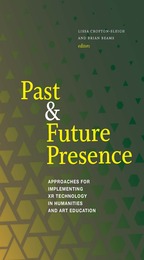 Past and Future Presence: Approaches for Implementing XR Technology in Humanities and Art Education
Lissa Crofton-Sleigh and Brian Beams, editors
Amherst College Press, 2024 While uses and studies of XR technology within STEM-based education have been plentiful in recent years, there has been lesser or even, at times, a lack of coverage for this novel learning tool in the arts and humanities.Past and Future Presence aims to bridge some of that gap by presenting research-based theory and case studies of successful application and implementation of XR technology into postsecondary educational settings, ranging in topics from ancient to modern languages, classical and contemporary art, and reenvisioned historical scenes and events presented in ways never seen before. The studies also contemplate how this novel medium can enhance and supplement learning in classrooms and other formal or informal learning environments. The volume as a whole is intended to demonstrate to educators, scholars, and researchers in higher education the potential value of integrating XR technology into their classrooms and to provide a strong argument for college and university administrators to invest in training and development of new research and content for classrooms inside and outside of STEM. The authors of these chapters come from a diverse range of backgrounds at different stages of their careers, providing a broad crosssection of scholastic work within the humanities and arts. Each chapter offers a different angle or approach to incorporating XR technology into teaching or research within different subject areas. As the volume suggests, this technology also places additional emphasis on the humanity within the humanities, by focusing on increasing connection between users and different cultures, time periods, and perspectives.
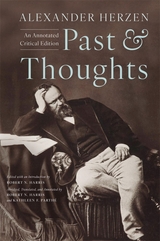 Past and Thoughts: An Annotated Critical Edition
Alexander Herzen
Harvard University Press An annotated translation of Alexander Herzen’s monumental memoir Past and Thoughts—the first new English-language edition in a century—captures the tumultuous life and penetrating cultural and political insights of the writer widely regarded as the founder of Russian socialism.
Isaiah Berlin called Alexander Herzen’s magnum opus, Past and Thoughts, “a literary masterpiece worthy to be placed by the side of the novels of . . . Tolstoy, Turgenev, Dostoevsky.” It was the most influential memoir published in nineteenth-century Russia, and its impact extended far beyond the tsarist era and the empire’s borders, inspiring generations of thinkers, leaders, and dissidents struggling against authoritarian regimes. The first English-language translation in a century, thoroughly annotated with a new introduction, this volume shows why Past and Thoughts is considered a great classic.
Against a dramatic backdrop of war, revolution, and exile, Herzen tells a stirring story of political agitation, marital scandal, betrayal, and despair. Past and Thoughts begins with Napoleon’s invasion of Moscow during Herzen’s infancy, then follows the author’s central role in Russia’s emerging intelligentsia, his imprisonment and exile in the frozen north, his adventures across a mid-century Europe undergoing the turbulence of revolution and unification, and his founding of the first uncensored Russian-language press. We see the Paris revolts of 1848 and the flamboyant swashbucklers of Italy’s Risorgimento through Herzen’s sharp eyes, alongside his bold journalism, which reached both the tsar’s prisoners and the Winter Palace.
This edition restores a key section on the tragic denouement of Herzen’s marriage—omitted from previous abridged versions—and includes notes offering critical insight into Herzen’s historical sketches, travelogues, satire, poetry, philosophical excursions, and polemics. Tolstoy remarked that “Herzen awaits his readers in the future.” A piercing investigation of the human spirit and its enemies, Past and Thoughts is indeed a work for our time.
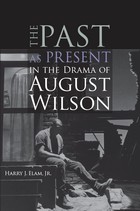 The Past as Present in the Drama of August Wilson
Harry J. Elam, Jr.
University of Michigan Press, 2004
Pulitzer-prizewinning playwright August Wilson, author of Fences, Ma Rainey's Black Bottom, and The Piano Lesson, among other dramatic works, is one of the most well respected American playwrights on the contemporary stage. The founder of the Black Horizon Theater Company, his self-defined dramatic project is to review twentieth-century African American history by creating a play for each decade.
Theater scholar and critic Harry J. Elam examines Wilson's published plays within the context of contemporary African American literature and in relation to concepts of memory and history, culture and resistance, race and representation. Elam finds that each of Wilson's plays recaptures narratives lost, ignored, or avoided to create a new experience of the past that questions the historical categories of race and the meanings of blackness.
Harry J. Elam, Jr. is Professor of Drama at Stanford University and author of Taking It to the Streets: The Social Protest Theater of Luis Valdez and Amiri Baraka (The University of Michigan Press).
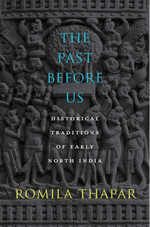 The Past Before Us: Historical Traditions of Early North India
Romila Thapar
Harvard University Press, 2013 “An authority on thousands of years of India’s past, Thapar has a rare and special perspective on the country it was and the country it is becoming.” —Financial Times
Winner of the Kluge Prize Romila Thapar presents a sweeping survey of the historical traditions of North India, revealing a deep consciousness of history embedded in classical Indian literature.
The claim, often made, that India—uniquely among civilizations—lacks historical writing distracts us from a more pertinent question, according to Romila Thapar: how to recognize the historical sense of societies whose past is recorded in ways very different from European conventions. In The Past Before Us, a distinguished scholar of ancient India guides us through a panoramic survey of the historical traditions of North India. Thapar reveals a deep and sophisticated consciousness of history embedded in the diverse body of classical Indian literature.
The history recorded in such texts as the Ramayana and the Mahabharata is less concerned with authenticating persons and events than with presenting a picture of traditions striving to retain legitimacy and continuity amid social change. Spanning an epoch of nearly twenty-five hundred years, from 1000 BCE to 1400 CE, Thapar delineates three distinct historical traditions: an Itihasa-Purana tradition of Brahman authors; a tradition composed mainly by Buddhist and Jaina scholars; and a popular bardic tradition. The Vedic corpus, the epics, the Buddhist canon and monastic chronicles, inscriptions, regional accounts, and royal biographies and dramas are all scrutinized afresh—not as sources to be mined for factual data but as genres that disclose how Indians of ancient times represented their own past to themselves.
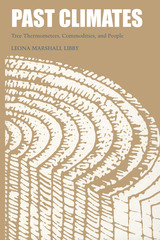 Past Climates: Tree Thermometers, Commodities, and People
By Leona Marshall Libby
University of Texas Press, 1983 Leona Marshall Libby was a pioneer in modern climatic research, a field that gained great impetus in the late twentieth century because of the promise it holds for predicting future climatic trends. Libby’s work led to remarkable new procedures for investigating long-term changes in precipitation and temperature and thereby greatly expanding our knowledge of past climates. As Professor Rainer Berger writes in his foreword: “In recent years, tree ring–based temperature data have been collected which go far beyond the records available to historians. These data can be analyzed by Fourier transforms which identify certain periodicities. . . . Climatic changes detected by tree rings have been checked against historic records. . . . The correspondence is astonishing. . . . “At present weather forecasting is becoming more accurate for periods on the order of days, weeks, and months. Climatic prognoses have also been attempted for very long times of tens of thousands of years. But the intermediate range in the decades and centuries has so far been an enigma. It is here where tree ring thermometry plays its trump cards. “. . . Its potential is enormous in assessing worldwide crop yields, water inventory, heating requirements, stockpiling policies, and construction planning as well as political and military prospects.”
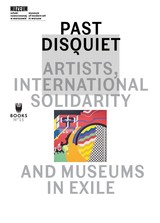 Past Disquiet: Artists, International Solidarity and Museums in Exile
Edited by Kristine Khouri and Rasha Salti
Museum of Modern Art in Warsaw, 2018 The International Art Exhibition for Palestine took place in Beirut in 1978 and mobilized international networks of artists in solidarity with anti-imperialist movements of the 1960s and ’70s. In that era, individual artists and artist collectives assembled collections; organized touring exhibitions, public interventions and actions; and collaborated with institutions and political movements. Their aim was to lend support and bring artistic engagement to protests against the ongoing war in Vietnam, the Pinochet dictatorship in Chile, and the apartheid regime in South Africa, and they were aligned in international solidarity for anti-colonial struggles. Past Disquiet brings together contributions from scholars, curators and writers who reflect on these marginalized histories and undertakings that took place in Baghdad, Beirut, Belgrade, Damascus, Paris, Rabat, Tokyo, and Warsaw. The book also offers translations of primary texts and recent interviews with some of the artists involved.
 Past for the Eyes: East European Representations of Communism in Cinema and Museums After 1989
Oksana Sarkisova
Central European University Press, 2008 How do museums and cinema shape the image of the Communist past in today’s Central and Eastern Europe? This volume is the first systematic analysis of how visual techniques are used to understand and put into context the former regimes. After history “ended” in the Eastern Bloc in 1989, museums and other memorials mushroomed all over the region. These efforts tried both to explain the meaning of this lost history, as well as to shape public opinion on their society’s shared post-war heritage. Museums and films made political use of recollections of the recent past, and employed selected museum, memorial, and media tools and tactics to make its political intent historically credible. Thirteen essays from scholars around the region take a fresh look at the subject as they address the strategies of fashioning popular perceptions of the recent past.
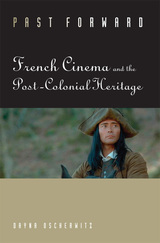 Past Forward: French Cinema and the Post-Colonial Heritage
Dayna Oscherwitz
Southern Illinois University Press, 2010 In Past Forward: French Cinema and the Post-Colonial Heritage, author Dayna Oscherwitz focuses on the world of French films with a new lens. Drawing upon a wealth of research and the examination of popular French movies, Oscherwitz offers fresh perspectives not only on the unique importance of motion pictures and their indelible influence on French character, but on current debates regarding individual and collective memory.
Past Forward traces the development and ascension of the French heritage film—those historical and costume dramas focusing on prestigious French subjects, events, and settings. These motion pictures, preeminent during a period of globalization and fear over the affects of immigration in 1980s France, quickly came to embody a specific version of French national and collective identity: one that idealized the past, condemned the present, and created an institutional form of memory. Oscherwitz presents the intriguing notion that French heritage films are not exclusively expressions of nationalism and nostalgia as has commonly been asserted. On the contrary, although these movies were born out of a perceived loss of French culture, their ambivalence toward traditional hallmarks of nationalism opens them up to new interpretation. Also in contrast to typical conceptions, the author suggests that these heritage films are far from cinematic bastions of multicultural backlash; instead, she argues, popular culture has in its own fashion reinserted the history of colonialism and immigration into the national past, thus reimagining heritage itself. Against this backdrop, Oscherwitz goes on to investigate the multicultural worlds of beur and banlieue movies—cinema seemingly in direct contrast with the heritage film—offering the theory that these films serve as a “countermemory” to an institutionalized one and provide alternative models of collective memory and identity. Through careful analysis of several examples, Oscherwitz demonstrates how these two seemingly different realms—heritage and multicultural cinema—are far from mutually exclusive in the construction of French identity. Throughout the volume, numerous well-known French movies are reexamined, inviting new interpretations of and challenging old views through investigations of familiar cinematic works. Past Forward is arevolutionary volume that boldly reimagines our ideas about French film and its role in communicating history and memory.
 Past Imperfect: Essays on History, Libraries, and the Humanities
Lawrence W. Towner
University of Chicago Press, 1993 Lawrence W. Towner was head of one of the country's largest independent research libraries. He was also an eloquent spokesman for the needs of scholars and institutions in the humanities. While at the Newberry Library, he built and focused its prestigious collections, pioneered in the preservation of books, and created major research centers. His efforts established the library as a community of scholars while encouraging its use by students and the general public.
Towner's essays and talks cover a broad range of topics of continuing relevance to scholarship and the humanities. His writings gathered in Past Imperfect are concerned with such issues as the role of independent research libraries and the politics of funding. A section of historical essays on the common people of New England reveal his concern with neglected fields of history, a theme that guided his career as a librarian. Spanning the range of his experience and expertise, this volume expresses Towner's coherent vision of the place of humanities, libraries, and scholarship in American life.
Lawrence W. Towner (1921-92) taught history at M.I.T., the College of William and Mary, and Northwestern University. In 1962 he was appointed librarian of the Newberry Library and directed the library for the next twenty-four years.
The Past in Ruins: Tradition and the Critique of Modernity
David Gross
University of Massachusetts Press, 1992 We are currently updating our website and have not yet posted complete information for this title. Many of our books are in the Google preview program, which allows readers to view up to 20% of the book. If this title is active in the program, you will find the Google Preview button in the sidebar below.
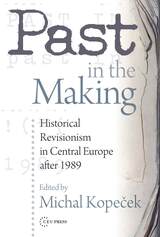 Past in the Making: Historical Revisionism in Central Europe After 1989
Michal Kopecek
Central European University Press, 2008 Historical revisionism, far from being restricted to small groups of ‘negationists,’ has galvanized debates in the realm of recent history. The studies in this book range from general accounts of the background of recent historical revisionism to focused analyses of particular debates or social-cultural phenomena in individual Central European countries, from Germany to Ukraine and Estonia. Where is the borderline between legitimate re-examination of historical interpretations and attempts to rewrite history in a politically motivated way that downgrades or denies essential historical facts? How do the traditional ‘national historical narratives’ react to the ‘spill-over’ of international and political controversies into their ‘sphere of influence’? Technological progress, along with the overall social and cultural decentralization shatters the old hierarchies of academic historical knowledge under the banner of culture of memory, and breeds an unequalled democratization in historical representation. This book offers a unique approach based on the provocative and instigating intersection of scholarly research, its political appropriations, and social reflection from a representative sample of Central and East European countries.
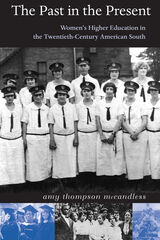 The Past in the Present: Women's Higher Education in the Twentieth-Century American South
Amy T. McCandless
University of Alabama Press, 1999 The history of higher education in the 20th-century South, like the history of the region, both mirrors and diverges from the national pattern. Not surprisingly the region’s demographic, economic, social, political, and cultural characteristics have accounted for many of the variations between the education of southern women and women in the rest of the nation. Southern students, McCandless finds, have generally been more Protestant, more rural, more conservative, and less affluent than their northern and western counterparts. Southern institutions have been slower to raise matriculation and graduation standards and to revise the classical curriculum. Southern administrators and legislators have opposed coeducation and integration longer and harder than college officials elsewhere. Certain types of institutions, such as all-black colleges, public women’s colleges, and separate agricultural colleges, have been more prevalent in the South. Although many of these differences are not gender-specific, all have contributed to the distinctive educational experience of women in this region. Much has been written on the distinctiveness of this region, but virtually nothing has been published on the education of women in the South. By focusing on both black and white women at a wide variety of institutions and drawing on oral interviews and campus publications as well as traditional histories, McCandless is able to construct a more detailed picture of women’s collegiate experiences in the 20th-century South than those provided by general studies that rely primarily on materials from the North and Midwest.
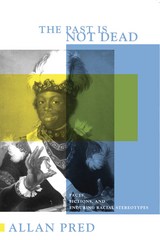 Past Is Not Dead: Facts, Fictions, and Enduring Racial Stereotypes
Allan Pred
University of Minnesota Press, 2004 A study of the genealogy and perpetuation of stereotyping Through one figure—Badin, an eighteenth-century Afro-Caribbean slave given to the Swedish royal court—Allan Pred shows how stereotypes endure through the repeated confusion of facts and fiction, providing a highly original perspective on the perpetuation of racializing stereotypes in the West. In the first of two interlocking montages inspired by Walter Benjamin, the book focuses on Badin, who died in Stockholm in 1822, and representations of his life that appeared from the 1840s through the 1990s. In the second montage, Pred brings the late nineteenth century and the present into play, shifting to urban sites where racialized stereotyping is on public display, including a museum that has exhibited the bodily remains of the African male.Intriguing for its insight into the workings of race and immigration on the national imagination of a European nation—but with implications and ramifications far beyond that specific example— The Past Is Not Dead is a bold inquiry into both the collective memory and the amnesia of those who stereotype versus the personal remembering and forgetting of the stereotyped.
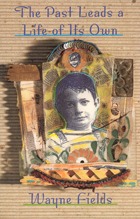 The Past Leads a Life of Its Own
Wayne Fields
University of Chicago Press, 1997 The Past Leads a Life of Its Own is a compelling collection of stories centered around one boy's childhood in the rural midwest in the 1950s, his love of nature, his family, and their often nomadic existence.
"Going through these pages quickly would be like chug-a-lugging a jar of honey fresh from the comb, or wolfing down a slow-cured, hickory-smoked country ham. It is a rich and complexly flavored work of fiction, a book to be savored."—Harper Barnes, St. Louis Post-Dispatch
"Set against the rhythms of nature, Fields's 16 luminous, interrelated stories celebrate a boy's coming-of-age. . . . The beauty of these deeply felt stories lies in their spare, ear-perfect language and in quiet epiphanies."—Publishers Weekly
"[A] beautifully subtle work. . . . Here are a series of vignettes, each capturing some moment in nature, poetic and ethereal. . . . [They] are like stones skipping on water, capturing the struggles of a family leaving one way of life behind for another, Fields remembers the feeling of a time and a place gone forever."—Library Journal
 Past Presented: Archaeological Illustration and the Ancient Americas
Joanne Pillsbury
Harvard University Press, 2012 Illustrations remain one of the fundamental tools of archaeology, a means by which we share information and build ideas. Often treated as if they were neutral representations, archaeological illustrations are the convergence of science and the imagination. This volume, a collection of fourteen essays addressing the visual presentation of the Pre-Columbian past from the fifteenth century to the present day, explores and contextualizes the visual culture of archaeological illustration, addressing the intellectual history of the field and the relationship of archaeological illustration to other scientific disciplines and the fine arts. One of the principal questions raised by this volume is how do archaeological illustrations, which organize complex sets of information, shape the construction of knowledge? These visual and conceptual constructions warrant closer scrutiny: they matter, they shape our thinking. Archaeological illustrations are a mediation of vision and ideas, and the chapters in this volume consider how visual languages are created and how they become institutionalized. Past Presented: Archaeological Illustration and the Ancient Americas is about the ways in which representations illuminate the concerns and possibilities of a specific time and place and how these representations, in turn, shaped the field of archaeology.
 Past Scents: Historical Perspectives on Smell
Jonathan Reinarz
University of Illinois Press, 2014 In this comprehensive and engaging volume, medical historian Jonathan Reinarz offers a historiography of smell from ancient to modern times. Synthesizing existing scholarship in the field, he shows how people have relied on their olfactory sense to understand and engage with both their immediate environments and wider corporal and spiritual worlds. This broad survey demonstrates how each community or commodity possesses, or has been thought to possess, its own peculiar scent. Through the meanings associated with smells, osmologies develop--what cultural anthropologists have termed the systems that utilize smells to classify people and objects in ways that define their relations to each other and their relative values within a particular culture. European Christians, for instance, relied on their noses to differentiate Christians from heathens, whites from people of color, women from men, virgins from harlots, artisans from aristocracy, and pollution from perfume. This reliance on smell was not limited to the global North. Around the world, Reinarz shows, people used scents to signify individual and group identity in a morally constructed universe where the good smelled pleasant and their opposites reeked. With chapters including "Heavenly Scents," "Fragrant Lucre," and "Odorous Others," Reinarz's timely survey is a useful and entertaining look at the history of one of our most important but least-understood senses.
The Past That Poets Make
Harold Toliver
Harvard University Press, 1981 This is an analysis of the literary art of recapturing the past as the artist perceives it. By clearly distinguishing different ways of creating a past--in fiction, history, and other arts--Toliver enriches our understanding of literary strategies.
The Past that Poets Make examines such questions as how a fictional narrative differs from other ways of seeing a past time; to what extent literature is nontemporal, transcending its time, and to what extent it is tied to the institutions and traditions of its era; how given works conjure up a sense of time; and how fictional narratives function as transmitters of ideas to societies prepared to absorb them.
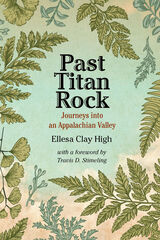 Past Titan Rock: Journeys into an Appalachian Valley
Ellesa Clay High
West Virginia University Press, 2021 A classic book about Appalachian life and music, now updated with new material.
Past Titan Rock, a winner of the Appalachian Award for Literature, is available in a new edition as part of the series Sounding Appalachia, with an introduction by series editor Travis D. Stimeling.
In 1977 Ellesa Clay High thought she would spend an afternoon interviewing Lily May Ledford, best known as the lead performer of an all-female string band that began playing on the radio in the 1930s. That meeting began an unexpected journey leading into the mountains of eastern Kentucky and a hundred years into the past. Set in Red River Gorge, an area of steep ridges and box canyons, Past Titan Rock is a multigenre, multivocal re-creation of life in that region. With Ledford’s guidance, High traveled and lived in the gorge, visiting with people who could remember life there before the Works Progress Administration built roads across the ridges and into the valleys during the New Deal. What emerges through a unique combination of personal essay, oral history, and short fiction is a portrait of a mountain culture rich in custom, oral tradition, and song. Past Titan Rock demonstrates the depth of community ties in the Red River Gorge and raises important questions about how to resist destructive forces today.
Pasta, Pizza and Propaganda: A Political History of Italian Food TV
Francesco Buscemi
Intellect Books, 2021 The history of Italy since the mid-1950s retold through the lens of food television.
In this dynamic interdisciplinary study at the intersection of food studies, media studies, and politics, Francesco Buscemi explores the central role of food in Italian culture through a political history of Italian food on national television. A highly original work of political history, the book tells the story of Italian food television from a political point of view: from the pioneering shows developed under strict Catholic control in the 1950s and 1960s to the left-wing political twists of the 1970s, the conservative riflusso or resurgence of the 1980s, through the disputed Berlusconian era, and into the contemporary rise of the celebrity chef. Through this lively and engaging work, we learn that cooking spaghetti in a TV studio is a political act, and by watching it, we become citizens.
Pasternak's "Dr. Zhivago": A Critical Companion
Edith W. Clowes
Northwestern University Press, 1995 This book, part of the acclaimed AATSEEL Critical Companions series, is designed to guide readers through Doctor Zhivago, Boris Pasternak's classic story of the Russian Revolution and its aftermath. An introduction places the novel and its author within Russian history and literature, and essays by scholars offer opinion and analysis of Pasternak's method and thought. Finally, there is correspondence relating to the novel and a bibliography chosen by the editor.
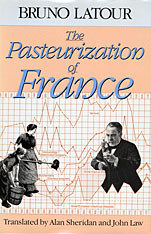 The Pasteurization of France
Bruno Latour
Harvard University Press, 1993 What can one man accomplish, even a great man and brilliant scientist? Although every town in France has a street named for Louis Pasteur, was he alone able to stop people from spitting, persuade them to dig drains, influence them to undergo vaccination? Pasteur’s success depended upon a whole network of forces, including the public hygiene movement, the medical profession (both military physicians and private practitioners), and colonial interests. It is the operation of these forces, in combination with the talent of Pasteur, that Bruno Latour sets before us as a prime example of science in action.
Latour argues that the triumph of the biologist and his methodology must be understood within the particular historical convergence of competing social forces and conflicting interests. Yet Pasteur was not the only scientist working on the relationships of microbes and disease. How was he able to galvanize the other forces to support his own research? Latour shows Pasteur’s efforts to win over the French public—the farmers, industrialists, politicians, and much of the scientific establishment.
Instead of reducing science to a given social environment, Latour tries to show the simultaneous building of a society and its scientific facts. The first section of the book, which retells the story of Pasteur, is a vivid description of an approach to science whose theoretical implications go far beyond a particular case study. In the second part of the book, “Irreductions,” Latour sets out his notion of the dynamics of conflict and interaction, of the “relation of forces.” Latour’s method of analysis cuts across and through the boundaries of the established disciplines of sociology, history, and the philosophy of science, to reveal how it is possible not to make the distinction between reason and force. Instead of leading to sociological reductionism, this method leads to an unexpected irreductionism.
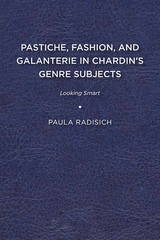 Pastiche, Fashion, and Galanterie in Chardin’s Genre Subjects: Looking Smart
Paula Radisich
University of Delaware Press, 2014 Pastiche, Fashion and Galanterie in Chardin’s Genre Subjects seeks to understand how Chardin’s genre subjects were composed and constructed to communicate certain things to the elites of Paris in the 1730s and 1740s. The book argues against the conventional view of Chardin as the transparent imitator of bourgeois life and values so ingrained in art history since the nineteenth century. Instead, it makes the case that these pictures were crafted to demonstrate the artist’s wit (esprit) and taste, traits linked to conventions of seventeenth-century galanterie. Early eighteenth-century Moderns like Jean-Siméon Chardin (1699–1779) embraced an aesthetic grounded upon a notion of beauty that could not be put into words—the je ne sais quoi. Despite its vagueness, this model of beauty was drawn from the present, departed from standards of formal beauty, and could only be known through the critical exercise of taste. Though selecting subjects from the present appears to be a simple matter, it was complicated by the fact that the modernizers expressed themselves through the vehicles of older, established forms. In Chardin’s case, he usually adapted the forms of seventeenth-century Dutch and Flemish genre painting in his genre subjects. This gambit required an audience familiar enough with the conventions of Lowlands art to grasp the play involved in a knowing imitation, or pastiche. Chardin’s first group of enthusiasts accordingly were collectors who bought works of living French artists as well as Dutch and Flemish masters from the previous century, notably aristocratic connoisseurs like the chevalier Antoine de la Roque and Count Carl-Gustaf Tessin.
Published by University of Delaware Press. Distributed worldwide by Rutgers University Press.
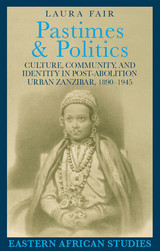 Pastimes and Politics: Culture, Community, and Identity in Post-Abolition Urban Zanzibar, 1890–1945
Laura Fair
Ohio University Press, 2001 The first decades of the twentieth century were years of dramatic change in Zanzibar, a time when the social, economic, and political lives of island residents were in incredible flux, framed by the abolition of slavery, the introduction of colonialism, and a tide of urban migration. Pastimes and Politics explores the era from the perspective of the urban poor, highlighting the numerous and varied ways that recently freed slaves and other immigrants to town struggled to improve their individual and collective lives and to create a sense of community within this new environment. In this study Laura Fair explores a range of cultural and social practices that gave expression to slaves’ ideas of emancipation, as well as how such ideas and practices were gendered. Pastimes and Politics examines the ways in which various cultural practices, including taarab music, dress, football, ethnicity, and sexuality, changed during the early twentieth century in relation to islanders’ changing social and political identities. Professor Fair argues that cultural changes were not merely reflections of social and political transformations. Rather, leisure and popular culture were critical practices through which the colonized and former slaves transformed themselves and the society in which they lived. Methodologically innovative and clearly written, Pastimes and Politics is accessible to specialists and general readers alike. It is a book that should find wide use in courses on African history, urbanization, popular culture, gender studies, or emancipation.
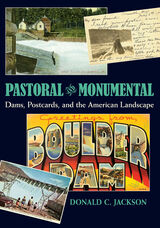 Pastoral and Monumental: Dams, Postcards, and the American Landscape
Donald C. Jackson
University of Pittsburgh Press, 2013
In Pastoral and Monumental, Donald C. Jackson chronicles America’s longtime fascination with dams as represented on picture postcards from the late nineteenth to the mid-twentieth century. Through over four hundred images, Jackson documents the remarkable transformation of dams and their significance to the environment and culture of America.
Initially, dams were portrayed in pastoral settings on postcards that might jokingly proclaim them as “a dam pretty place.” But scenes of flood damage, dam collapses, and other disasters also captured people’s attention. Later, images of New Deal projects, such as the Hoover Dam, Grand Coulee Dam, and Norris Dam, symbolized America’s rise from the Great Depression through monumental public works and technological innovation. Jackson relates the practical applications of dams, describing their use in irrigation, navigation, flood control, hydroelectric power, milling, mining, and manufacturing. He chronicles changing construction techniques, from small timber mill dams to those more massive and more critical to a society dependent on instant access to electricity and potable water.
Concurrent to the evolution of dam technology, Jackson recounts the rise of a postcard culture that was fueled by advances in printing, photography, lowered postal rates, and America’s fascination with visual imagery. In 1910, almost one billion postcards were mailed through the U.S. Postal Service, and for a period of over fifty years, postcards featuring dams were “all the rage.” Whether displaying the charms of an old mill, the aftermath of a devastating flood, or the construction of a colossal gravity dam, these postcards were a testament to how people perceived dams as structures of both beauty and technological power.
 Pastoral Quechua: The History of Christian Translation in Colonial Peru, 1550-1650
Alan Durston
University of Notre Dame Press, 2007
Pastoral Quechua explores the story of how the Spanish priests and missionaries of the Catholic church in post-conquest Peru systematically attempted to “incarnate” Christianity in Quechua, a large family of languages and dialects spoken by the dense Andes populations once united under the Inca empire. By codifying (and imposing) a single written standard, based on a variety of Quechua spoken in the former Inca capital of Cuzco, and through their translations of devotional, catechetical, and liturgical texts for everyday use in parishes, the missionary translators were on the front lines of Spanish colonialism in the Andes.
The Christian pastoral texts in Quechua are important witnesses to colonial interactions and power relations. Durston examines the broad historical contexts of Christian writing in Quechua; the role that Andean religious images and motifs were given by the Spanish translators in creating a syncretic Christian-Andean iconography of God, Christ, and Mary; the colonial linguistic ideologies and policies in play; and the mechanisms of control of the subjugated population that can be found in the performance practices of Christian liturgy, the organization of the texts, and even in certain aspects of grammar.
"Pastoral Quechua is an entryway into the world of colonial Quechua culture through language, showing how Spanish missionaries did not merely translate Christianity into the Inka language, but built up new and complex syntheses of inka and Spanish worlds. A foundational work, it opens up new and untouched ways of understanding the impact of European colonialism in the Americas, making a singular contribution to colonial history, to historical linguistics, and to the anthropology of colonialism.” —Bruce Mannheim, University of Michigan, author of The Language of the Inka since the European Invasion
“Pastoral Quechua is a wonderful volume that will be of interest to a broad range of scholars including historians, linguists, anthropologists, as well as scholars in all fields interested in Peru. The study focuses on the practice of translation, as the author states, but it is much more than that. It is a meticulously researched work that provides careful linguistic analysis conceptualized within an historical study of Catholic evangelization in colonial Peru.” —Thomas B. F. Cummins, Dumbarton Oaks Professor of Pre-Columbian and Colonial Art, Harvard University
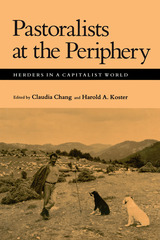 Pastoralists at the Periphery: Herders in a Capitalist World
Claudia Chang
University of Arizona Press, 1994 A Baluch tribesman follows his goats as they search for a bit of vegetation; a Turkana youth guards his father's cattle against theft by raiders.... These pastoral inhabitants of mountain and desert waste are considered to be among the most geographically, economically, and politically peripheral of peoples, yet they are not entirely isolated from broader sociopolitical and economic forces. The lives of modern pastoralists are greatly affected by the policies of nations and the demands of world markets. They may face military control, forced settlement, stock reduction programs, or even efforts at "development" by governments claiming sovereignty over the lands they roam.
The authors of this collection of essays examine the impact of capitalism on nineteenth- and early twentieth century pastoralists and discuss the historical transformations that have occurred in the lives and societies of herding peoples around the world. They argue that pastoralists were not simply passive recipients of change imposed by capitalist polities and that historical and economic factors impinging on their societies were as important as ecological ones. Collectively, these papers demonstrate that twentieth-century pastoralists and their nineteenth-century predecessors should not be seen as immutably locked in a pastoral "mode of production" but rather as actively negotiating encounters between themselves and the expanding power of capitalist states.
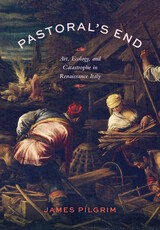 Pastoral’s End: Art, Ecology, and Catastrophe in Renaissance Italy
James Pilgrim
University of Chicago Press, 2026 How early modern Italian painting addressed the ways humans shape and are shaped by their environments.
In the sixteenth century, Italian artist Jacopo Bassano painted pictures of herdsmen and animals moving through dark and muddy landscapes. But he also participated in the agricultural development of the region in which he lived, producing topographical maps of local mountains and forests, inventing new methods of drainage and irrigation, and studying the latest techniques of crop rotation and fertilization. The relationship between Bassano’s rustic art and his participation in environmental transformation has, however, never been explored.
One of the first studies of Italian Renaissance art to grapple with the connections between visual culture and the environment, Pastoral’s End explores this crucial, formative relationship. James Pilgrim looks at Bassano’s career holistically, demonstrating how his involvement in a world marked by agricultural expansion, industrialization, resource extraction, environmental degradation, social transformation, and radical philosophical development informed his paintings of country life. Introducing new archival and visual evidence of Bassano’s knowledge of hydrology, agronomy, husbandry, and architecture, Pastoral’s End argues that he transformed the more placid rustic imagery of previous Renaissance artists into visions of dangerous ecological instability.
The Pastourelle: A Study of the Origins and Traditions of a Lyric Type
William Powell Jones
Harvard University Press Students of mediaeval literature will be especially interested in Professor Jones’s history of the pastourelle, and folk-lorists will also find much new material in their particular field. The author has evaluated the literary influences of the time—the pseudo-Virgilian pastoral and the Ovidian eroticism—on the pastourelle, but goes on to show that the chief inspiration was from popular sources. A chapter on the history of the genre after the Middle Ages throws some interesting light on French songs of the sixteenth and seventeenth centuries.
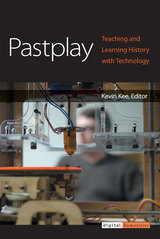 Pastplay: Teaching and Learning History with Technology
Kevin Kee, editor
University of Michigan Press, 2014 In the field of history, the Web and other technologies have become important tools in research and teaching of the past. Yet the use of these tools is limited—many historians and history educators have resisted adopting them because they fail to see how digital tools supplement and even improve upon conventional tools (such as books). In Pastplay, a collection of essays by leading history and humanities researchers and teachers, editor Kevin Kee works to address these concerns head-on. How should we use technology? Playfully, Kee contends. Why? Because doing so helps us think about the past in new ways; through the act of creating technologies, our understanding of the past is re-imagined and developed. From the insights of numerous scholars and teachers, Pastplay argues that we should play with technology in history because doing so enables us to see the past in new ways by helping us understand how history is created; honoring the roots of research, teaching, and technology development; requiring us to model our thoughts; and then allowing us to build our own understanding.
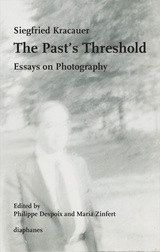 The Past's Threshold: Essays on Photography
Siegfried Kracauer
Diaphanes, 2014 Siegfried Kracauer was a leading intellectual figure of the Weimar Republic and one of the foremost representatives of critical theory. Best known for a wealth of writings on sociology and film theory, his influence is felt in the work of many of the period’s preeminent thinkers, including his friends, the critic Walter Benjamin, and Theodor W. Adorno, who once claimed he owed more to Kracauer than any other contemporary.
This volume brings together for the first time all of Kracauer’s essays on photography that he wrote between 1927 and 1933 as a journalist for the Frankfurter Zeitung, as well as an essay that appeared in the Magazine of Art after his exile in America, where he would spend the last twenty-five years of his life. The texts show Kracauer as a pioneering thinker of the photographic medium in addition to the important historian, and theorist, of film that he is acknowledged to have been. His writings here build a cohesive theory on the affinities between photography, memory and history.
With a foreword by Philippe Despoix offering insights into Kracauer’s theories and the historical context, and a Curriculum vitae in pictures, photographs from the Kracauer estate annotated by Maria Zinfert.
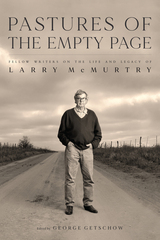 Pastures of the Empty Page: Fellow Writers on the Life and Legacy of Larry McMurtry
George Getschow, editor
University of Texas Press, 2023 A collection of essays that offers an intimate view of Larry McMurtry, America’s preeminent western novelist, through the eyes of a pantheon of writers he helped shape through his work over the course of his unparalleled literary life.
When he died in 2021, Larry McMurtry was one of America’s most revered writers. The author of treasured novels such as Lonesome Dove and The Last Picture Show, and coauthor of the screenplays for Brokeback Mountain and Streets of Laredo, McMurtry created unforgettable characters and landscapes largely drawn from his life growing up on the family’s hardscrabble ranch outside his hometown of Archer City, Texas. Pastures of the Empty Page brings together fellow writers to honor the man and his impact on American letters. Paulette Jiles, Stephen Harrigan, Stephanie Elizondo Griest, and Lawrence Wright take up McMurtry’s piercing and poetic vision—an elegiac literature of place that demolished old myths of cowboy culture and created new ones. Screenwriting partner Diana Ossana reflects on their thirty-year book and screenwriting partnership; other contributors explore McMurtry’s reading habits and his passion for bookselling. And brother Charlie McMurtry shares memories of their childhood on the ranch. In contrast to his curmudgeonly persona, Larry McMurtry emerges as a trustworthy friend and supportive mentor. McMurtry was famously self-deprecating, but as his admirers attest, this self-described “minor regional writer” was an artist for the ages.
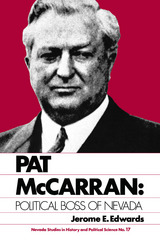 Pat Mccarran: Political Boss Of Nevada
Jerome E. Edwards
University of Nevada Press, 1982 Although Patrick A. McCarran represented one of the least populated states in the country, he gained a national reputation as a U.S. Senator from Nevada. He entered the political spotlight by locking horns with the Roosevelt and Truman administrations on foreign policy, internal security, and many domestic issues. His strategic use of committee assignments, coupled with a strong backing of loyal, home-state supporters, enabled him to achieve a powerful position in the government. Within his native state of Nevada, McCarran constructed a machine designed to dominate the state’s political and economic life. This domination, which extended to both political parties, was built on personal favors for constituents, shrewd use of patronage, rewards for friends, and inevitable punishment for those suspected of being enemies. Ironically, the Senator employed the same tactics that others had once used against him to stymie his own early political efforts. This work discusses the Senator’s background, his rise to power, and his methods of establishing political domination. Personal correspondence, excerpts from speeches, newspaper editorials, and interviews all help bring to life a colorful account of a controversial, driven man who held the levers of political control in Nevada during the early twentieth century.
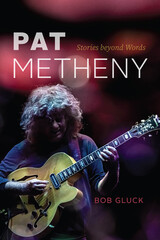 Pat Metheny: Stories beyond Words
Bob Gluck
University of Chicago Press, 2024 An in-depth exploration of the style and influence of Pat Metheny, a truly distinctive musical voice of our time.
Guitarist and composer Pat Metheny, among the most acclaimed, visionary musicians of our time, has for five decades toured with his many creative musical projects, most prominently the Pat Metheny Group, while collaborating with celebrated artists, including Charlie Haden, Ron Carter, Herbie Hancock, Ornette Coleman, and Steve Reich.
Bob Gluck, whose perspective as pianist, composer, and educator has illuminated the music of Herbie Hancock and Miles Davis in his two previous books, now focuses his lens on the music of Metheny. Neither a biography nor chronological record of Metheny’s musical output, Pat Metheny: Stories beyond Words instead captures Metheny’s self-conception as a musician and the threads that unite and distinguish his creative process. Drawing upon a wealth of new interviews and close readings of musical examples, Gluck offers a bird’s-eye view of Metheny’s musical ideas. Among these are the metaphor of storytelling, the complementarity of simplicity and complexity, and the integrated roles of composer, performer, and band leader. Much like Metheny’s signature style, this book is accessible to a wide range of readers, presenting new clarity, musical insight, and historical perspective about the legacy of Metheny’s groundbreaking music.
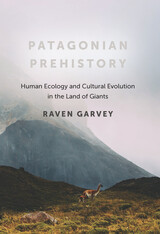 Patagonian Prehistory: Human Ecology and Cultural Evolution in the Land of Giants
Raven Garvey
University of Utah Press, 2021 Generally portrayed as a windswept wasteland of marginal use for human habitation, Patagonia is an unmatched testing ground for some of the world’s most important questions about human ecology and cultural change. In this volume, archaeologist Raven Garvey presents a critical synthesis of Patagonian prehistory, bringing an evolutionary perspective and unconventional evidence to bear on enduringly contentious issues in New World archaeology, including initial human colonization of the Americas, widespread depopulation between 8,000 and 4,000 years ago, and the transition from foraging to farming.
Garvey’s novel hypotheses question common assumptions regarding Patagonia’s suitability for prehistoric hunter-gatherers. She makes four primary arguments: (1) the surprising lack of clothing in parts of prehistoric Patagonia supports a relatively slow initial colonization of the Americas; (2) the sparse record of human habitation during the middle Holocene may be due to prehistoric behavioral changes and archaeological sampling methods rather than population decline; (3) farming never took root in Patagonia because risks associated with farming likely outweighed potential benefits; and, finally, (4) the broad trajectory of cultural change in Patagonia owes as much to feedback between population size and technology as to conditions in the rugged Patagonian outback itself.
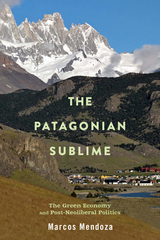 The Patagonian Sublime: The Green Economy and Post-Neoliberal Politics
Mendoza, Marcos
Rutgers University Press, 2019 The Patagonian Sublime provides a vivid, accessible, and cutting-edge investigation of the green economy and New Left politics in Argentina. Based on extensive field research in Glaciers National Park and the mountain village of El Chaltén, Marcos Mendoza deftly examines the diverse social worlds of alpine mountaineers, adventure trekkers, tourism entrepreneurs, seasonal laborers, park rangers, land managers, scientists, and others involved in the green economy.
Mendoza explores the fraught intersection of the green economy with the New Left politics of the Néstor Kirchner and Cristina Fernández de Kirchner governments. Mendoza documents the strategies of capitalist development, national representation, and political rule embedded in the “green productivist” agenda pursued by Kirchner and Fernández. Mendoza shows how Andean Patagonian communities have responded to the challenges of community-based conservation, the fashioning of wilderness zones, and the drive to create place-based monopolies that allow ecotourism destinations to compete in the global consumer economy.
'Pataphysics: The Poetics of an Imaginary Science
Christian Bok
Northwestern University Press, 2002 'Pataphysics, the pseudoscience imagined by Alfred Jarry, has so far, because of its academic frivolity and hermetic perversity, attracted very little scholarly or critical inquiry, and yet it has inspired a century of experimentation. Tracing the place of 'pataphysics in the relationship between science and poetry, Christian Bök shows it is fundamental to the nature of the postmodern, and considers the work of Alfred Jarry and its influence on others.
A long overdue critical look at a significant strain of the twentieth-century avant-garde, 'Pataphysics: The Poetics of Imaginary Science raises important historical, cultural, and theoretical issues germane to the production and reception of poetry, the ways we think about, write, and read it, and the sorts of claims it makes upon our understanding.
Patarata Pottery: Classic Period Ceramics of the South-Central Gulf Coast, Veracruz, Mexico
Barbara L. Stark
University of Arizona Press, 1989 The Anthropological Papers of the University of Arizona is a peer-reviewed monograph series sponsored by the School of Anthropology. Established in 1959, the series publishes archaeological and ethnographic papers that use contemporary method and theory to investigate problems of anthropological importance in the southwestern United States, Mexico, and related areas.
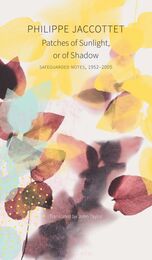 Patches of Sunlight, Or of Shadow: Safeguarded Notes, 1952–2005
Philippe Jaccottet
Seagull Books, 2020 Philippe Jaccottet’s newest work follows in some ways the approach of Seedtime, his recent two-volume collection of notebooks. Similarly comprising on-the-spot jottings, philosophical reflections, literary commentary, dream narratives and sundry “notes,” this book nonetheless differs from the preceding volumes in that the Swiss poet includes more personal material than ever before. Drawing on unpublished notebooks from the years 1952–2005, Jacottet offers here passages about his family, the death of his father-in-law and of his mother, his encounters with other major poets—such as René Char, Francis Ponge, Jean Tardieu, and his friends Yves Bonnefoy and André du Bouchet—and his trips abroad, as well as, characteristically, his walks in the countryside around the village of Grignan, in the south of France, where he has lived since 1953. For a poet who has been notoriously discreet about his life, this book offers unexpected glimpses of the private man. Above all, the entries in this notebook show how one of the greatest European poets grapples with the discouraging elements of existence, counterbalancing them by recording fleeting perceptions in which “something else,” almost like a threshold, seems present.
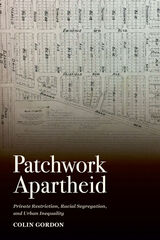 Patchwork Apartheid: Private Restriction, Racial Segregation, and Urban Inequality
Colin Gordon
Russell Sage Foundation, 2023 For the first half of the twentieth century, private agreements to impose racial restrictions on who could occupy property decisively shaped the development of American cities and the distribution of people within them. Racial restrictions on the right to buy, sell, or occupy property also effectively truncated the political, social, and economic citizenship of those targeted for exclusion. In Patchwork Apartheid, historian Colin Gordon examines the history of such restrictions and how their consequences reverberate today. Drawing on a unique record of property restrictions excavated from local property records in five Midwestern counties, Gordon documents the prevalence of private property restriction in the era before zoning and building codes were widely employed and before federal redlining sanctioned the segregation of American cities and suburbs. This record of private restriction—documented and mapped to the parcel level in Greater Minneapolis, Greater St. Louis, and two Iowa counties—reveals the racial segregation process both on the ground, in the strategic deployment of restrictions throughout transitional central city neighborhoods and suburbs, and in the broader social and legal construction of racial categories and racial boundaries.
Gordon also explores the role of other policies and practices in sustaining segregation. Enforcement of private racial restrictions was held unconstitutional in 1948, and such agreements were prohibited outright in 1968. But their premises and assumptions, and the segregation they had accomplished, were accommodated by local zoning and federal housing policies. Explicit racial restrictions were replaced by the deceptive business practices of real estate agents and developers, who characterized certain neighborhoods as white and desirable and others as black and undesirable, thereby hiding segregation behind the promotion of sound property investments, safe neighborhoods, and good schools. These practices were in turn replaced by local zoning, which systematically protected white neighborhoods while targeting “blighted” black neighborhoods for commercial and industrial redevelopment, and by a tangle of federal policies that reliably deferred to local and private interests with deep investments in local segregation. Private race restriction was thus a key element in the original segregation of American cities and a source of durable inequalities in housing wealth, housing opportunity, and economic mobility.
Patchwork Apartheid exhaustively documents the history of private restriction in urban settings and demonstrates its crucial role in the ideas and assumptions that have sustained racial segregation in the United States into the twenty-first century.
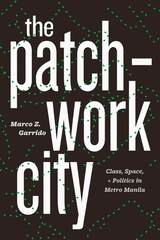 The Patchwork City: Class, Space, and Politics in Metro Manila
Marco Z. Garrido
University of Chicago Press, 2019 In contemporary Manila, slums and squatter settlements are peppered throughout the city, often pushing right up against the walled enclaves of the privileged, creating the complex geopolitical pattern of Marco Z. Garrido’s “patchwork city.” Garrido documents the fragmentation of Manila into a mélange of spaces defined by class, particularly slums and upper- and middle-class enclaves. He then looks beyond urban fragmentation to delineate its effects on class relations and politics, arguing that the proliferation of these slums and enclaves and their subsequent proximity have intensified class relations. For enclave residents, the proximity of slums is a source of insecurity, compelling them to impose spatial boundaries on slum residents. For slum residents, the regular imposition of these boundaries creates a pervasive sense of discrimination. Class boundaries then sharpen along the housing divide, and the urban poor and middle class emerge not as labor and capital but as squatters and “villagers,” Manila’s name for subdivision residents. Garrido further examines the politicization of this divide with the case of the populist president Joseph Estrada, finding the two sides drawn into contention over not just the right to the city, but the nature of democracy itself.
The Patchwork City illuminates how segregation, class relations, and democracy are all intensely connected. It makes clear, ultimately, that class as a social structure is as indispensable to the study of Manila—and of many other cities of the Global South—as race is to the study of American cities.
 Patchwork: Iowa Quilts and Quilters
Jacqueline Andre Schmeal
University of Iowa Press, 2003 Frugal, thrifty, enduring, colorful, comforting, warm. These words capture both the spirit of Iowa quilters through the centuries and the fabrics they stitched together. In Patchwork, Jacqueline Schmeal celebrates the lives of Iowa quilters and the enduring beauty of historic Iowa quilts. Drawing on written records by and interviews with contemporary quilters, many of whom were born in the early years of the twentieth century, Schmeal presents the life histories of these hard-working yet inspired artists. Sisters Elsie Ball and Mary Ball Jay of Fairfield—charging one and a quarter cents per yard of thread—kept meticulous records of each of the 135 quilts they stitched between 1935 and 1970. Ivan Johnson plowed his fields by day and quilted vivid designs by night. Cloth scraps were so precious to Barbara Chupp, an Amish quilter, that she became known for her mosaic piecing. Members of the Sunshine Circle, organized in 1912 in a Quaker church in Earlham, still quilt together today. Mennonite quilter Sara Miller became famous nationwide for her fabric store, Kalona Kountry Kreations. Their stories—of impoverished childhoods, hardscrabble work, and strong families—are enhanced by over seventy color photographs of an unbelievably rich collection of historic quilts ranging from the early 1800s to the 1950s. Offering both a glimpse into the daily lives of twentieth-century quiltmakers and an amazing treasury of Iowa's historic quilts, Patchwork is a loving tribute to the creative spirit that links modern-day quilters to the patterns and traditions of their predecessors.
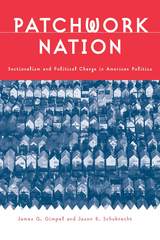 Patchwork Nation: Sectionalism and Political Change in American Politics
James G. Gimpel and Jason E. Schuknecht
University of Michigan Press, 2004 Though local and regional politics are often ignored in political-behavior literature, analyses of these areas are fundamental to understanding the scope of political change in the regimes experiencing realignment and for which there are no survey data. With the unprecedented population movement and socioeconomic mobility of the twentieth century, political support has been reshuffled in many parts of the country. Yet at the dawn of the new century, these local and regional movements are rather poorly understood. Patchwork Nation examines the forces that account for pervasive political regionalism and the geographic shifts that continue to alter the nation's political landscape.
The authors focus on twelve states in particular, identifying regional differences in support for candidates or political parties and find that the electoral foundations for political regionalism differ from state to state. Thus, regionalism within states is not easily reducible to one or two population characteristics that are common to all states. The authors demonstrate the importance of a political geographic approach to American political behavior and challenge the tendency in the scholarly literature to ignore the impact and significance of local contexts.
James G. Gimpel is Professor of Government and Politics, University of Maryland, College Park.
Jason E. Schuknecht is a Research Analyst at Westat, Inc. in Rockville, Maryland.
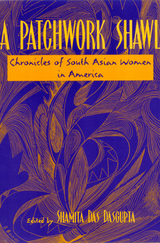 A Patchwork Shawl: Chronicles of South Asian Women in America
Das Dasgupta, Shamita
Rutgers University Press, 1998 A Patchwork Shawl sheds light on the lives of a segment of the U.S. immigrant population that has long been relegated to the margins. It focuses on women's lives that span different worlds: Bangladesh, India, Pakistan, and the United States. This collection of essays by and about South Asian women in America challenges stereotypes by allowing women to speak in their own words. Together they provide discerning insights into the reconstruction of immigrant patriarchy in a new world, and the development of women's resistance to that reconstruction. Shamita Das DasGupta's introduction also acquaints readers with the psychological topography of the South Asian community. A Patchwork Shawl considers topics from re-negotiation of identity to sexuality, violence to intimacy, occupations to organizing within the community. The essays bear witness to women's negotiations for independent identities, their claim to their own bodies, and the right to choose relationships based on their own histories and truths. They bring new understanding to the intersection of gender, ethnicity, race, sexuality, and class.
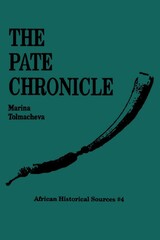 The Pate Chronicle
Marina Tolmacheva
Michigan State University Press, 1993 In late October 1890, a British force led by Admiral Fremantle assaulted and subdued the East African town of Witu, the mainland capital of the Nabahani rulers of Pate; five years later, the entire region and the adjacent coastal islands came under British administration. One of the great tragedies suffered as a result of Admiral Fremantle's initial attack was the loss of the original manuscript of the history of Pate, The Book of the Kings of Pate.
This historical work in its various forms is representative of a living historical tradition developed in the coastal city-states of East Africa and is considered one of the important literary treasures of their culture and society. It also stands as the most important indigenous source for Swahili history, the history of the Swahili language, its dialects, and its written tradition. The four Arabic-Swahili versions (manuscripts 177, 321, 344, and 358 of the Library of the University of Dar es Salaam) presented here in The Pate Chronicle add significantly to the growing pool of information available about Pate and East Africa before the era of European colonialism.
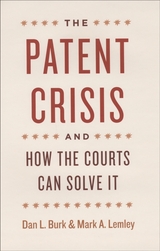 The Patent Crisis and How the Courts Can Solve It
Dan L. Burk and Mark A. Lemley
University of Chicago Press, 2009 Patent law is crucial to encourage technological innovation. But as the patent system currently stands, diverse industries from pharmaceuticals to software to semiconductors are all governed by the same rules even though they innovate very differently. The result is a crisis in the patent system, where patents calibrated to the needs of prescription drugs wreak havoc on information technologies and vice versa. According to Dan L. Burk and Mark A. Lemley in The Patent Crisis and How the Courts Can Solve It, courts should use the tools the patent system already gives them to treat patents in different industries differently. Industry tailoring is the only way to provide an appropriate level of incentive for each industry. Burk and Lemley illustrate the barriers to innovation created by the catch-all standards in the current system. Legal tools already present in the patent statute, they contend, offer a solution—courts can tailor patent law, through interpretations and applications, to suit the needs of various types of businesses. The Patent Crisis and How the Courts Can Solve It will be essential reading for those seeking to understand the nexus of economics, business, and law in the twenty-first century.
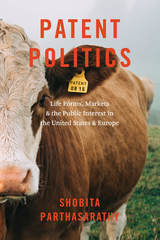 Patent Politics: Life Forms, Markets, and the Public Interest in the United States and Europe
Shobita Parthasarathy
University of Chicago Press, 2017 Over the past thirty years, the world’s patent systems have experienced pressure from civil society like never before. From farmers to patient advocates, new voices are arguing that patents impact public health, economic inequality, morality—and democracy. These challenges, to domains that we usually consider technical and legal, may seem surprising. But in Patent Politics, Shobita Parthasarathy argues that patent systems have always been deeply political and social.
To demonstrate this, Parthasarathy takes readers through a particularly fierce and prolonged set of controversies over patents on life forms linked to important advances in biology and agriculture and potentially life-saving medicines. Comparing battles over patents on animals, human embryonic stem cells, human genes, and plants in the United States and Europe, she shows how political culture, ideology, and history shape patent system politics. Clashes over whose voices and which values matter in the patent system, as well as what counts as knowledge and whose expertise is important, look quite different in these two places. And through these debates, the United States and Europe are developing very different approaches to patent and innovation governance. Not just the first comprehensive look at the controversies swirling around biotechnology patents, Patent Politics is also the first in-depth analysis of the political underpinnings and implications of modern patent systems, and provides a timely analysis of how we can reform these systems around the world to maximize the public interest.
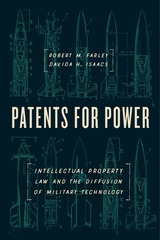 Patents for Power: Intellectual Property Law and the Diffusion of Military Technology
Robert M. Farley and Davida H. Isaacs
University of Chicago Press, 2020 In an era when knowledge can travel with astonishing speed, the need for analysis of intellectual property (IP) law—and its focus on patents, trade secrets, trademarks, and issues of copyright—has never been greater. But as Robert M. Farley and Davida H. Isaacs stress in Patents for Power, we have long overlooked critical ties between IP law and one area of worldwide concern: military technology. This deft blend of case studies, theoretical analyses, and policy advice reveals the fundamental role of IP law in shaping how states create and transmit defense equipment and weaponry.
The book probes two major issues: the effect of IP law on innovation itself and the effect of IP law on the international diffusion, or sharing, of technology. Discussing a range of inventions, from the AK-47 rifle to the B-29 Superfortress bomber to the MQ-1 Predator drone, the authors show how IP systems (or their lack) have impacted domestic and international relations across a number of countries, including the United States, Russia, China, and South Korea. The study finds, among other results, that while the open nature of the IP system may encourage industrial espionage like cyberwarfare, increased state uptake of IP law is helping to establish international standards for IP protection. This clear-eyed approach to law and national security is thus essential for anyone interested in history, political science, and legal studies.
 Patents, Trademarks, and Related Rights: National and International Protection
Stephen P. Ladas
Harvard University Press, 1975 Lawyers and corporations have a vital interest in the regulation and protection of industrial property—patents, designs, trademarks, trade names, and repression of unfair competition—and in the problems raised by agreements between enterprises, nationally and internationally. Since World War II, there has been increasing ferment for changes in the whole system of industrial property. Pressures have been building up from administrations concerned with the functioning of the patent and trademark system; from private enterprises affected by delays, costs, and insecurities of the system; from developing countries anxious to receive and adapt foreign technology at reasonable cost and without excessive restriction; and from the increasing tendency of antitrust law to curb even legal monopolies in order to ensure free competition.
This major work describes the national and international regime of patents, trademarks, technological know-how, and related rights of industrial property; the conflicting interests and demands for recognition and satisfaction in this field; the international efforts and arrangements achieved for harmonization of law and procedure; the problems involved in the transfer of technology for the technical and economic development of countries pressing for assistance; and the controls established by statutory and decisional law against restriction of competition by the exercise of industrial property rights.
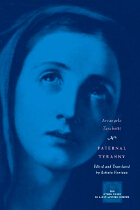 Paternal Tyranny
Arcangela Tarabotti
University of Chicago Press, 2004 Sharp-witted and sharp-tongued, Arcangela Tarabotti (1604-52) yearned to be formally educated and enjoy an independent life in Venetian literary circles. But instead, at sixteen, her father forced her into a Benedictine convent. To protest her confinement, Tarabotti composed polemical works exposing the many injustices perpetrated against women of her day.
Paternal Tyranny, the first of these works, is a fiery but carefully argued manifesto against the oppression of women by the Venetian patriarchy. Denouncing key misogynist texts of the era, Tarabotti shows how despicable it was for Venice, a republic that prided itself on its political liberties, to deprive its women of rights accorded even to foreigners. She accuses parents of treating convents as dumping grounds for disabled, illegitimate, or otherwise unwanted daughters. Finally, through compelling feminist readings of the Bible and other religious works, Tarabotti demonstrates that women are clearly men's equals in God's eyes.
An avenging angel who dared to speak out for the rights of women nearly four centuries ago, Arcangela Tarabotti can now finally be heard.
Paternalism
Rolf Sartorius, Editor
University of Minnesota Press, 1984 Paternalism was first published in 1984. Minnesota Archive Editions uses digital technology to make long-unavailable books once again accessible, and are published unaltered from the original University of Minnesota Press editions. Over a hundred years of controversy have established that the antipaternalistic principle so passionately argued by Mill in On Liberty is anything but simple. There are difficulties in interpreting the principle, in reconciling it with Mill's general utilitarian position, and defending it under any particular interpretation. The fourteen essays collected in Paternalism represent the shape philosophical discussions have taken in the past decade and include the classical contemporary statements as well as important new work. This book will provide philosophers, policymakers, doctors, lawyers, and students with all the major arguments that are part of the current controversy.
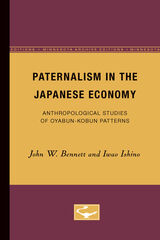 Paternalism in the Japanese Economy: Anthropological Studies of Oyabun-Kobun Patterns
John Bennett
University of Minnesota Press, 1963
Paternalism in the Japanese Economy was first published in 1963.This is a study of the Japanese social institution known as the oyabun-kobun system, which has been important in the development of the Japanese agricultural and industrial economy. The term oyabun-kobun implies a system of relationships among employers and employees which is modeled on the typical feudal, paternalistic Japanese family relationships. Under this system, for example, a labor manager and the laborers he controls are governed by a highly developed pattern of duties, privileges, and ceremonial activities not unlike those which prevail among members of a primary family or kin group.The study is based on research which was carried out in Japan by the Public Opinion and Sociological Research division of SCAP, the American occupation authority, following World War II. Mr. Bennett served as chief of this division during part of its tenure, and Mr. Ishino was a social science researcher in the division.In addition to the intrinsic value of the study, it is of interest also because of the unusual circumstances under which the data were collected, during the military occupation of the country. The authors describe the conditions as a prelude to their presentation of the study itself.
 Paternalistic Capitalism
Andreas G. Papandreou
University of Minnesota Press, 1972
Paternalistic Capitalism was first published in 1972. Minnesota Archive Editions uses digital technology to make long-unavailable books once again accessible, and are published unaltered from the original University of Minnesota Press editions.
The distinguished economist and Greek political leader presents here a powerful critique of American capitalism and its relationship to government and foreign policy. Dr. Papandreou first examines the orthodox view of the contemporary capitalist economy and the "myth of market capitalism" which it has engendered. He then considers the Neo-Marxist view that the economy can best be understood as monopoly capitalism, and the technocratic interpretation of society proposed by J. K. Galbraith. Dr. Papandreou accepts and rejects various aspects of these two interpretations, and moves to define the salient features of what he calls paternalistic capitalism, wherein privatized decentralized planning increasingly is carried out by the corporate managerial elite, in the interest not of the consumer, but of the "system." The paternalism is that of the autocratic big brother.
The author then explores the relationship between the managerial elite and the instrumentalities of the State, and claims that next to the managerial elite stand the national security managers—not by accident, for paternalistic capitalism is aggressively expansionist, as is reflected in the foreign policy of the capitalist metropolis, the United States. The global aspect of paternalistic capitalism is further delineated in Dr. Papandreou's discussion of the "new mercantilism" and of the institutional device of the multinational corporation. Finally, he considers briefly two alternatives—the Soviet experiment, which he rejects as paternalistic socialism, and a vision of a regionally decentralized society, in which man will control rather than be at the mercy of his social environment.
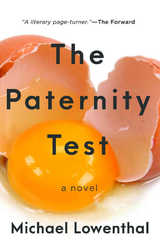 The Paternity Test: A Novel
Michael Lowenthal
University of Wisconsin Press, 2018 Having a baby to save a marriage—it’s the oldest of clichés. But what if the marriage at risk is a gay one, and having a baby involves a surrogate mother?
Pat Faunce is a faltering romantic, a former poetry major who now writes textbooks. A decade into his relationship with Stu, an airline pilot from a fraught Jewish family, he fears he’s losing Stu to other men—and losing himself in their “no rules” arrangement. Yearning for a baby and a deeper commitment, he pressures Stu to move from Manhattan to Cape Cod, to the cottage where Pat spent boyhood summers.
As they struggle to adjust to their new life, they enlist a surrogate: Debora, a charismatic Brazilian immigrant, married to Danny, an American carpenter. Gradually, Pat and Debora bond, drawn together by the logistics of getting pregnant and away from their spouses. Pat gets caught between loyalties—to Stu and his family, to Debora, to his own potent desires—and wonders: is he fit to be a father?
In one of the first novels to explore the experience of gay men seeking a child through surrogacy, Michael Lowenthal writes passionately about marriages and mistakes, loyalty and betrayal, and about how our drive to create families can complicate the ones we already have. The Paternity Test is a provocative look at the new “family values.”
 Paternity: The Elusive Quest for the Father
Nara B. Milanich
Harvard University Press, 2019 “In this rigorous and beautifully researched volume, Milanich considers the tension between social and biological definitions of fatherhood, and shows how much we still have to learn about what constitutes a father.”
—Andrew Solomon, author of Far from the Tree: Parents, Children, and the Search for Identity
For most of human history, the notion that paternity was uncertain appeared to be an immutable law of nature. The unknown father provided entertaining plotlines from Shakespeare to the Victorian novelists and lay at the heart of inheritance and child support disputes. But in the 1920s new scientific advances promised to solve the mystery of paternity once and for all. The stakes were high: fatherhood has always been a public relationship as well as a private one. It confers not only patrimony and legitimacy but also a name, nationality, and identity.
The new science of paternity, with methods such as blood typing, fingerprinting, and facial analysis, would bring clarity to the conundrum of fatherhood—or so it appeared. Suddenly, it would be possible to establish family relationships, expose adulterous affairs, locate errant fathers, unravel baby mix-ups, and discover one’s true race and ethnicity. Tracing the scientific quest for the father up to the present, with the advent of seemingly foolproof DNA analysis, Nara Milanich shows that the effort to establish biological truth has not ended the quest for the father. Rather, scientific certainty has revealed the fundamentally social, cultural, and political nature of paternity. As Paternity shows, in the age of modern genetics the answer to the question “Who’s your father?” remains as complicated as ever.
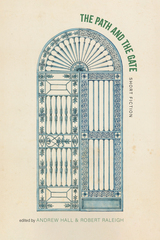 The Path and the Gate: Mormon Short Fiction
Andrew Hall
Signature Books, 2023 The Book of Mormon prophet Nephi describes the journey to eternal life as going through a gate of ordinances and traveling a “straight and narrow path.” Twenty-three authors took that gospel roadmap passage as a prompt to write “a Mormon story.” They responded with a surprisingly wide range of realistic and fantastic tales. Many are human reactions to unexpected steps on the path: a lifetime of faith in a patriarchal blessing’s unfulfilled promise, a survivor of violence calling a divided community to repentance, a baptism gone very wrong, and spiritual gifts that extend far beyond the apostle Paul’s list. The characters stretch from wayward bishops and helpful home teachers to cyber-Seventies searching for lost sheep in the metaverse, with settings from the slums of Mumbai to a heaven that turns out to be more difficult than expected. Some characters reject the path’s restrictions and expectations, while others can second the reported words of J. Golden Kimball, “I may not always walk the straight and narrow, but I sure in hell try to cross it as often as I can.”
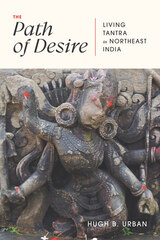 The Path of Desire: Living Tantra in Northeast India
Hugh B. Urban
University of Chicago Press, 2024 A provocative study of contemporary Tantra as a dynamic living tradition.
Tantra, one of the most important religious currents in South Asia, is often misrepresented as little more than ritualized sex. Through a mixture of ethnography and history, Hugh B. Urban reveals a dynamic living tradition behind the sensationalist stories. Urban shows that Tantric desire goes beyond the erotic, encompassing such quotidian experiences as childbearing and healing. He traces these holistic desires through a series of unique practices: institutional Tantra centered on gurus and esoteric rituals; public Tantra marked by performance and festival; folk Tantra focused on magic and personal well-being; and popular Tantra imagined in fiction, film, and digital media. The result is a provocative new description of Hindu Tantra that challenges us to approach religion as something always entwined with politics and culture, thoroughly entangled with ordinary needs and desires.
The Path of Mercy: The Life of Catherine McAuley
Mary C. Sullivan
Catholic University of America Press, 2012 Breaking new ground in presenting the life of Catherine McAuley (1778?-1841), the Dublin woman who founded the Sisters of Mercy, Mary C. Sullivan has written the first full-length, documented narrative of McAuley in more than fifty years.
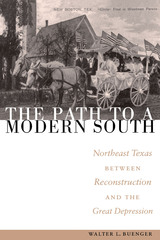 The Path to a Modern South: Northeast Texas between Reconstruction and the Great Depression
By Walter L. Buenger
University of Texas Press, 2001 The forces that turned Northeast Texas from a poverty-stricken region into a more economically prosperous area.
Winner, Texas State Historical Association Coral H. Tullis Memorial Award for best book on Texas history, 2001 Federal New Deal programs of the 1930s and World War II are often credited for transforming the South, including Texas, from a poverty-stricken region mired in Confederate mythology into a more modern and economically prosperous part of the United States. By contrast, this history of Northeast Texas, one of the most culturally southern areas of the state, offers persuasive evidence that political, economic, and social modernization began long before the 1930s and prepared Texans to take advantage of the opportunities presented by the New Deal and World War II. Walter L. Buenger draws on extensive primary research to tell the story of change in Northeast Texas from 1887 to 1930. Moving beyond previous, more narrowly focused studies of the South, he traces and interconnects the significant changes that occurred in politics, race relations, business and the economy, and women's roles. He also reveals how altered memories of the past and the emergence of a stronger identification with Texas history affected all facets of life in Northeast Texas.
 The Path to Christian Democracy: German Catholics and the Party System from Windthorst to Adenauer
Noel Cary
Harvard University Press, 1996 From the time of Bismarck’s great rival Ludwig Windthorst to that of the first post–World War II Chancellor, Konrad Adenauer, the Catholic community in Germany took a distinctive historical path. Although it was by no means free of authoritarian components, it was at times the most democratic pathway taken by organized political Catholicism anywhere in Europe.
Challenging those who seek continuity in German history primarily in terms of its long march toward Nazism, Noel Cary crosses all the usual historical turning points from mid-nineteenth- to late-twentieth-century German history in search of the indigenous origins of postwar German democracy. Complementing recent studies of German Social Democracy, it links the postwar party system to the partisan traditions this new system transcended by documenting the attempts by reform-minded members of the old Catholic Center party to break out of the constraints of minority-group politics and form a democratic political party. The failure of those efforts before 1933 helped clear the way for Nazism, but their success after 1945 in founding the interdenominational Christian Democratic Union (CDU) helped tame political conservatism and allowed the emergence of the most stable democracy in contemporary Europe. Integrating those who needed to be integrated—the cultural and political conservatives—into a durable liberal order, this conservative yet democratic and interdenominational “catch-all” party broadened democratic sensibilities and softened the effect of religious tensions on the German polity and party system.
By crossing traditional chronological divides and exploring the links between earlier abortive Catholic initiatives and the range of competing postwar visions of the new party system, this book moves Catholic Germany from the periphery to the heart of the issue of continuity in modern German history.
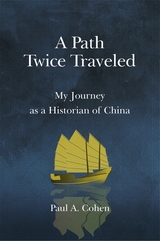 A Path Twice Traveled: My Journey as a Historian of China
Paul A. Cohen
Harvard University Press, 2019 The Harvard University Asia Center and the Fairbank Center for Chinese Studies collaborated on publishing this memoir by Paul A. Cohen, one of the West’s preeminent historians of China. Cohen traces the development of his work from its inception in the early 1960s to the present, offering fresh perspectives that consistently challenge us to think more deeply about China and the historical craft in general. A memoir, of course, is itself a form of history. But for a historian, writing a memoir on one’s career is quite different from the creation of that career in the first place. This is what Cohen alludes to in the title A Path Twice Traveled. The title highlights the important disparity between the past as originally experienced and the past as later reconstructed, by which point both the historian and the world have undergone extensive change. This distinction, which conveys nicely the double meaning of the word history, is very much on Cohen’s mind throughout the book. He returns to it explicitly in the memoir’s final chapter, appropriately titled “Then and Now: The Two Histories.”
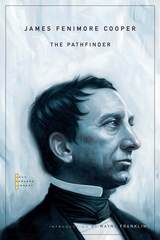 The Pathfinder
James Fenimore Cooper
Harvard University Press, 2014 In 1831, James Fenimore Cooper told his publisher that he wanted to write a story set on Lake Ontario. The book was accepted, but with no hint that it would feature Natty Bumppo from the well-established Leather-Stocking Tales. The Pathfinder (1840) revisits Natty’s military service, extending a story begun in The Last of the Mohicans, and introduces the complications of love against the backdrop of the French and Indian War. Wayne Franklin’s introduction describes the personal and financial circumstances that led to Cooper’s resurrection of his most popular character, underscoring the author’s aim to offer Natty as a “Pathfinder” for a nation he feared had lost its moral bearings.
The John Harvard Library edition reproduces the text of The Pathfinder from The Writings of James Fenimore Cooper (State University of New York Press).
Since 1959 The John Harvard Library has been instrumental in publishing essential American writings in authoritative editions.
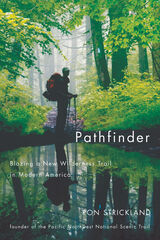 Pathfinder: Blazing a New Wilderness Trail in Modern America
Ron Strickland
Oregon State University Press, 2011 Ron Strickland has spent a good deal of time walking. He hiked the 1200 miles of the Pacific Northwest Trail in 1983. In 2004, he completed the Pacific Crest Trail, with a 1500-mile hike from the Mojave Desert to the Columbia River. In 2009, he hiked the length of the New England Trail. He has also held a longtime dream of showcasing the best hiking of the Rockies, Purcells, Okanogan, Cascades, Olympics, and Wilderness Coast. He spent years raising funds, recruiting volunteers, cutting brush, digging dirt, and lobbying landowners, officials, and politicians—and in 2009, the Pacific Northwest Trail, which runs from the Continental Divide to the Pacific Ocean, traversing three National Parks and seven National Forests, was finally declared a National Scenic Trail. In this adventurous and moving memoir, Strickland—known in the backcountry as “Pathfinder”—shares his insider view of the joys and adventures of long-distance hiking. He intersperses colorful portraits of memorable trail characters and lush descriptions of hikes he knows firsthand. He also describes the experience of conceiving and establishing the Pacific Northwest Trail, detailing the setbacks and triumphs along the way. Pathfinder offers the rich insights and experiences of a longtime hiker, inspiring readers to the wonder of hiking and the outdoors.
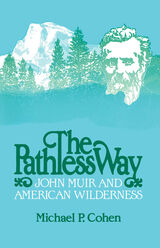 The Pathless Way
Michael Cohen
University of Wisconsin Press, 1986 "A tour de force, a remarkable narrative of spiritual and political development. . . . [Cohen's] oft unanswered, and unanswerable, questions, his views of Muir's spiritual, intellectual, and political growth are insightful, challenging, and new. They deserve an audience with scholars and Muir devotees."—Shirley Sargent, Pacific Historian
In this powerful study, Michael Cohen captures as never before the powerful consciousness, vision, and legacy of the pioneering environmentalist John Muir. Ultimately, Cohen stresses, this ecological consciousness would generate an ecological conscience.
It was no longer enough for Muir to individually test and celebrate his enlightenment in the wild. His vision, he now felt, must lead to concrete action, and the result was a protracted campaign that stressed the ecological education of the American public, governmental protection of natural resources, the establishment of the National Parks, and the encouragement of tourism.
Anyone interested in environmental studies, in American history and literature, or in the future of our natural heritage will be drawn by the very bracing flavor of his wilderness odyssey, evoked here by one of his own—a twentieth-century mountaineer and literary craftsman.
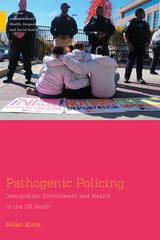 Pathogenic Policing: Immigration Enforcement and Health in the U.S. South
Nolan Kline
Rutgers University Press, 2019 The relationship between undocumented immigrants and law enforcement officials continues to be a politically contentious topic in the United States. Nolan Kline focuses on the hidden, health-related impacts of immigrant policing to examine the role of policy in shaping health inequality in the U.S., and responds to fundamental questions regarding biopolitics, especially how policy can reinforce ‘race’ as a vehicle of social division. He argues that immigration enforcement policy results in a shadow medical system, shapes immigrants’ health and interpersonal relationships, and has health-related impacts that extend beyond immigrants to affect health providers, immigrant rights groups, hospitals, and the overall health system. Pathogenic Policing follows current immigrant policing regimes in Georgia and contextualizes contemporary legislation and law enforcement practices against a backdrop of historical forms of political exclusion from health and social services for all undocumented immigrants in the U.S. For anyone concerned about the health of the most vulnerable among us, and those who interact with the overall health safety net, this will be an eye-opening read.
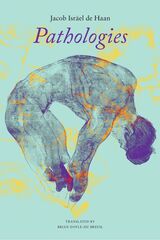 Pathologies: The Downfall of Johan van Vere de With
Jacob Isräel de Haan
Seagull Books, 2024 One of the first novels to openly explore gay love and eroticism, Pathologies is a lost classic that is now translated into English for the first time.
At the start of the twentieth century, Jewish anti-Zionist Jacob Israël de Haan led an eventful life as a poet, journalist, teacher, and lawyer in the Netherlands. His autobiographical novella Pipelines caused a storm of controversy in 1904 with its portrayal of a subject that was considered scandalous at the time—a romantic relationship between two young men. He lost his teaching job, and the entire print run was pulped.
In his iconic 1908 novel Pathologies, he once again openly and radically explored the topic of homosexuality. The story centers around adolescent Johan, who lives a secluded life with his father and their elderly housekeeper in a large house. For a while, Johan has been plagued by erotic fantasies about his classmates. When, to make matters worse, he finds himself feeling attracted to his father—first in a dream, and then in real life—he grows desperate. Johan moves out, finding room and board with an older married couple in Haarlem, where he meets René, a young confident artist. Johan falls head-over-heels in love, and the two men enter a sadomasochistic relationship that soon begins to spiral out of control.
Johan is one of world literature’s most tragic, troubled young heroes, at par with Goethe’s Werther and Dostoevsky’s Raskolnikov. His struggle to come to terms with his fantasies and desires—rife with taboos that continue to resonate today—forms the beating heart of this daring novel. Written in De Haan’s precise, lyrical prose, Pathologies has lost none of its force more than a century after it was first published.
 Pathos and Power: Interdisciplinary Perspectives on Widowhood in Africa, Past and Present
Benjamin N. Lawrance and Joanna Davidson
Ohio University Press, 2025 The collected essays in Pathos and Power provide a critical exploration of widowhood in Africa through a series of historical and contemporary case studies. The book challenges a simplistic understanding of widowhood by highlighting how the experience varies according to age, class, race, religion, and geographic location. The contributors investigate how the category of widowhood can obscure or reveal various social dynamics while demonstrating the diversity of material, symbolic, and embodied circumstances faced by African widows. The volume considers the forces shaping the lives of widows by examining the structural and legal challenges they encounter, including discriminatory practices in social, economic, and political spheres. Through discussions of precolonial, colonial, and postcolonial contexts, it explores the intersections of custom, law, patriarchy, and feminism while delving into the potentially liberatory opportunities that widowhood sometimes presents. The book also raises broader questions about gender, personhood, marriage, autonomy, and national identity, emphasizing how widowhood informs key conceptual debates in African studies. Editors Joanna Davidson and Benjamin N. Lawrance bring together scholars across such fields as anthropology, gender studies, history, law, and political science. The authors employ a range of methodologies, including archival research, ethnography, and storytelling, to illuminate widowhood in new and innovative ways. The volume’s rich empirical studies and theoretical insights offer a valuable resource for scholars seeking to understand widowhood and its broader implications in African societies. CONTRIBUTORS Rogaia Mustafa Abusharaf Fisayo Ajala Catherine E. Bolten Abbass Braham Mariana Candido Joanna Davidson Mariana Dias Paes Ramadan El-Khouli Casey Golomski Juelma Gomes de Matos Ngãla Benjamin N. Lawrance Kenda Mutongi Richard L. Roberts Enid Schildkrout Kate Skinner Wallace Teska Benjamin Twagira Sarah J. Zimmerman
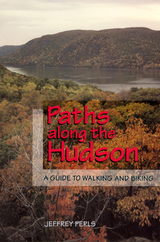 Paths Along The Hudson: A Guide to Walking and Biking
Perls, Jeffrey
Rutgers University Press, 1999 Whether you are an ardent hiker or prefer to enjoy the great outdoors from your living-room armchair, Jeffrey Perls has written the essential guidebook on one of the most majestic natural areas of the eastern United States-the Hudson River. From the rugged topography of the Hudson Highlands Gorge to the crowded towers of Manhattan, the Hudson has been an inspiration for poets, writers, artists, and countless others who have enjoyed the many wonders of the river. The area surrounding the Hudson abounds in history. It’s played a pivotal part in our country's development, from its strategic role in the American Revolution to its heritage as the nation’s primary entry point for immigrants to this country. The river also supports an incredibly rich diversity of flora and fauna, from the bald eagle to the short-nosed sturgeon. Perls brings together the culture, history, nature, and recreational activities along the Hudson River in one convenient guide book. He not only maps out walks and bike trails, both urban and rural, but also introduces readers to the landscape, geology, history, and culture of the Hudson Valley region. Perls provides a practical and geographically comprehensive guide to exploring the area on foot and by bike. The trail routes bring readers as close to the river as possible and guides them to rewarding vistas, nature preserves, and historic landmarks. It’s a useful guide for visitors to the Hudson region and local residents as it acquaints them to the natural treasures to be found in their own backyards.
Paths for Cuba: Reforming Communism in Comparative Perspective
Scott Morgenstern, Jorge Perez-Lopez, Jerome Branche
University of Pittsburgh Press, 2018 The Cuban model of communism has been an inspiration—from both a positive and negative perspective—for social movements, political leaders, and cultural expressionists around the world. With changes in leadership, the pace of change has accelerated following decades of economic struggles. The death of Fidel Castro and the reduced role of Raúl Castro seem likely to create further changes, though what these changes look like is still unknown. For now, Cuba is opening in important ways. Cubans can establish businesses, travel abroad, access the internet, and make private purchases. Paths for Cuba examines Cuba’s internal reforms and external influences within a comparative framework. The collection includes an interdisciplinary group of scholars from around the world to explore reforms away from communism.
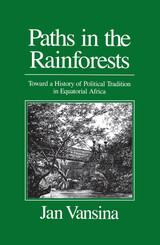 Paths in the Rainforests: Toward a History of Political Tradition in Equatorial Africa
Jan M. Vansina
University of Wisconsin Press, 1990 Vansina’s scope is breathtaking: he reconstructs the history of the forest lands that cover all or part of southern Cameroon, Gabon, Equatorial Guinea, the Congo, Zaire, the Central African Republic, and Cabinda in Angola, discussing the original settlement of the forest by the western Bantu; the periods of expansion and innovation in agriculture; the development of metallurgy; the rise and fall of political forms and of power; the coming of Atlantic trade and colonialism; and the conquest of the rainforests by colonial powers and the destruction of a way of life.
“In 400 elegantly brilliant pages Vansina lays out five millennia of history for nearly 200 distinguishable regions of the forest of equatorial Africa around a new, subtly paradoxical interpretation of ‘tradition.’” —Joseph Miller, University of Virginia
“Vansina gives extended coverage . . . to the broad features of culture and the major lines of historical development across the region between 3000 B.C. and A.D. 1000. It is truly an outstanding effort, readable, subtle, and integrative in its interpretations, and comprehensive in scope. . . . It is a seminal study . . . but it is also a substantive history that will long retain its usefulness.”—Christopher Ehret, American Historical Review
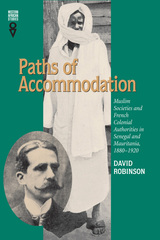 Paths of Accommodation: Muslim Societies and French Colonial Authorities in Senegal and Mauritania, 1880–1920
David Robinson
Ohio University Press, 2000 Between 1880 and 1920, Muslim Sufi orders became pillars of the colonial regimes and economies of Senegal and Mauritania. In Paths of Accommodation, David Robinson examines the ways in which the leaders of the orders negotiated relations with the Federation of French West Africa in order to preserve autonomy within the religious, social, and economic realms while abandoning the political sphere to their non-Muslim rulers.
This was a striking development because the local inhabitants had a strong sense of belonging to the Dar al-Islam, the “world of Islam” in which Muslims ruled themselves.
Drawing from a wide variety of archival, oral, and Arabic sources, Robinson describes the important roles played by Muslim merchants and the mulatto community of St. Louis, Senegal. He also examines the impact of the electoral institutions established by the Third Republic, and the French effort to develop a reputation as a “Muslim power”—a European imperial nation with a capacity for ruling over Islamic subjects.
By charting the similarities and differences of the trajectories followed by leading groups within the region as they responded to the colonial regimes, Robinson provides an understanding of the relationship between knowledge and power, the concepts of civil society and hegemony, and the transferability of symbolic, economic, and social capital.
Paths of Integration: Migrants in Western Europe (1880-2004)
Edited by Leo Lucassen, David Feldman, and Jochen Oltmer
Amsterdam University Press, 2006
In the 1990s, as concern grew in the United States about the integration of large numbers of immigrants, scholars searching for historical parallels looked to the last great period of immigration, ffrom 1880 to 1914. That example, however, is generally viewed as inapplicable to the current immigration debates in Europe.
Paths of Integration turns this conventional wisdom on its head, arguing that the history of European migration more closely parallels the U.S. experience than most realize, due to the largely ignored, but extensive, intra-European migration of the same period. By placing the European and U.S. examples side by side, the contributors to this volume offer long-term insights on a question that will be of great importance in the coming decades.
 Paths of Kateri's Kin
Christopher Vecsey
University of Notre Dame Press, 1998 Kateri Tekakwitha, the renowned Mohawk convert of the late 17th century, symbolizes for thousands of American Indian Catholics today their own two-part cultural identity. Indeed, many feel a profound spiritual kinship with her as they travel the paths of Native American Catholicism. The Paths of Kateri's Kin offers the first comprehensive study of the interweaving of Catholic and North American Indian ways from the French missionary days of the early 1600s through the complex tapestry of Indian Catholic spirituality alive today. These chapters take you down the many and various trails North American Indians have followed in expressing their Catholic identity and spirituality. Vecsey examines the fascinating dynamic between Catholic and Indian traditions in many tribal settings across North America and across nearly five centuries, always emphasizing the spiritual lives and practices of contemporary Native American Catholics.
Paths of Life: American Indians of the Southwest and Northern Mexico
Edited by Thomas E. Sheridan and Nancy J. Parezo
University of Arizona Press, 1996 This monograph marks the first presentation of a detailed Classic period ceramic chronology for central and southern Veracruz, the first detailed study of a Gulf Coast pottery production locale, and the first sourcing-distribution study of a Gulf Coast pottery complex.
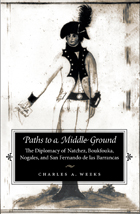 Paths to a Middle Ground: The Diplomacy of Natchez, Boukfouka, Nogales, and San Fernando de las Barrancas, 1791-1795
Charles A. Weeks
University of Alabama Press, 2005 Spanish imperial attempts to form strong Indian alliances to thwart American expansion in the Mississippi Valley. Charles Weeks explores the diplomacy of Spanish colonial officials in New Orleans and Natchez in order to establish posts on the Mississippi River and Tombigbee rivers in the early 1790s. Another purpose of this diplomacy, urged by Indian leaders and embraced by Spanish officials, was the formation of a regional Indian confederation that would deter American expansion into Indian lands.
Weeks shows how diplomatic relations were established and maintained in the Gulf South between Choctaw, Chickasaw, Creek, and Cherokee chiefs and their Spanish counterparts aided by traders who had become integrated into Indian societies. He explains that despite the absence of a European state system, Indian groups had diplomatic skills that Europeans could understand: full-scale councils or congresses accompanied by elaborate protocol, interpreters, and eloquent metaphorical language.
Paths to a Middle Ground is both a narrative and primary documents. Key documents from Spanish archival sources serve as a basis for the examination of the political culture and imperial rivalry playing out in North America in the waning years of the 18th century.
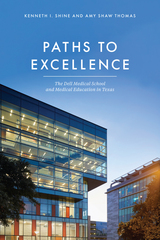 Paths to Excellence: The Dell Medical School and Medical Education in Texas
Kenneth I. Shine and Amy Shaw Thomas
University of Texas Press, 2021 For more than a century, medical schools and academic campuses were largely separate in Texas. Though new medical technologies and drugs—conceivably, even a vaccine instrumental in the prevention of a pandemic—might be developed on an academic campus such as the University of Texas at Austin, there was no co-located medical school with which to collaborate. Faculty members were left to seek experts on distant campuses. That all changed on May 3, 2012, when the UT System Board of Regents voted to create the Dell Medical School in Austin.
This book tells in detail and for the first time the story of how this change came about: how dedicated administrators, alumni, business leaders, community organizers, doctors, legislators, professors, and researchers joined forces, overcame considerable resistance, and raised the funds to build a new medical school without any direct state monies. Funding was secured in large part by the unique willingness of the local community to tax itself to pay for the financial operations of the school. Kenneth I. Shine and Amy Shaw Thomas, who witnessed this process from their unique vantages as past and present vice chancellors for health affairs in the University of Texas System, offer a working model that will enable other leaders to more effectively seek solutions, avoid pitfalls, and build for the future.
Paths to Power: Elite Mobility in Contemporary China
By David M. Lampton with the assistance of Yeung Sai-cheung
University of Michigan Press, 2000 Grappling with enduring questions about the means of achieving power in the Chinese Communist hierarchy, this study analyzes the rise of six individuals (Ji Dengkui, Peng Chong, Gu Mu, Yu Qiuli, Xu Shiyou, and Chen Xilian) who held positions of elite political power in the immediate post-Mao Zedong era. In a new preface, the author applies his hypotheses to China’s more recent political developments.
|
|
